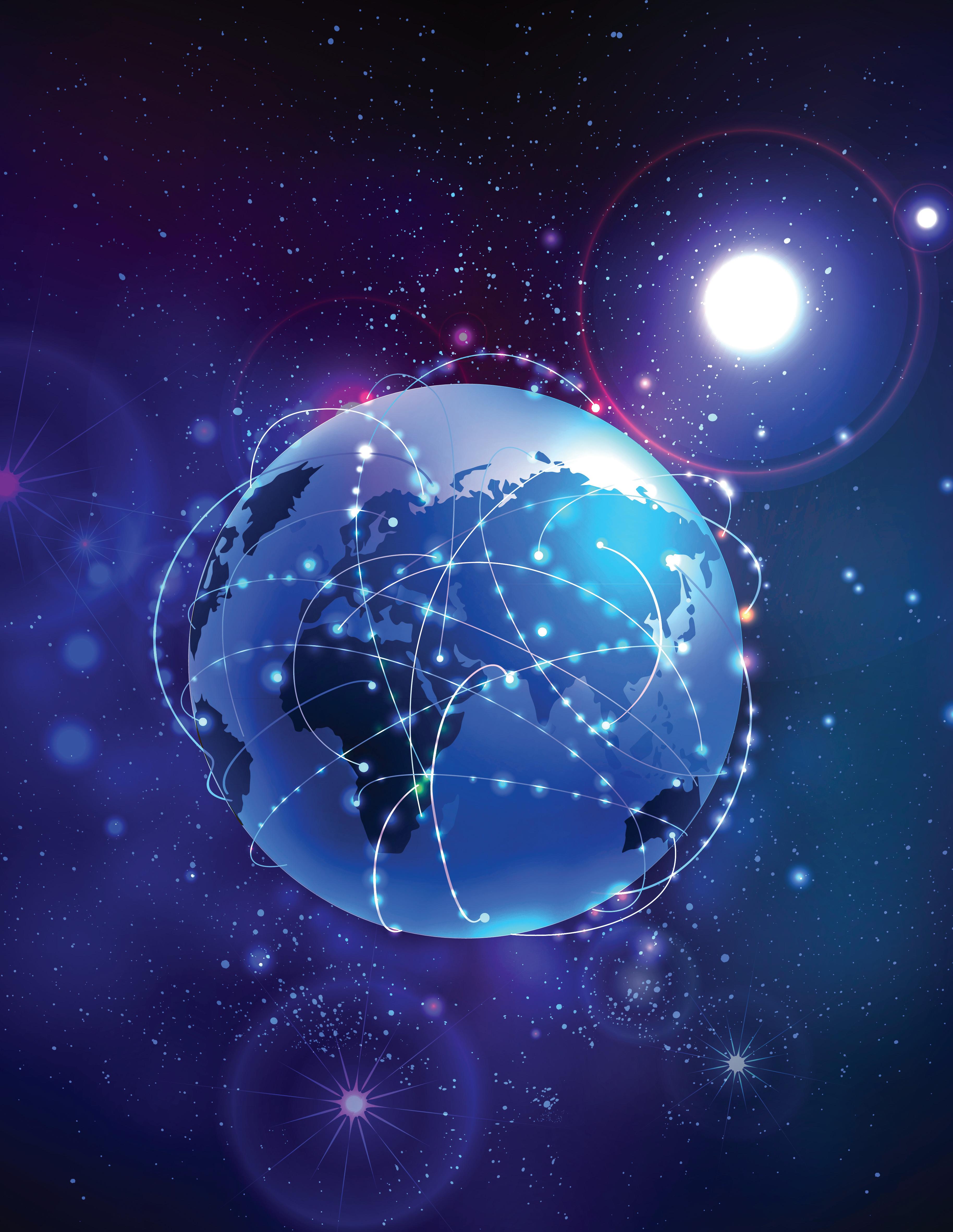
reportINDUSTRY 2022/2023 ISSUE 11
A Publication of Submarine Telecoms Forum, Inc. www.subtelforum.com ISSN No. 2640-4311
PRESIDENT & PUBLISHER: Wayne Nielsen | wnielsen@subtelforum.com | [+1] (703) 444-2527
VICE PRESIDENT: Kristian Nielsen | knielsen@subtelforum.com | [+1] (703) 444-0845
SALES: sales@subtelforum.com
EDITOR: Stephen Nielsen | snielsen@subtelforum.com
INDUSTRY REPORT AUTHORS: Rebecca Spence | rspence@subtelforum.com | [+1] (703) 268-9285 Kieran Clark | kclark@SubTelforum.com | [+1] (540) 533-6965
DESIGN & PRODUCTION: Weswen Design | wendy@weswendesign.com
CONTRIBUTING AUTHORS:
Alex Chase, George Ramírez, Greg Otto, Hunter Vaughan, Nicole Starosielski, and Phillip Pilgrim
REPORT VIDEO COMMENTATORS:
Alex Chase, Anders Ljung, Daniel Leza, George Ramírez, Greg Otto, Houlin Zhao, Julian Rawle, Kieran Clark, Mike Conradi, Rebecca Spence, and Rene D’Avezac de Moran
AUTHOR AND ARTICLE INDEX: www.subtelforum.com/onlineindex
Submarine Telecoms Forum, Inc. www.subtelforum.com/corporate-information
BOARD OF DIRECTORS: Margaret Nielsen, Wayne Nielsen and Kristian Nielsen
SubTel Forum Continuing Education, Division of Submarine Telecoms Forum, Inc. www.subtelforum.com/education
Contributions are welcomed and should be forwarded to: pressroom@subtelforum.com. Submarine Telecoms Forum Industry Report is published annually by Submarine Telecoms Forum, Inc., and is an independent commercial publication, serving as a freely accessible forum for professionals in industries connected with submarine optical fiber technologies and techniques. Submarine Telecoms Forum may not be reproduced or transmitted in any form, in whole or in part, without the permission of the publishers. Liability: While every care is taken in preparation of this publication, the publishers cannot be held responsible for the accuracy of the information herein, or any errors which may occur in advertising or editorial content, or any consequence arising from any errors or omissions, and the editor reserves the right to edit any advertising or editorial material submitted for publication.
New Subscriptions, Enquiries and Changes of Address: 21495 Ridgetop Circle, Suite 201, Sterling, Virginia 20166, USA, or call [+1] (703) 444-0845, fax [+1] (703) 349-5562, or visit www.subtelforum.com. Copyright © 2022 Submarine Telecoms Forum, Inc.
2 SUBMARINE TELECOMS INDUSTRY REPORT
VOICE OF THE INDUSTRY
CONTENTS Impressum 2 Exordium 8 Foreword: Thoughts From Houlin Zhao, ITU Secretary-General .................................................. 10 Methodology 12 1. GLOBAL OVERVIEW ......................................... 14 1.1 Industry Sentiment .......................................... 16 1.2 Phillip Pilgrim’s Look at Subsea Telecom Industry’s 150th Anniversary 22 1.3 System Growth 27 1.4 Out of Service Systems .................................. 31 1.5 Evolution of System Ownership and Customer Base 33 2. CAPACITY ........................................................ 36 2.1 Global Capacity ............................................. 38 2.2 Lit Capacity 40 2.3 Capacity Pricing: Perspectives of Alex Chase 44 3. OWNERSHIP FINANCING ANALYSIS ............. 46 3.1 Historic Financing Perspective 48 3.2 Regional Distribution of Financing 50 3.3 Current Financing .......................................... 52 4. SUPPLIER ANALYSIS ...................................... 54 4.1 Suppliers 56 4.2 Installers ........................................................... 58 4.3 Surveyors ......................................................... 62 4.4 Recent Mergers, Acquisitions, and Industry Activities 64 5. SYSTEM MAINTENANCE ................................ 68 5.1 Publicity ........................................................... 70 5.2 Reporting Trends and Repair Times 71 5.3 Club Versus Private Agreements 72 6. CABLE SHIPS ................................................... 74 6.1 Current Cable Ships 76 6.2 Shore-End Activity 79 7. MARKET DRIVERS AND INFLUENCERS ........ 80 7.1 Hyperscalers 82 7.2 Data Centers 85 8. SPECIAL MARKETS......................................... 90 8.1 Offshore Energy: Thoughts from Greg Otto 92 8.2 Unrepeatered Systems 98 8.3 Specialized Technologies 101 8.4 Sustainability in Subsea: Perspectives of George Ramírez, Nicole Starosielski, and Hunter Vaughan 103 9. REGIONAL ANALYSIS AND CAPACITY OUTLOOK ..................................... 106 9.1 Transatlantic Region 108 9.2 Transpacific Region 112 9.3 Americas Region 116 9.4 AustralAsia Region ....................................... 122 9.5 EMEA Region 128 9.6 Indian Ocean Region 134 9.7 Polar Region................................................... 138 Afterword ....................................................................... 142 Biographies of supporting authors 144 Works Cited 145 Table of SUBMARINE TELECOMS INDUSTRY REPORT 3
Video
Video
Video
4 SUBMARINE TELECOMS INDUSTRY REPORT Video 1: Wayne Nielsen, Publisher - Submarine Telecoms Forum, Inc. ............................................................................................ 8 Video 2: Houlin Zhao, Secretary-General - ITU................................................................................................................................. 10 Video 3: Rebecca Spence, Project Manager - Submarine Telecoms Forum, Inc. 12 Video 4: Julian Rawle, Principal - Julian Rawle Consulting 15 Video 5: Philip Pilgrim, Subsea Business Development Leader North America – Nokia .............................................................22 Video 6: Alex Chase, Senior Director - AP Telecom 36 Video 7: Daniel Leza, Vice President – TMG Telecom 48
8: Rene D’Avezac de Moran, Service Line Manager - Hydrography - Fugro ..................................................................... 62 Video 9: Mike Conradi, Partner – DLA Piper 64 Video 10: Greg Otto, Technical Director - WFN Strategies, LLC 92 Video 11: Anders Ljung, Sales Manager, Submarine Cable Systems – Hexatronic Cables & Interconnect Systems AB ......... 98 Video 12: George Ramírez, Research Assistant for Sustainable Subsea Network – SubOptic Foundation 103
13: Kieran Clark, Analyst – Submarine Telecoms Forum, Inc. 107
14: Kristian Nielsen, Vice President - Submarine Telecoms Forum, Inc. ............................................................................. 142 VIDEOSList of Table 1: Per-Message” Price Data 1866 to 1872 (Plotted in Figure 2 below) 23 Table 2: 1872 Cable Operators ............................................................................................................................................................... 25 Table 3: 1866 to 1872 Points of Interest 26 Table 4: Recent Multilateral Development Bank Projects 53 Table 5: Transatlantic Systems, 2012-Present....................................................................................................................................... 110 Table 6: Transatlantic Planned Systems 111 Table 7: Transpacific Systems, 2012-Present 114 Table 8: Transpacific Planned Systems ................................................................................................................................................. 115 Table 9: Americas Systems, 2012-Present 119 Table 10: Americas Planned Systems 120 Table 11: AustralAsia Systems, 2012-Present ....................................................................................................................................... 124 Table 12: AustralAsia Planned Systems 126 Table 13: EMEA Systems, 2010-Present 130 Table 14: EMEA Planned Systems ........................................................................................................................................................ 133 Table 15: Indian Ocean Systems, 2012-Present ...................................................................................................................................136 Table 16: Indian Ocean Planned Systems 137 Table 17: Polar 2010-Present 140 Table 18: Polar Planned Systems ........................................................................................................................................................... 141 TABLESList of
List of
FIGURES
Figure 27: Transpacific Capacity Growth, 2016-2020 42
Figure 28: Transpacific Capacity Growth, 2021-2025 42
Figure 29: Americas Capacity Growth, 2016-2020 42
Figure 30: Americas Capacity Growth, 2021-2025 43
Figure 31: Intra-Asia Capacity Growth, 2016-2020 43
Figure 32: Intra-Asia Capacity Growth, 2021-2025 43
Figure 33: Monthly Lease Pricing on Major Routes
45
Figure 34: Median 100G IRU Pricing on Major Routes 45
Figure 35: Financing of Systems, 2012-2022 49
Figure 36: Investment Distribution of Systems, 2012-2022
49
Figure 37: Distribution of MDB Investment, 2012-2022 50
Figure 38: Distribution of Debt/Equity Financed Investment, 2012-2022
51
Figure 39: Distribution of Self-Financed Investment, 2012-2022 51
Figure 40: System Investment, 2012-2022 52
Figure 41: System Deployment, 1992-2022
52
Figure 42: Regional Investment in Submarine Fiber Systems, 2018-2022 53
Figure 43: Number of Systems by Supplier, 2018-2022
56
Figure 44: KMS of Cable Produced by Supplier, 2018-2022 57
Figure 45: Planned Systems by Supplier, 2022-2025 57
Figure 46: Systems Installed by Company, 2018-2022
58
Figure 47: KMS Installed by Region, 2018-2022 59
Figure 48: Planned KMS by Region, 2022-2026 59
Figure 49: Systems Surveyed by Company, 2018-2022
63
Figure 50: Survey Status of Planned Systems, 2022-2026 63
Figure 51: Cable Fault Stories Per Region, 2014-2022 70
Figure 52: Total Cable Fault Stories, 2014-2022 70
Figure 53: Average Reported Repair Time in Days, 2014-2022 71
Figure 54: Traditional Club Agreements Map 72
SUBMARINE TELECOMS INDUSTRY REPORT 5 Figure 1: Worldwide Map of Submarine Cable 15 Figure 2: Overall State of the Industry 16 Figure 3: Market Activity ............................................................... 17 Figure 4: Project Status 17 Figure 5: Regional Activity 17 Figure 6: Work Status ..................................................................... 18 Figure 7: Industry Investment 18 Figure 8: Job Function of Surveyed 18 Figure 9: Purchasing Power of Surveyed 19 Figure 10: Years of Industry Experience 19 Figure 11: Location of Surveyed 19 Figure 12: Sir James Anderson 25 Figure 13: Plot of “Per-Message” Price Decline for the First Five Years of Transatlantic Cable Communications 26 Figure 14: Maximum Yearly Transatlantic Cable Revenue Assuming Fully Loaded 26 Figure 15: New System Count by Region, 2018-2022 27 Figure 16: KMS Added by region, 2018-2022 27 Figure 17: Planned Systems by Region, 2022-2025 28 Figure 18: Global Contract in Force Rate, 2022-2027 ............... 28 Figure 19: Decommissioned Systems 2002-2022 29 Figure 20: Projected System Maturity 2022-2032 32 Figure 21: Single vs Multiple Owner Cable Systems, 2012-2022 33 Figure 22: Single vs Multiple Owner Cable Systems, 2022-2025 33 Figure 23: Global Capacity Growth on Major Routes, 2018-2022 39 Figure 24: Planned Capacity Growth on Major Routes, 2023-2025 39 Figure 25: Transatlantic Capacity Growth, 2016-2020 41 Figure 26: Transatlantic Capacity Growth, 2021-2025 41
..................
.......
....................................................................
................................
.............
..............
............
(continued)FIGURESList of
Figure 55: Private Maintenance
56: Cable Ship Fleet
57: Cable Ships Added
58: Age Distribution
59: Cable
60: Landing Distribution by Region,
61: Landing Distribution
62: Systems Driven
63: Systems Impacted
Figure 64: Hyperscaler System
Hyperscalers,
Hyperscalers,
Figure 65: Systems Driven by Hyperscalers,
66: System Investment Driven by Hyperscalers, 2022-2025
Figure 67: Global Data Center
68: Enterprise Public Cloud
2022 (Flexera,
Figure 69: Enterprise Public Cloud
2020-2021 (Flexera,
70: World Liquid Fuels
Figure 71: Systems by Year, 2018-2025
72: KMs Added by Year,
73: Brent Crude Quarterly
74: Unrepeatered Systems
75: Unrepeatered Systems
Region,
Figure 81: Contract in Force – Transatlantic, 2022-2025 111
82: In-Service & Planned Systems –Transpacific, 2012-2025
114
Figure 83: Total KMs In-Service & Planned –Transpacific 2012-2025 115
Figure 84: Contract in Force – Transpacific, 2022-2025 115
Figure 85: In-Service & Planned Systems –Americas, 2012-2025 118
Figure 86: Total KMS In-Service & Planned –Americas, 2012-2025 118
Figure 87: Contract in Force – Americas, 2022-2025
118
Figure 88: In-Service & Planned SystemsAustralAsia 2012-2025 124
Figure 89: Total KMs In-Service & PlannedAustralAsia 2012-2025 126
Figure 90: Contract in Force – AustralAsia, 2022-2025 126
91: In-Service & Planned Systems - EMEA 2012-2025 130
92: Total KMs In-Service & Planned - EMEA 2012-2025 132
Figure 93: Contract in Force – EMEA, 2022-2025 132
Figure 94: In-Service & Planned Systems - Indian Ocean 2012-2025 136
Figure 95: Total KMs In-Service & Planned - Indian Ocean 2012-2025 137
Figure 96: Contract in Force - Indian Ocean, 2022-2025
137
97: In-Service & Planned Systems - Polar 2012-2025 140
Figure 98: Total KMs In-Service & Planned - Polar 2012-2025
140
Figure 99: Contract in Force – Polar 2022-2025 141
6 SUBMARINE TELECOMS INDUSTRY REPORT
Agreements Map 73 Figure
Distribution by Company 76 Figure
by Year, 2002-2022 ................... 77 Figure
of Cable Ship Fleet 77 Figure
Ship Activity 78 Figure
2018-2022 ............ 79 Figure
by Region, 2022-2026 79 Figure
by
2018-2022 82 Figure
by
2018-2022 ....... 83
Ownership Distribution 84
2022-2025 84 Figure
84
Clusters 85 Figure
Provider Usage,
2022) ...................................................................... 86
Provider Adoption Rate,
2022) 86 Figure
Production and Consumption Balance 2017-2023 ................................................. 93
93 Figure
2018-2025 94 Figure
Price History, 2018-2022 ..... 94 Figure
by Year, 2018-2022 99 Figure
by
2018-2022 99 Figure 76: Unrepeatered KMS by Year, 2018-2022.................. 100 Figure 77: Unrepeatered Investment by Region, 2018-2022 100 Figure 78: Unrepeatered Planned Systems by Region, 2022-2025 100 Figure 79: In-Service & Planned Transatlantic Systems, 2012-2025 110 Figure 80: Total KMs In-Service & Planned –Transatlantic, 2012-2025 ................................................................ 111
Figure
.................................................................
...............
Figure
Figure
........
Figure
.......................................................................................
List of
ACRONYMS
ACRONYMS DESCRIPTION
2OCMA 2 Oceans Cable Maintenance Agreement
ACMA Atlantic Cable Maintenance Agreement
ANACOM Autoridade Nacional de Comunicações
APMA The Atlantic Private Maintenance Agreement
APMMSA Asia Pacific Marine Maintenance Service Agreement
ASN Alcatel Submarine Networks
CAGR Compound Annual Growth Rate
CIF Contract in Force
CWDM Coarse Wavelength Division Multiplexed
DFC United States Indernational Development Finnacne Corporatoin
DWDM Dense Wavelength-Division Multiplexing
EMEA Europe, the Middle East, & Africa
EOS End of Service
FCC Federal Communications Commission
FP Fibre Pairs
GDP Gross Domestic Product
HMN Huawei Marine Services
HS Hyperscaler
ICPC International Cable Protection Council
ICT Information and Communications Technology
IFC International Finance Corporation
IOT Internet of Things
IRU Indefeasible rights of use
ITU International Telecoms Union
KMS Kilometers
LTE Long-Term Evolution
MDB Multilateral Development Banks
ACRONYMS DESCRIPTION
MECMA Mediterranean Cable Maintenance Agreement
MPLS Multiprotocol Label Switching
MW Megawatt
NAZ North American Zone Cable Maintenance Agreement
OOS Out of Service
OPEC Organization of the Petroleum Exporting Countries
OTEC Ocean thermal energy conversion
OTT Over-the-top
RFS Ready for Service
SCIG Submarine Cable Improvement Group
SDM Spatial Division Multiplexing
SEAICMA Southeast Asia / Indian Ocean Cable Maintenance Agreement
SMART Scientific Monitoring and Reliable Telecommunications
SPMA South Pacific Maintenance Agreement
SSN Sustainable Subsea Networks
SWAC Seawater Air Conditioning
UN United Nations
UNCTAD United Nations Conference on Trade and Development
UNESCO Intergovernmental Oceanographic Commission
USD United States Dollar
USV Uncrewed Surface Vessel
VSAT Very-small-aperture terminal
WDM Wavelength-Division Multiplexing
WIOCC West Indian Ocean Cable Company
WMO World Meteorological Organization
SUBMARINE TELECOMS INDUSTRY REPORT 7
EXORDIUM
Welcome to the 11th edition of SubTel Forum’s annual “Submarine Telecoms In dustry Report,” which was authored by our analysts without whom this report would not be possible.
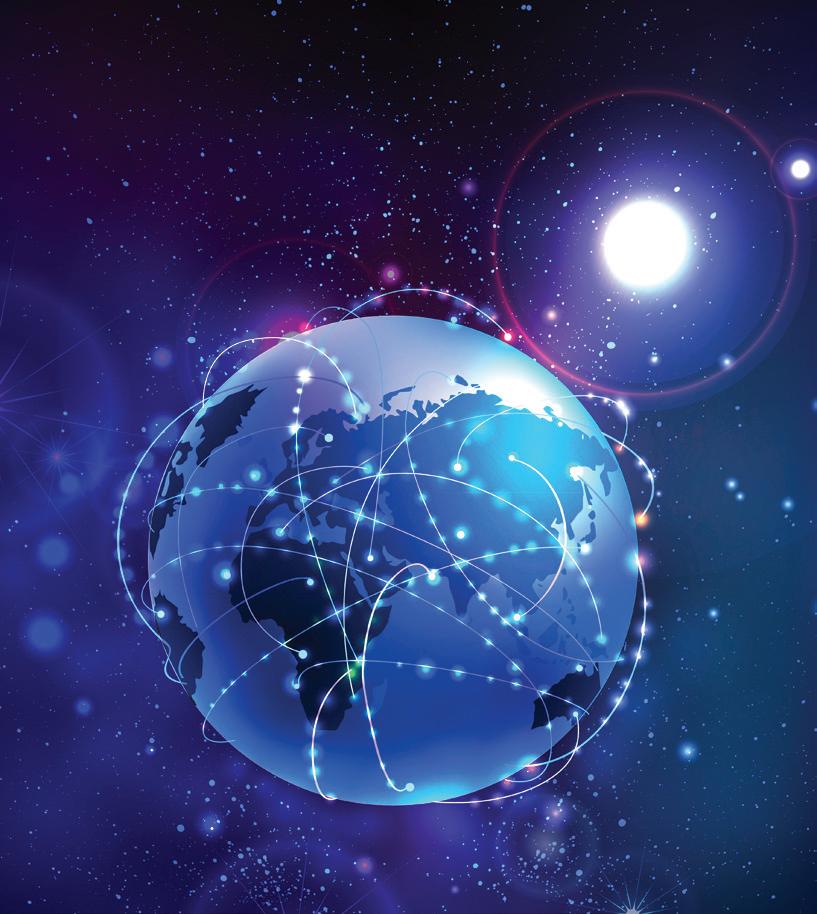
2022 has turned into a year few would have seen coming. The world survived COVID-19 only to be thrown into a major war in Europe, the likes of which we have not felt since 1945. And in spite of this state sponsored craziness, our industry continues on its busy pace to connect all of the world, and this year was no exception. As such, we have witnessed new submarine cables just about every where, including major transoceanic routes. Our industry has much of which to be proud.
11TH ANNUAL INDUSTRY REPORT – A SNAPSHOT
At SubTel Forum, we continually strive for our annual Industry Report to serve as an analytical resource with in the trio of our products of Submarine Cable Map published every January, Submarine Cable Almanac published quarterly, and online Submarine Cables of the World Interactive Map. The Submarine Telecoms Industry Report features in-depth analysis and forecasts of the submarine cable industry and hopefully serves as an invaluable resource for those seeking to comprehend the health of the submarine industry. It strives to exam ine both the worldwide and regional submarine cable markets; including issues such as the new-system and upgrade supply environments, ownership, financing, mar ket drivers, and geopolitical/economic events that may impact the market in the future.
The presentation of the annual Industry Report draws upon the highly successful formatting of our Submarine Telecoms Forum Magazine as inspiration, as well as in cludes again personal video commentaries from multiple industry representatives from around the world. The goal is for the Industry Report to be read online or download ed for browsing elsewhere. As such, we have attempted to make a significant, encompassing view of the submarine fiber industry available to you – our readers.
Last year’s report was downloaded more than 500 thousand times and was quoted by numerous business journals and periodicals. We are optimistic, yet confident that this year’s edition stands up to the same scrutiny. We hope you will agree.
In this annual Industry Report, we have identified more than $15.2 billion in new projects that are being actively pur sued by their developers. Of those, some $7.3 billion worth are executed contract-in-force, and $2.5 billion of those new, contract-in-force systems are slated for 2023 alone.
8 SUBMARINE TELECOMS INDUSTRY REPORT
Video 1: Wayne Nielsen, Publisher - Submarine Telecoms Forum, Inc.
SURVEY OF INDUSTRY SENTIMENT
We recently accomplished our annual industry senti ment survey, the results of which are highlighted in this Industry Report. We believe these results are a barometer, albeit imperfect, of future industry activity, as well as provide an understanding of how participants feel about their role in the industry.
THANKS TO AUTHORS, COMMENTATORS AND ADVERTISERS
We are thrilled once again that the Secretary-Gener al of the International Telecommunication Union, Mr. Houlin Zhao, provided this year’s foreword and accompa nying video commentary, discussing the state of the ITU, the advent of climate-conscious cables, and the organiza tion’s submarine cable related initiatives.
We utilized insights from a number of articles from recent issues of Submarine Telecoms Forum Magazine and our proprietary Market Sector Reports, where neces sary, allowing us to better discuss various industry topics. Thanks especially to Phillip Pilgrim for providing again this year’s industry history section, Alex Chase for his insights on Capacity Pricing, Greg Otto for his expertise on Oil & Gas systems, and George Ramírez, Nicole Sta rosielski, and Hunter Vaughan for their perspectives on various subsea sustainability initiatives. We also received some excellent video commentary from several industry super stars, including:
• Alex Chase, Senior Director - AP Telecom
• Anders Ljung, Sales Manager, Submarine Cable Sys tems – Hexatronic Cables & Interconnect Systems AB
• Daniel Leza, Vice President – TMG Telecom
• George Ramírez, Research Assistant for Sustainable Subsea Network – SubOptic Foundation
• Greg Otto, Technical Director - WFN Strategies, LLC
• Houlin Zhao, Secretary-General - ITU
• Julian Rawle, Principal - Julian Rawle Consulting
• Kieran Clark, Analyst – Submarine Telecoms Forum, Inc.

• Mike Conradi, Partner – DLA Piper

• Rebecca Spence, Product Manager - Submarine Telecoms Forum, Inc.
• Rene D’Avezac de Moran, Service Line ManagerHydrography - Fugro
We would also like to say a special thank you to this year’s sponsors as below who helped make the annual Industry Report possible, namely:
• APTProcure
• Fugro
• Hexatronic Cables & Interconnect Systems AB
• Mertech Marine
• Southern Cross Cable Networks
• WFN Strategies
CLOSING THOUGHTS
While the crystal ball will rarely be completely clear, one fact remains – that our more than 175-year-old in ternational enterprise continues to be a thriving, essential and ever-evolving industry.
In the coming months, we will continue to strive to make available as much new data as possible in a timely and useful fashion – as we say, an informed industry is a productive industry.
Thank you as always for honoring us with your interest in SubTel Forum’s 11th annual “Submarine Telecoms Industry Report.”
With closing thoughts on the situation in Ukraine, let me quote Churchill’s marvelous words: “This is not the end, this is not even the beginning of the end, this is just perhaps the end of the beginning.” In a world full of Putins, be a Zelenskyy. #Ukraine

Good reading and stay safe, ■
WAYNE NIELSEN is Publisher & President of Submarine Telecoms Forum, Inc. and possesses more than 35 years’ experience in submarine cable systems, including polar and offshore Oil & Gas submarine fiber systems, and has developed and managed international telecoms projects in Antarctica, the Americas, Arctic, Europe, Far East/Pac Rim and Middle East. In 2001, he founded Submarine Telecoms Forum magazine, the industry’s considerable voice on the topic. He is also Managing Director of WFN Strategies, which provides design, development, and implementation support, as well as commercial and technical due diligence of submarine cable systems for commercial, governmental, and Oil & Gas clients. He received a postgradu ate master’s degree in International Relations, and bachelor’s degrees in Economics and Political Science, and is a former employee of British Telecom, Cable & Wireless and SAIC.
SUBMARINE TELECOMS INDUSTRY REPORT 9
FOREWARD
THOUGHTS FROM HOULIN ZHAO, ITU SECRETARY-GENERAL
The Submarine Telecoms Indus try Report shares a wide variety of perspectives to offer a global view of the latest developments in the industry and expectations for its future. This is an objective that the International Telecommunication Union (ITU) is pleased to support as the United Nations specialized agency for information and commu nication technologies (ICTs).
Our global membership includes 193 Member States and over 900 companies, universities, and inter national and regional organizations working together to connect the world and ensure that our intercon nections make meaningful contribu tions to society.

ITU’s international standards have supported the submarine telecoms industry from its very beginnings and the industry is now contributing to standard ization work that could enable submarine cables to provide an even greater service to the public interest than they do today.
CLIMATE-CONSCIOUS CABLES
Submarine cables have the potential to form a realtime ocean observation network able to provide accurate early warnings of tsunamis and a wealth of valuable data for climate science.
A standard SMART cable – a submarine telecoms cable upgraded for “Scientific Moni toring And Reliable Telecommunications” – will include climate and hazardmonitoring sensors designed to coexist with telecom components and match the lifespan of commercial cables.
Two new ITU standards are under development in ITU-T Study Group 15 to provide for both SMART cables (work ing name G.smart) and cables ded icated to scientific sensing (working name G.dsssc). The upcoming standards will also be reflected by revisions to existing ITU standards.
SMART cables will include a minimum set of three sensors in cable repeaters to measure ocean bottom temperature as an indicator for climate trends; pressure for sealevel rise, ocean currents, and tsunamis; and seismic acceleration for earth quake detection and tsunami alerts.
This ITU standardization work builds on min imum requirements established by the Joint Task Force on SMART Cable Systems, formed in 2012 with the support of ITU, the UNESCOInt ergovernmental Oceanographic Commission (UNESCOIOC) and the World Meteorological Organization (WMO).
The Joint Task Force has helped develop the techni
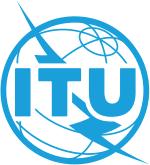
10 SUBMARINE TELECOMS INDUSTRY REPORT
Video 2: Houlin Zhao, Secretary-General - ITU
cal and financial feasibility of SMART cables and now works closely with United Nations organizations, gov ernments, and businesses intent on deploying SMART cables at scale.
ITU’s support for the project stems from our technical expertise in submarine telecoms, our commitment to the United Nations Sustainable Development Goals, and our membership’s ability to stimulate progress on issues at the intersection of government, industry, and academia.
Our standardization work will support globally harmo nized development, implementation, and operation of these systems, as well as create the conditions necessary to make use of all the data generated by the envisaged ocean-observation network.
BUILDING MOMENTUM
Two years ago, Alcatel Submarine Networks became the first cable provider to commit to SMART, while Portugal’s telecom regulator ANACOM pledged to build SMART into the new CAM [ContinentAzoresMadeira] ring cable connecting the mainland to islands a thousand kilometers out in the Atlantic Ocean.
The submarine cable division of NEC Japan has installed more than 6000 kilometers of submarine cables dedicated to scientific sensing, which are now operated by Japan’s National Research Institute for Earth Science and Disaster Resilience. The first submarine cables for tsunami forecasts were deployed 12 years ago, and the network was expanded after the 2011 Great East Japan Earthquake — but without supporting commercial tele coms in parallel.
EllaLink, the BrazilPortugal transAtlantic cable system, was the first to dedicate a fibre of a commer cial telecoms cable to environmental sensing, between Madeira Island and the trunk cable. Portugal now plans to include fullfledged SMART capability in the new 3700-kilometre CAM cable ring.
SMART capability will form around 10 per cent (EUR 12 million, or about USD 13 million) of the total cost to deploy the new governmentsponsored CAM cable. Expected to enter service in 2025, the cable will set valuable precedents for similar systems around the world.
Looking ahead, the Joint Task Force calculates that the deployment of three SMART cables of a scale equivalent to CAM each year would result in our ocean floors host ing 2000 new SMART cable repeaters every 10 years.
The Joint Task Force adds that SMART capability does not impact the cost of cable operation and mainte nance. It also urges that its upfront costs are considered in view of the lives that could be lost to tsunamis and the costs to recover from those disasters.
Other SMART projects are in various stages of plan ning and development in Indonesia, the Vanuatu–New Caledonia island area, and connecting to Antarctica and crossing the Arctic connecting Europe and Asia.
The project between Vanuatu and New Caledonia –supported by the Joint Task Force with funding from the Gordon and Betty Moore Foundation – will play a pivot al part in creating an enduring science and early-warning ecosystem in the region and inspiring government and industry confidence in the SMART cable concept.
CONTRIBUTIONS WELCOME
In addition to SMART cables and cables dedicated to scientific sensing, ITU-T Study Group 15 is also working towards new ITU standards for Space Division Multi plexing (SDM).
A soon-to-be-published ITU technical report on optical fibre, cable and components for SDM transmis sion considers proposed SDM applications and clarifies technical and commercial aspects of SDM. It establishes a roadmap towards future ITU standards supporting a cost-effective network and ecosystem utilizing SDM fibre and cable technologies.
The ITU standardization process ensures that all participants’ voices are heard. Our work is driven by your contributions and consensus decisions. We offer reduced membership fees for academia, start-ups and small and medium-sized enterprises, and companies of all sizes in developing countries.
The ITU platform continues to grow in value, to a growing number of stakeholders, and I encourage you to join our global community. ■
HOULIN ZHAO was first elected 19th Secretary-General of the International Telecommunication Union at the Busan Plenipotentiary Conference in October 2014. He took up his post on 1 January 2015. ITU Member States reelected Houlin Zhao as ITU Secretary-General on 1 November 2018. He began his second four year term on 1 January 2019. Prior to his election, he served two terms of office as ITU Deputy Secretary-General (2007-2014), as well as two terms as elected Director of ITU’s Telecommunication Standardization Bureau (1999-2006).
Houlin Zhao is committed to further streamlining ITU’s efficiency, to strengthening its membership base through greater involvement of the academic community and of small- and medium-sized enterprises, and to broadening multistakeholder participation in ITU’s work.

SUBMARINE TELECOMS INDUSTRY REPORT 11
METHODOLOGY
This edition of the Submarine Telecoms Cable Industry Re port was authored by the an alysts at Submarine Telecoms Forum, Inc., who provide submarine cable system analysis for SubTel Forum’s Submarine Cable Almanac, online and print Cable Maps and Industry Newsfeed.

For the Submarine Cable Industry Report, we utilized both interviews with industry experts and our proprietary Submarine Cable Database which was purpose-built by Submarine Telecoms Forum in 2013 and regularly updated since.
The database tracks more than five hundred current and planned do mestic and international cable systems, including project in formation suitable for querying by client, year, project, region, system length, capacity, landing points, data centers, owners, installers, system cost, upgrade status, etc. The Submarine Cable Database is purpose-built by a dedicated database administration team and powered by MySQL. Maps are produced with ArcGIS Pro, in the same format and visual style as the Submarine Cables of the World print map.
To accomplish this report, SubTel Forum conducted continuous data gathering throughout the year. Data as similation and consolidation in its Submarine Cable Da tabase was accomplished in parallel with data gathering efforts. SubTel Forum collected and analyzed data from a variety of public, commercial, and scientific sources to best analyze and forecast market conditions.
For capacity growth, two different ways of determining Compound Annual Growth Rate (CAGR) are used. The first method calculates a CAGR for a given period – e.g., a CAGR for the period 2018-2022. The second method calculates a rolling two-year CAGR to minimize extreme variance while also showing a useful year-to-year growth comparison. From 2019 onwards, publicly reported data has been less comprehensive due to adjusted FCC report
ing requirements, so modeling had to be used to approx imate capacity growth. The average growth rates from 2015-2018 were applied to determine capacity growth numbers for 2019 and beyond.
For unrepeatered systems analysis, a maximum cable length of 250km with a couple of exceptions made for systems that have been publicly announced as unrepeated were applied to the database to determine which cable systems to consider as unrepeatered.
Trending is accomplished using known data with lin ear growth estimates for the following three years.
While every care is taken in preparation of this report, these are our best estimates based on information provid ed and discussed in this industry.
We hope you enjoy the Submarine Telecoms Cable Industry Report. ■
REBECCA SPENCE is the Product Manager from Submarine Telecoms Forum. Rebecca possessed more than 10 years’ experience as an analyst and database manager, including for the small business division of prominent government contractor, General Dynamics IT. She is a regular contributor to SubTel Forum Magazine and is based out of Hillsborough, North Carolina USA.

12 SUBMARINE TELECOMS INDUSTRY REPORT
Video 3: Rebecca Spence, Project Manager - Submarine Telecoms Forum, Inc.
play for offshore wind.
STAY
Climate Change
While the telecom industry has been operating for quite some time and has made significant advances in our knowledge of benthic marine environments, climate change is one issue that we will have to face in conjunction with all offshore maritime industries and the wider world. The push for projects concerning environmental monitoring and communications is spreading throughout the industry, with a current focus on issues relating to marine megafau na and fisheries targets. Initiatives such as SMART cables and similar monitoring systems in offshore wind will go a long way towards narrowing existing knowledge gaps and ensuring that we have lengthy and reliable data records as our seas undergo this period of immense change.
As mentioned previously, interdisciplinary initiatives such as ROSA will be integral in encouraging data sharing and data tracking as some common fisheries and conserva tion target species exhibit spatial and temporal distribution shifts. By working together, industry and local stakeholders can broaden our collective knowledge of how the oceans around us will be impacted by climate change related phe nomena. As such, we can hope to mitigate issues to the best of our abilities and focus on nurturing sustainable growth of both telecom and offshore wind industries, keeping the world connected and providing reliable sources of clean, renewable wind energy. Similarly, collective knowledge on natural system faults, both for subsea cables and offshore wind infrastructure, will contribute to our understanding of how best to shift future engineering and operation innova tions to cope with an increase in strength and frequency of inclement weather events and other climatic factors.
Summary
Throughout both industries, a common theme is the importance of early and continued stakeholder engage ment. “We stand by the idea that stakeholder engagement and outreach with other maritime users and operators is incredibly important,” Ryan Wopschall, ICPC GM states, “Raising awareness of subsea cables within the offshore renewable energy sector and encouraging developers and stakeholders to contact us in regard to new and ongoing projects will further facilitate safe and efficient use of ma rine resources and long-term protection of seabed infra structure.” All marine users must be considered throughout project development, and these considerations, alongside those of public perceptions, will help to pave the way for
community buy-in and long term success of these installa tions.
In the past century and a half, humans have come to understand a significant amount about our oceans and how they function. Through the course of hundreds of subsea cable installations, the telecom industry has been at the forefront of uncovering benthic knowledge. Our under standing of seafloor hydrology, shifting sediments, ecolog ical interactions, and even earthquakes and tsunamis has greatly increased. By taking what we have learned and ap plying it to the burgeoning offshore wind industry, we can best position ourselves to reap the rewards of an extensive renewables network while mitigating social, environmental, and ecological impacts. We have extensive local fisheries and communities networks, professional guard vessels and crews, broad knowledge of the marine environmental and applicable requirements and legislation, and, above all, we have a vision for long-term, sustainable success in harness ing our renewable natural resources for clean energy. To our partners in the offshore wind industry— we are ready and willing to help you reach your goals.
Emma Martin is the Marine Systems Associate at Seagard. She has her BA in Biology from Boston University, USA and her MSc in Marine Systems and Policies from the University of Edinburgh, Scotland. She has performed marine field work around the world and looks forward to continuing to support maritime infra structure developments.

SUBMARINE TELECOMS INDUSTRY REPORT 13
CURRENT FOLLOW US ON SOCIAL MEDIA @subtelforum @subtelforum subtel-forumSubTelForum
GLOBAL OVERVIEW
14 SUBMARINE TELECOMS INDUSTRY REPORT 1
SUBMARINE TELECOMS INDUSTRY REPORT 15
Figure
1:
Worldwide Map of Submarine Cable
INDUSTRYSentiment
SubTel Forum accomplished our annual industry senti ment survey in Q3 2022 with the goal of highlighting re sults in the Industry Report. This survey was accomplished over the course of multiple weeks and advertised in Submarine Telecoms Forum Magazine and other publi cations, as well as in social media.
Questions asked related to responder perceptions of the overall state of the industry, market activity, status of projects and work, regional activity, and levels of industry investment. Over 100 responses were received from read ers in the Americas, Asia-Pacific, and EMEA. Responders included senior and middle management, as well as submarine telecoms engineers and technicians, and the vast majority of responders possessed 20 or more years’ experience in our industry.
Their sentiments of the submarine cable industry are interesting reading.
The overall state of the indus try is resoundingly optimistic, with the categories of very pes simistic, pessimistic and neutral not even being selected by our survey responders. (Figure 2) As compared to last year, the very optimistic category has seen a roughly 15% increase, showing a very positive perspective of the industry as of late.
Following the trend of optimism in the industry, most respondents have seen an in

crease in their perception of the market’s activity. (Figure 3) More than half of responders have experienced or seen an increase in work since last year.
With the increase in work, comes inevitable slow down due to longer queues for work. Since last year, responders have observed a nearly 20% increase in project delays, while the cat egory of “significant delay” has decreased. (Figure 4)
The EMEA region remains the powerhouse of the industry, especially with projects such as 2Africa and Sea-Me-We 6 taking up much of the indus try’s attention. There have been increases in other regions, such as AustralAsia and Transpacific; these can be attributed to new routes being explored in these

16 SUBMARINE TELECOMS INDUSTRY REPORT
Very Optimistic (36%) Optimistic (64%) FIGURE 2: OVERALL STATE OF THE INDUSTRY
1.1
Video 4: Julian Rawle, Principal - Julian Rawle Consulting
(Figure 5)
While the shadow of COVID-19 has been lifting slowly from the industry, its effects are still far reaching. Most responders are still working remotely and have seen their travel limited. (Figure 6)
While the industry appears to be booming, our survey
responders have observed a slight cooling of investment since this poll was taken a year ago. The industry appears to remain at near average levels of investment; however, the “below average” category has seen a near 15% increase from last year. (Figure 7)
OF THE INDUSTRY
4:


5:

SUBMARINE TELECOMS INDUSTRY REPORT 17 GLOBAL OVERVIEW | INDUSTRY SENTIMENT RESPONDER SENTIMENT
Significantly More Work More Work No Change Less Work Significantly Less Work FIGURE 3: MARKET ACTIVITY 7% 22% 7% 7% 57% Polar Indian Ocean Pan-East Asian EMEA AustralAsia Americas Transpacific Transatlantic 12% 6% 6% 17% 6% 18% 35% FIGURE
REGIONAL ACTIVITY No Delay Significant Delay Some Delay FIGURE
PROJECT STATUS 57% 14% 29% regions.



18 SUBMARINE TELECOMS INDUSTRY REPORT Above Average Below Average Average FIGURE 7: INDUSTRY INVESTMENT 14% 57%29% Other Middle Management Engineer, or other Technical Duties Senior Management FIGURE 8: WHAT IS YOUR JOB FUNCTION? 14% 21% 21% 36% My travel has been cancelled Increased travel time to accommodate quarantine My travel has been limited I am working remotely FIGURE 6: WORK STATUS 29% 38% 28% 6%


SUBMARINE TELECOMS INDUSTRY REPORT 19 20+ Years 16-20 Years 11-15 Years 7-10 Years 4-6 Years 65% 7% 14% 7% 7% FIGURE 10: HOW MANY YEARS HAVE YOU BEEN IN THE INDUSTRY? Asia/Pacific Africa/Middle East Europe South America North America FIGURE 11: WHERE DO YOU RESIDE? 14% 14% 14% 22% 36% Recommendation and No Influence Recommendation and Little Influence Recommendation and High Influence Final Decision Maker FIGURE 9: WHAT IS YOUR PURCHASING POWER IN YOUR ORGANIZATION? 28% 36% 7% 29% GLOBAL OVERVIEW | INDUSTRY SENTIMENT


Perhaps the first industry report for the subsea sector is contained in the report: Statistics of Telegraphy; written by Sir James Ander son and presented to the Statistical Society (of London) in June 1872. Sir Andersen provides data and analysis for the “first 20 years” of Telegraphy.
This report is similar in nature to those currently published by Submarine Telecoms Forum, Tele Geography, Pioneer Consulting, SubCable News, Terabit Consult ing, Capacity Magazine and others I may have missed. It contains data on traffic, capacity, submarine ca bles in operation, routes, technolo gy, and of course information on the subsea operators. A gem in this report is a summary of the causes of cable failures that parallels the recent works of the Submarine Cable Improvement Group (SCIG).
The 1872 report covers far more ground than just sub sea. It includes statistics on terrestrial “International” traf fic between countries as well as “Internal” traffic within countries. In particular there is detailed information for the United Kingdom, Belgium, Switzerland, and Egypt.
For this article, I have chosen to select a few sections of the 1872 report, related to submarine telecommunica tions, and update the currency value references to modern values. Hopefully this and the addition of a few tables and graphs will convey that not much has changed over the past 150 years.
Before we begin this journey back in time, many

thanks to Google for digitizing these books that are now windows through time: Reference: https://www.google.ca/books/edition/Statistics_ of_Telegraphy/xnPNAAAAMAAJ
Note: Telegraph communications of the past, predated voice (Telephone) communications. Telegraphic messages were much like today’s text messages, but you had to pay for each message.
PREFACE
A most wise excerpt snipped from Sir James Ander son’s Preface: “Although the Telegraph has been twenty years
22 SUBMARINE TELECOMS INDUSTRY REPORT
Video 5: Philip Pilgrim, Subsea Business Development Leader North America – Nokia
PHILLIP PILGRIM’S 1.2 LOOK AT SUBSEA TELECOM INDUSTRY’S 150TH ANNIVERSARY
in general use, it is still a comparatively new power, startling in its effects even yet, and so much a part of the Imperial, commercial, and social system of every civilized nation, that it be maintained and extended; cost what it may, it can never be abandoned.”
ATLANTIC TELEGRAPHY
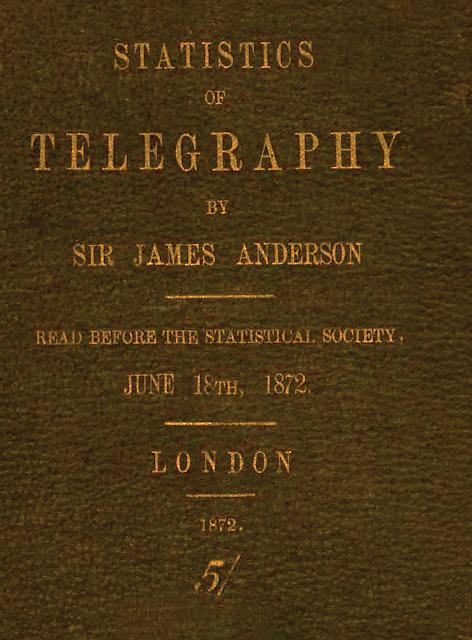
There are many, and sufficient reasons which render it inexpe dient on my part to publish all the details of private companies which are open to me, and. have been well considered with the desire to find material of some practical value for this paper.
It must be sufficient for the present to prove that even under the most favourable conditions for international telegraphy the world can produce there is no exception to the rule, “That a reduction of tariff leads to a diminution of the net product.”
The actual earnings of the Atlantic Telegraph Compa nies from 28th July, 1866, to 31st December, 1871, were $303,636,060.
Assuming the tariff to have remained at $1,796 [per message] (the mean for the first 11 months), and the traffic to have increased annually at the rate of 12.5%, the gross
earnings would have amounted to $352,167,480. Differ ence in favour of $ 1,796 tariff: $48,531,420. Add—Ex penses which would not have been incurred: $3,566,420
The above statement assumes the mean tariff for the first twelve months to be maintained, and 12.5 per cent.
as the normal rate of increase of traffic for each year, an increase which would only have pro duced an average of 114 mes sages per day for the year ending December, 1871, less than onefourth of the real traffic, and a number so low that no one can suppose it would not have been attained even with the tariff at $2,797 per message.

Could the high tariff have been maintained, one cable would have sufficed for the limited traffic, all the capital and working expenses of the French Atlantic Cable would have been saved, and the Anglo-American Company would now be enjoy ing 27 per cent. dividend upon a capital of $234,265,500.
If, then, this small number of messages would have yielded a larger revenue than the greater number with the series of reduced tariffs given above; it follows that some other motives than cheapness must prevail to induce any pri vate company to reduce their tariff.
These motives have hitherto been expediency, compe tition, and the attempt to combine and stave off further opposition; and we shall probably see reproduced the experience of the competing Land Lines in this country already referred to:
“One or more will be ruined or forced to amalgamate; higher tariff will be resorted to in order to preserve good dividends with a large reserve, and further extensions will be avoided.”
We have already three Atlantic Cables laid and in good working order, represented by a capital of $513,985,500.
There two additional cables projected, one to be laid by the French Atlantic Company at a cost of $125,874,000, and another by the Great Western Telegraph Company, whose capital is $188,811,000 making together $314,685,000. Total [5 cables] $828,670,500.
The revenue earned by the Atlantic Cables, including the Newfoundland Company’s proportion, amounted, as far as can be ascertained from the published accounts of the Companies for the year 1871, to $85,314,600. During
SUBMARINE TELECOMS INDUSTRY REPORT 23
Table
1:
“Per-Message” Price Data 1866 to 1872
GLOBAL OVERVIEW | PHILLIP PILGRIM
the first six months of that year a $420 tariff was in force, and during the last six months $280 was charged. Taking the mean rate of $350. We can assume that 245,000 messages were sent.
From existing data, we can say that the normal increase of traffic may be estimated at 25 per cent., which would give a total of 306,250 messages for the current year, and 382,812 for 1873.
The effect of lowering the tariff from $280 to $140 will probably be to increase the number of messages 75 per cent. In the first year after the reduction.
As the two new cables cannot be laid until after the lapse of the first six months of next year, we may estimate the num ber of messages for the June half-year of 1873 at 191,406; these at a $280 tariff will give a revenue of $53,540,086
Upon the assumption of a $140 tariff increasing the traffic 75 per cent., the number of messages for the second half of 1873 would be 334,960, and the total revenue for the six months $46,847,506. Together $100,387,592.
Estimating the expenses attending the working of the 5 cables at $15,384,600 per annum, the balance of revenue for 1873 would yield upon the gross capital about 10 per cent. for dividend and reserve.
But for 1874, suppos ing the regular increase of traffic to be 25 per
Table 2a: 1872 Cable Operators [A to F]
Table 2b: 1872 Cable Operators [G to M]

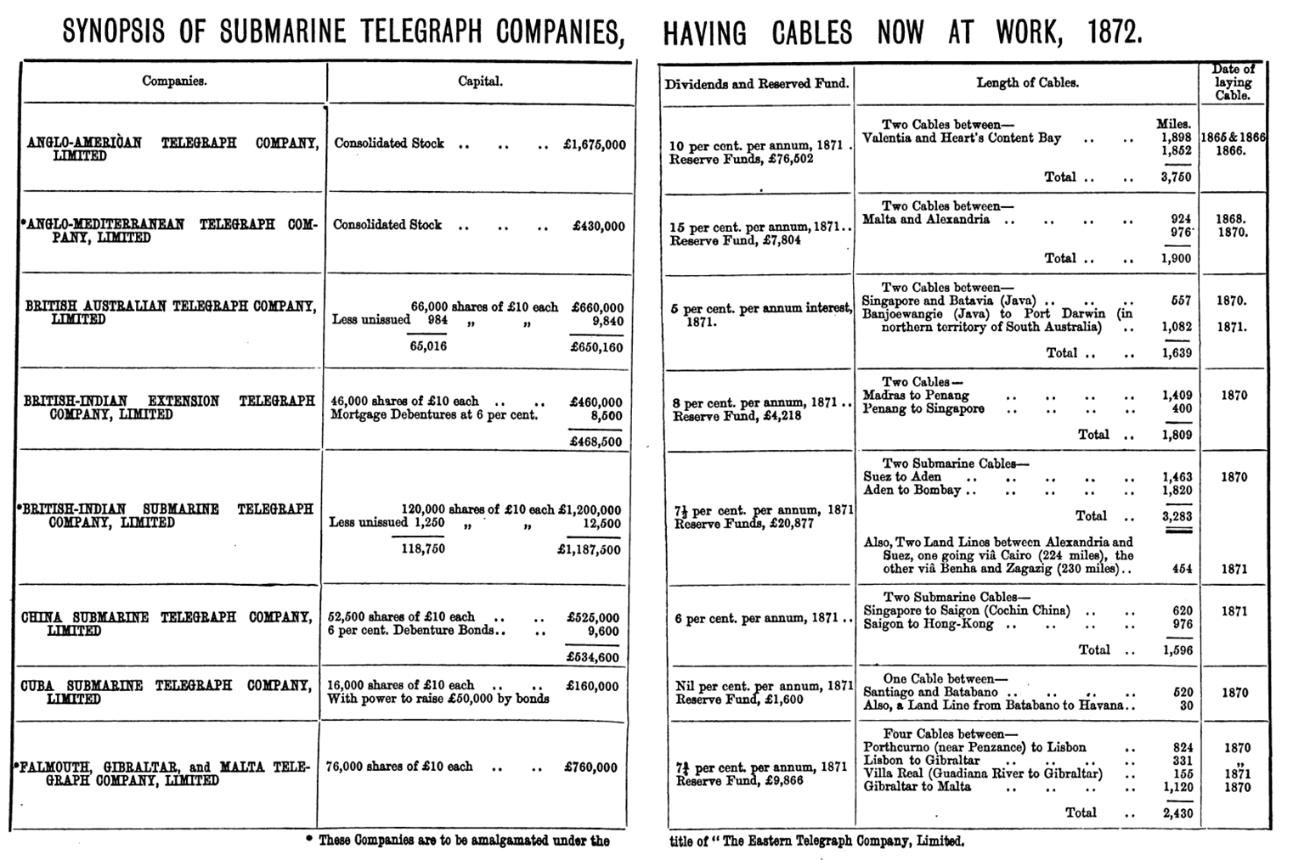
24 SUBMARINE TELECOMS INDUSTRY REPORT
cent. upon the num ber of messages sent in 1873, the total revenue at a $140 tariff would only be $92,021,866, and less working charges would return on the gross-capital 9 per cent. for dividend, reserve and repairs. I must, however, state that this is probably the worst view of the case as regards the traffic—what may be required for repairs, and how much wasted upon competition, I need not now consider.

Better results might be shewn if the traffic of the last two years were alone referred to, but we cannot always rely upon Alabama disputes and Erie Ring contests; and in calculating the probable results of the next few years, may reasonably expect that there will be one year at least without much, if any, increase.
There are fluctuations in the commercial world which it would be folly to ignore, and I give the above figures as the minimum which may safely be anticipated; but who can say what the maximum would be if it were sought to establish only a self-supporting instead of a dividend-earning system. We must, however, at once dis card all idea of ever making the tariff so low as it is for interior telegrams, the local relations do not exist to any extent requiring an outlay of even $70 for a [transatlan tic] telegram. No one can order his dinner by telegram. The small tradesmen in the suburbs provincial towns cannot order their daily or weekly supply of goods by telegram. All the questions of minor importance relating to the inner life of a nation have no equivalent outside the limits of any country.
But still it cannot be disputed that Atlantic telegraphy under a self-supporting tariff, would within ten years require several additional cables. The interchange upon a grand scale of the products of the old and new world. The intimate political relations with this country, possessing as we do a great dominion extending from the Atlantic to
the Pacific Ocean Islands, besides islands bordering upon the United States. The demand for the investment of capi tal by all the Teutonic and Scandinavian States in Europe, both in the State loans and in railways, promoting, as it does, eager speculation and ever-increasing activity in this class of correspondence, all combine to create activity in international correspondence worthy of a great sacrifice to develop, and certain to result in a great international benefit. But no one will expect that this sacrifice should be met by private investors.
SIR JAMES ANDERSON
Sir James Anderson was born in Dumfries, Scotland in 1824. He worked as a captain for Cunard Lines of Halifax, Nova Scotia in 1851. He captained the Great Eastern cable ship for both the 1865 and 1866 transatlantic lays. He went on to work as direc tor for many cable companies throughout the world. He passed away in 1893.

SUBMARINE TELECOMS INDUSTRY REPORT 25
Table 2c: 1872 Cable Operators [M to Z]
Figure 12: Sir James Anderson
GLOBAL OVERVIEW | PHILLIP PILGRIM
FUN WITH DATA!
Since Sir James has provided insight into the first years of transatlantic telecommunications. Let’s review the data and contrast to today.
Here are interesting take-aways from the first five years of continued transatlantic telecommunications:
Transatlantic
Rate
Table
We can use the data from Sir James (traffic growth, price-per-message, and messages-per-year) to calculate the yearly revenue for each of the first five years of the 1866 transatlantic cable from 1866 to 1870 inclusive. Message price is shown in Table 3.

Similarly, we can also easily find transatlantic pricing data and maximum capacity data for modern cables and calculate their theoretical maximum-revenue-per-year for their first five years. To do this we must make some as sumptions. The key two are: 1.) the cable is fully filled from day one and 2.) pricing is based on a small basic unit com parable to an 1866 message. For this second assumption, I used 10Gb/s services.
For modern times, nothing as revolutionary as the 1866 start of reliable transatlantic telecoms has occurred. However, one event in the past 25 years is significant: the advent of WDM/DWDM from 1998 to 2002. I used data from this period, and from a more recent 2015 cable, to compare against the 1866 cable. Figure 14 is a graph comparing the maximum possible yearly revenue for the three cables.
Figure 13 shows the 1866 cable revenue decreased rapidly for the first two years then the rate of decrease stabilized to a lower value with some fluctuations. Like the 1866 cable, the new 1998 cable’s maximum revenue decreased rapidly. This was due to price erosion from competitive/greedy overbuilds on the same route and from rapid technological improvements (2.5G to 10G waves and 8nm to 20nm traffic spectrum widening). History has shown that similar technology advancements in capacity, and increased competition, would also affect the 1866 cable. These events occurred after Sir James’ 1872 report; so, no data was available to plot.

The 2015 cable has less price decline due to more sta bilized prices and less competition on the route. Its high
er overall revenue potential is due to more capacity from a higher fibre count and higher data rates/ baud rates. Of course, contemporary cables can take many years to decades to fully-fill, and constant technological advance ments continually increase the maximum capacity; so, the 2015 cable is not as static or profitable as assumed in the Figure 14. With this in mind, please take the numbers from this fun exercise with a grain of salt. The key point is not much has changed in our industry. The time-cor rected 1866 cable revenues fall within the same order of magnitude of contemporary cables.
If we were to look at cost of construction, rate of price erosion, and rate of annual traffic growth, we would find the 1866 values to be in the ballpark of contemporary transatlantic cables.
I wonder if someone will be reading this 2022 industry report in the year 2172. If so, Happy 300th Anniversary! ■
Figure
Figure
26 SUBMARINE TELECOMS INDUSTRY REPORT
cable system build cost: $ 167 M USD Revenue for 1 year: $ 86 M USD Cable operating & repair costs for 1 year $ 3 M USD
of Traffic Growth: ~ 25% Price Erosion (first 5 years): ~ 32% per year
3: 1866 to 1872 Points of Interest
14: Maximum Yearly Transatlantic Cable Revenue Assuming Fully Loaded
13: Plot of “Per-Message” Price Decline for the First Five Years of Transatlanti c Cable Communications GLOBAL OVERVIEW | PHILLIP PILGRIM
As any avid follower of the sub marine cable industry will know, the true effects of COVID on the submarine cable industry were not seen in 2020 or even 2021 but will be felt more over the next several years. Systems that were planned for installation during the pandemic were able to keep working towards their goals, albeit with some significant delays in some circumstances. However, planned systems that had not yet been surveyed, manufactured, or scheduled for installation suffered the most signif icant setbacks. From start to finish, the planning and preparation of a cable sys tem takes far less time overall than the actual installation and commissioning. Therefore, the number of cable systems accomplished over the next several years will be less than the number anticipated prior to the pandemic.
After the last Industry Report was pub lished, PRAT, CDSCN, NO-UK, Cross Channel Fibre and HAVSIL all accom plished commissioning and acceptance and were lit at the end of 2021, bringing the total to 18 for the year. So far in 2022 eleven more submarine cable systems have been lit, with Equiano and Grace Hop per additionally expected to be ready for service before the end of this year.
The four regions that have had new submarine cable systems accomplished this year are EMEA, Polar, Trans pacific and AustralAsia. AustralAsia has experienced a steady decline in submarine cable installations over the past five years with only three systems having been installed in 2022 but still maintains the highest number of new systems added over the last five years, for a total of 29 systems. (Figure 15) The Indian Ocean has not
added any new systems this year but the Americas and Transatlantic will soon see a system added once Amitié has entered service.
EMEA is the region with the second largest num ber of cable system installations over the past five years at 22, including five systems in 2022 alone. Africa has been going through a digital transformation over the past decade with almost every country in Africa hav

SUBMARINE TELECOMS INDUSTRY REPORT 27
SYSTEMGrowth 1.3 Figure 15: New System Count by Region, 2018-2022 Figure 16: KMS Added by region, 2018-2022 0 5 10 15 20 Transpacific Transatlantic Polar Indian Ocean EMEA AustralAsia Americas 20222021202020192018 FIGURE 15: NEW SYSTEM COUNT BY REGION 2018-2022 0 10 20 30 40 50 60 70 80 Transpacific Transatlantic Polar Indian Ocean EMEA AustralAsia Americas 20222021202020192018 KMS (in thousands) FIGURE 16: KMS ADDED BY REGION 2018-2022
ing at least one submarine cable connection. The continued investment in submarine cable capacity will allow for the digital divide between Africa and the rest of the world to narrow even farther. These new systems create a “significant reduction in in ternational bandwidth costs, increased bandwidth consumption, and demand for emerging technolo gies.” (AFR-IX, 2021)
Southern Cross NEXT and Jupiter were both ready for service in July 2022 adding two new Transpacific systems. Five new systems have been added to this region over the last five years.
The total kilometers of cable installed gives a very different view than that of new systems added. While a given region may have had a larger number of new systems added, the overall length added has not been as high. For instance, while the Trans pacific region only saw the addition of three cable systems this over the past five years, those cable systems collectively covered nearly 72,000 kilome ters – more than any other region. (Figure 16) The Transpacific also received the largest amount of new cable in one year for the period 2018-2022 with a full 30,000 kilometers installed in 2022 alone.
Globally, there are 88 planned systems in the works over the next five years. (Figure 17) A signif icant portion of the 88 planned systems, 31 systems to be exact, are still publicizing a 2022 RFS date. Though some systems like Equiano, Grace Hopper, and Amitié are close to completion and will likely go live before the end of the year; it is very unlikely that all remaining systems planning for a 2022 RFS date will reach this goal. A few have already begun installation and should not be delayed too much – simply sliding into 2023 – while others will encounter more significant delays.
Regionally, EMEA and AustralAsia will see the largest growth percentage through 2025. EMEA has Africa1, Equiano, 2Africa, PEACE and SHARE among others, all aiming to be completed in the next few years, so it is no surprise that 29 percent of all announced future sys tems touch the region. Another 22 percent of all planned projects will touch the AustralAsia region, including ADC, PDSCN and Apricot to name a few.
So far, the Americas look to add 14 more systems: 12 in the Indian Ocean and 10 in the Transpacific region through the end of 2025. The Transatlantic is expected to produce an additional four systems during this same period.
The Polar region, though still only four percent of the total announced systems through 2025, plans to add 4 systems, which would be a 166 percent increase.
In late November 2021, Chile announced their interest in installing a cable to connect Antarctica, “to promote scientific and technological development of the southern regions of Chile.” It would be the first cable to connect to the continent should it come to fruition. (Wenger, 2021)

For a variety of reasons, some systems never make it past the planning stages. SubTel Forum has found that the announcement of being Contract in Force (CIF) is a good indicator of whether a system will enter service or not. Currently 51 percent of planned systems have announced they are CIF while 49 percent have yet to reach this important milestone. (Figure 18) Some are still in early development stages, having just been announced recently and will provide further updates in the coming months. But some will never see the bottom of the ocean floor. ■

28 SUBMARINE TELECOMS INDUSTRY REPORT
GLOBAL OVERVIEW | SYSTEM GROWTH Transpacific Transatlantic Polar Indian Ocean EMEA AustralAsia Americas FIGURE 17: PLANNED SYSTEMS BY REGION 2022-2025 3% 5% 11% 16% 22% 26% 14% FIGURE 18: GLOBAL CONTRACT IN FORCE RATES 2022-2027 Yes (51%)No (49%) Figure 18: Global Contract in Force Rate, 2022-2027 Figure 17: Planned Systems by Region, 2022-2025
OUT OF SERVICESystems
Unlike the commissioning of a new system, the de commissioning of an Out of Service (OOS) cable system hardly ever makes the headlines. In prepa ration for this year’s Industry Report, the analysts at SubTel Forum were not able to find news of any systems having been decommissioned over the last year, even though a fair number are well past their estimated End of Service (EOS) dates.
Though there were no announce ments of out of service systems this year, two submarine cable systems are confirmed to have been decommis sioned recently as ICPC spread the word of the cable recovery work being done by the team at Mertech Marine.

Over the past 18 years Mertech Ma rine has developed a system by which they acquire the cable from the owner, recover sections as feasible and recycle the various materials. This year, they have worked to recover portions of six separate systems, according to the member notifications sent by the Inter national Cable Protection Committee. A small number of other companies are
also working to repurpose decommissioned cables to be utilized for scientific research.
Based on information found in the public domain, less than 60 submarine telecommunications cable systems

SUBMARINE TELECOMS INDUSTRY REPORT 29
1.4 Figure 19: Decommissioned Systems 2002-2022 0 10 20 30 40 50 60 Indian Ocean Americas Transpacific Transatlantic AustralAsia EMEA FIGURE 19: DECOMMISSIONED SYSTEMS 2002-2022
SUBMARINE TELECOMMUNICATION CABLE RECOVERY EXPERTS WHO RECYCLE TO REPURPOSE
We are the global leaders in turnkey solutions for the recovery and recycling of out-of-service submarine telecommunication cables.
As the only provider utilising its own fleet of vessels and processing facilities to perform end-to-end decommissioning and recycling of submarine telecommunication cables, we are pioneering the process of commercially dismantling marine cables sustainably, economically and responsibly.
Submarine telecommunication cables come in various shapes and sizes and commodities such as polyethylene, lead, copper, aluminium and steel are extracted from them. We put these materials back into the circular economy, reimagining submarine cables and the possibilities they can contribute to the next generation.
Mertech Marine is run by an exceptionally experienced team of marine and cable recovery experts. We are known for our reliable innovative solutions in marine projects, providing shore-end removal, along with worldwide clearance services.





We challenge businesses to look for the opportunities that lie beneath the surface of the ocean and join our circular economy to reinvent what already exists. Out-of-service submarine telecommunication cables Own fleet of recovery vessels and processing facilities Cable recovery and recycling, depot clearance, shore-end services End-to-end decommissioning and recycling SEE A LITTLE CLEARER World Leader In Submarine Cable Recovery & Recycling GO A LITTLE FURTHER The Circular Economy World-class ISO-certified processing facilities Innovation that changes industries Responsible recovery toour oceans and planet Submarine telecommunication cable recovery THINK A LITTLE DEEPER Innovation 30,000 square metres of specialised facilities in South Africa Displaced 245,000mt of carbon dioxide equivalent (tco2e) 2,500 subsea repeaters recovered and recycled Over 95,000mt of cable recovered and recycled
have been taken OOS in the last 20 years. This is roughly 11 percent of the total number of cables that have ever been lit, according to available informa tion on early cable systems. Once a sys tem is taken out of service it is typically left at the bottom of the ocean floor. This practice is mainly to protect the marine life that may have grown around the cable, but also because it is a costly process to have the cable reclaimed.
EMEA has seen the largest number of cables removed, accounting for 46 percent of the total pool. 24 percent were in AustralAsia and the Transat lantic has lost less than 10. The Trans pacific, Americas and Indian Ocean regions all decommissioned less than 5 systems in the last 20 years and the Po lar region has not lost any as its oldest active cable was only activated 15 years ago. (Figure 19)
With technology advancing every day, more cable systems are living past their estimated EOS dates. Though there are undoubtedly systems that have been taken out of service without a formal an nouncement, many are still actively used well passed their industry standard 25-year life span. This is possible with the aid of system upgrades and equipment replacements in the landing stations and data centers. As such, there are already dozens of systems that have passed their EOS dates – some by as many as eight years.
Of those that have not yet reached their maturity dates, 85 systems will reach EOS in the next five years, and another 53 by 2032. (Figure 20) Considering that

less than 60 systems have been taken out of service in the last 20 years, the number of maturing systems that will reach end of service in the coming 20 years is some cause for concern.
Altogether, 43 percent of the current submarine cable systems relied on today will be technologically obsolete or OOS within the next ten years. Some of these systems will be replaced by state-of-the-art projects that can ful fill the same capacity requirements using less cables, but the subsea cable industry cannot rest on its laurels over the next several years; new systems need to be imple mented to replace aging infrastructure at a steady pace considering rising bandwidth demands. ■
32 SUBMARINE TELECOMS INDUSTRY REPORT
GLOBAL OVERVIEW | OUT OF SERVICE SYSTEMS
Figure
20:
Projected System Maturity
2022-2032 After 2032 (47%) EOS Through 2032 (31%) Past EOS (12%) FIGURE 20: PREDICTED MATURITY OF CURRENT SYSTEMS 2022-2032
EVOLUTION OF SYSTEM OWNERSHIP and Customer Base

Based on data in the public do main for systems accomplished between 2012 and 2022, as the number of systems increased, the split between single and multiple owner cable systems stayed consistent. Single owner cable systems averaged 57 percent of all cable systems installed in the last ten years. (Figure 21) Though there has been an increase in the num ber of Consortiums working together to bring a system to fruition, it is balanced by the number of companies that have the means to implement a cable without assistance.
Looking forward, the percentage of single owner cable systems is increasing and will account for roughly 75 percent of the projects planned over the next 4 years. (Figure 22) With the influx of Hyperscaler driven systems, it is no surprise that single owner cable systems are on the rise. Their ability to finance an entire system and desire to control all its capacity is shifting the industry norm. However, while single owner systems have more flexibility in the early design stages, it is not as easy for funding to be secured as it would be for consortia systems. Those single owner systems that are not Hyperscaler driven have a much higher rate of falling off, so these projec tions will certainly change over time. ■
SUBMARINE TELECOMS INDUSTRY REPORT 33
1.5 Figure 21: Single vs Multiple Owner Cable Systems, 2012-2022 Figure 22: Single vs Multiple Owner Cable Systems, 2022-2025
0 100 200 300 400 500 Single Multiple 20222021202020192018201720162015201420132012 FIGURE 21: SINGLE VS. MULTIPLE OWNER CABLE SYSTEMS 2012-2022 0 10 20 30 40 50 60 70 80 Single Multiple '2026'2025'2024'2023'2022 FIGURE 22: SINGLE VS. MULTIPLE OWNER CABLE SYSTEMS 2022-2025
Cross
Network is proud to be a leading

of international
Australia and New Zealand
to the USA and Pacific Islands.
Mission critical networks trust Southern Cross
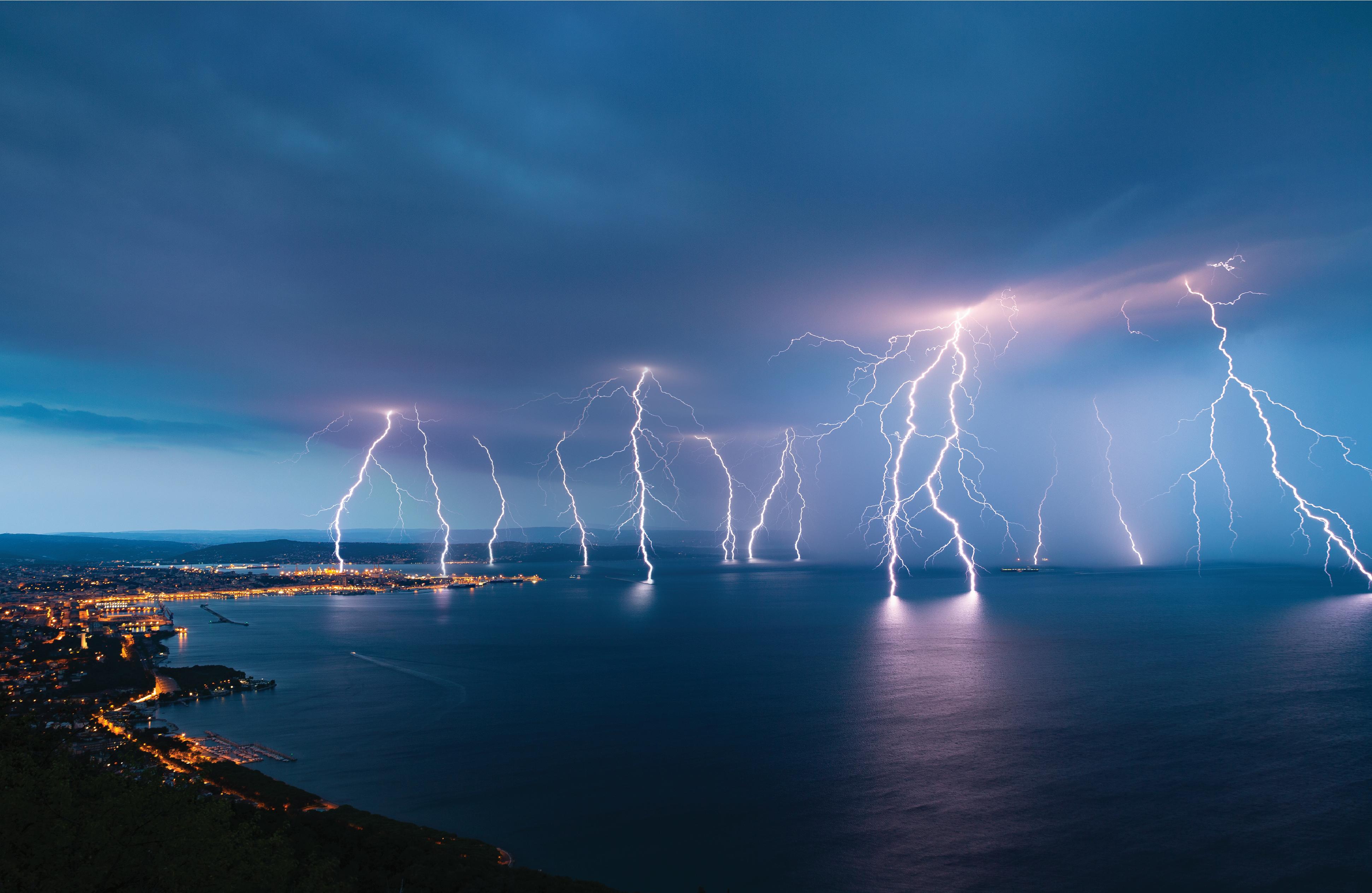
be with
for the long term.
...
Low latency. High Quality. Rapid Scalability. Southern
Cable
independent provider
cable connectivity between
Three cables
One eco-system.
Maximum Flexibility. Financial Security. to
them
POWERING THE CLOUD, UNDER THE SEA fast. direct. secure


CAPACITY

36 SUBMARINE TELECOMS INDUSTRY REPORT
2
 Video 6: Alex Chase, Senior Director - AP Telecom
Video 6: Alex Chase, Senior Director - AP Telecom
GLOBAL CAPACITY
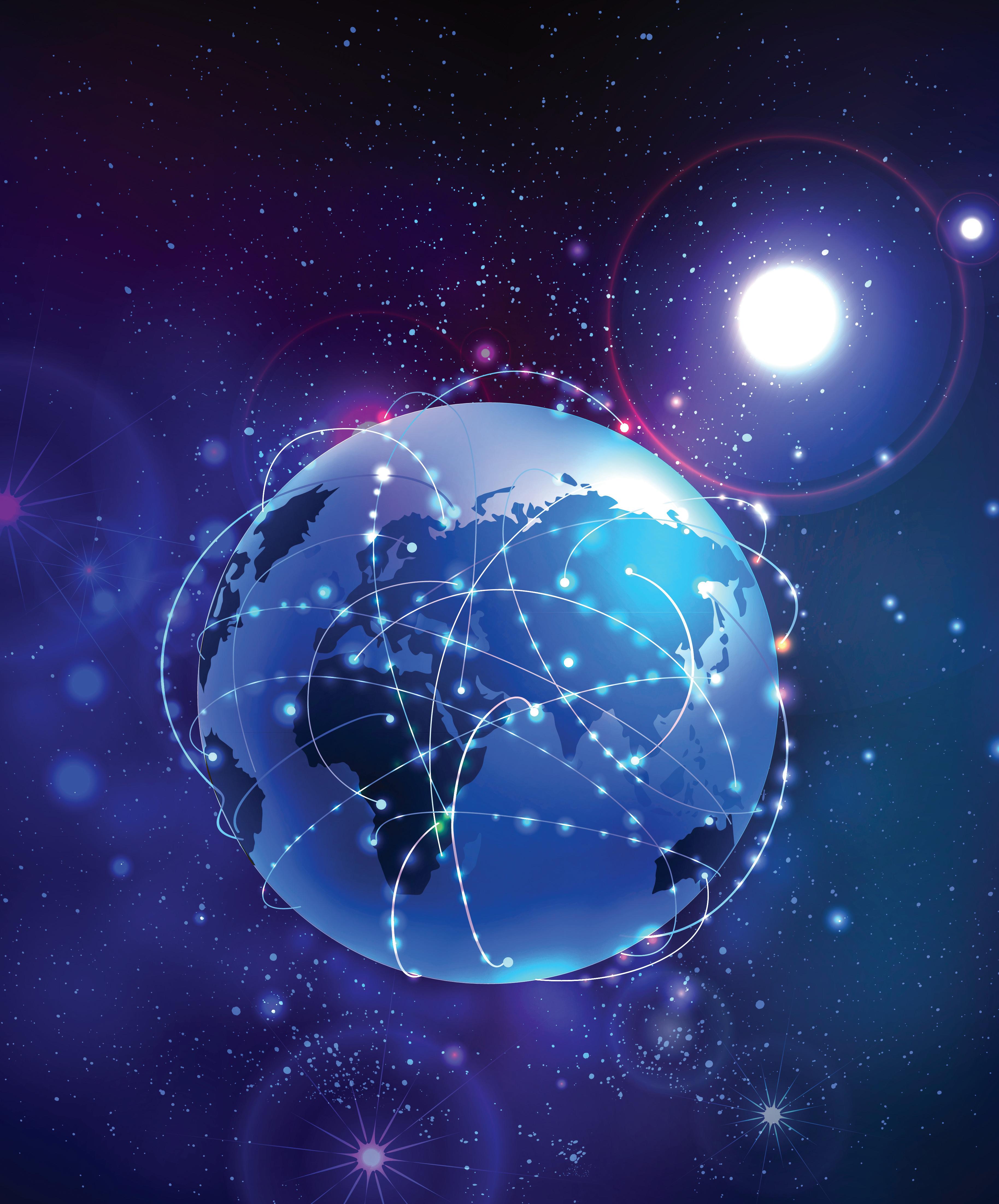
38 SUBMARINE TELECOMS INDUSTRY REPORT
2.1
The world continues to con sume ever-increasing amounts of data, with bandwidth continuing to skyrocket. This demand – driven by a contin ued shift towards cloud services, an explosion of mobile device usage and mobile technology like 5G –provides numerous opportunities for the submarine fiber industry.
For the period 2018-2022 submarine fiber capacity on major routes has increased at a Com pound Annual Growth Rate (CAGR) of 13.3 percent, including upgrades and new system builds. (Figure 23) This is down as com pared to the same analysis at this time last year, when the CAGR along major submarine cable routes was 18.2 percent.
As global demand continues to increase at a rapid pace, sustain ing infrastructure growth will be challenging and potentially cause demand to exceed supply. To date, the industry has been able to keep up with demand— but it will be necessary to continue focusing on increasing capacity even further to meet the increasing demand. This is where technology like 400G wave lengths and high fiber pair count systems can have a positive impact.
Based on reported data and future capacity estimates, global capacity is estimated to increase up to 75.4 percent by the end of 2025. (Figure 24) Despite multiple systems planned over the next three years boasting design capaci ties of more than 200 terabits per second, overall capacity growth projections are less than they were a year ago when there was a 100 percent capacity increase planned for the following three years.
However, not all announced systems are far enough along in the development process to have decided things
like fiber pair counts and design capacity, so expect to see an increase in possible bandwidth as these details are finalized and new systems are announced – especially as 400G wavelength technology and high fiber pair count systems become more prevalent. Additionally, the de mand impact brought about by COVID-19 forced many people to re-evaluate their bandwidth needs and gear up for additional capacity to facilitate remote working environments. ■
SUBMARINE TELECOMS INDUSTRY REPORT 39
0 500 1000 1500 2000 2500 3000 3500 4000 15% 20% 25% 30% 35% CAGR Transpacific Transatlantic Intra-Asia Americas 20222021202020192018 FIGURE 23: GLOBAL CAPACITY GROWTH ON MAJOR ROUTES 2018-2022 (Tbps) 0 1000 2000 3000 4000 5000 6000 7000 8000 10% 15% 20% 25% CAGR Transpacific Transatlantic Intra-Asia Americas 202520242023 FIGURE 24: GLOBAL CAPACITY GROWTH ON MAJOR ROUTES 2023-2025 (Tbps) Figure 23: Global Capacity Growth on Major Routes, 2018-2022 Figure 24: Planned Capacity Growth on Major Routes, 2023-2025 CAPACITY | GLOBAL CAPACITY
LIT CAPACITY
Since 2015, major submarine cable routes have aver aged 18 percent lit of total design capacity. A large capacity buffer is designed for cable systems to deal with sudden spikes in demand, such as handling rerouted traffic due to a cable fault.

2.2.1 TRANSATLANTIC REGION
Transatlantic routes are the most competitive globally – especially those connecting the two biggest economic hubs in the world of New York and London – and carry traffic between the highly developed economies and tech nology markets of North America and Europe.
The Transatlantic region has seen low to moderate
design capacity growth during the period 2016-2020 at a CAGR of 16 percent due to regular upgrades and a new system each year for the period 2015-2018 and one new system in 2020. (Figure 25) This is down from last year where the CAGR for the period 2015-2019 was 22.9 percent. On average, the Transatlantic route has maintained a lit capacity at 23 percent of total for this five-year period, well over the global average of 18 per cent. The last two years have seen 27.3 and 36.8 percent, respectively. Additionally, lit capacity has increased at a CAGR of 40.9 percent during this period, indicating that demand is greatly outpacing capacity build out.
Based on publicly announced information, lit capacity
40 SUBMARINE TELECOMS INDUSTRY REPORT
2.2
growth in the Transatlantic region is currently projected to outpace design capacity growth by 2025. (Figure 26) While there is still time for systems for 2025 to be developed, that window is closing considering a typical submarine cable project takes 2-3 years to implement. The mete oric rise in bandwidth demand is driven by individuals and businesses continuing to switch to cloud and web based services as they have since the start of COVID.
However, with the advent of 400G technology and high fiber pair count systems (16 to 24 or more) it is possible that design capacity will be able to stay ahead of demand through system upgrades and new systems an nounced over the next 12-18 months.
2.2.2 TRANSPACIFIC REGION
As in the Transatlantic region, Hyperscalers continue to expand their infrastructure across the Pacific and account for a significant portion of new system builds. Systems along this route connect the economies of the United States and Canada with Australia and East Asia.
The Transpacific has observed similar growth to that of the Trans atlantic with 16.6 percent CAGR for the period 2016-2020. This is about the same last year where the CAGR for the period 2015-2019 was 15.7 percent. The region has maintained an average of 29.4 percent lit capacity during this time – noticeably higher than global averages. (Figure 27)
In 2015, lit capacity was as low as 15 percent, indicating a short-term capacity overbuild in this region that has only recently begun to recede with 2019 and 2020 observing lit capacities of 29.3 and 47 percent, respectively. As in the Transatlantic region, Hyperscalers continue to expand their infrastructure across the
SUBMARINE TELECOMS INDUSTRY REPORT 41
0 100 200 300 400 500 600 700 800 30% 40% 50% 60% 70% 80% Lit CAGR Total Lit 20202019201820172016 FIGURE 25: TRANSATLANTIC CAPACITY GROWTH 2016-2020 (Tbps) 0 100 200 300 400 500 600 20% 30% 40% 50% Lit CAGR Total Lit 20202019201820172016 (Tbps) FIGURE 27: TRANSPACIFIC CAPACITY GROWTH 2016-2020 0 500 1000 1500 2000 Total Lit 20252024202320222021 (Tbps) FIGURE 26: TRANSATLANTIC CAPACITY GROWTH 2021-2025 Figure 25: Transatlantic Capacity Growth, 2016-2020 Figure 27: Transpacific Capacity Growth, 2016-2020 Figure 26: Transatlantic Capacity Growth, 2021-2025 CAPACITY | LIT CAPACITY
Pacific and account for a majority of new system builds.
As one of the more competi tive regions in the world – with a diverse number and type of both systems and customers – the Transpacific is expected to increase from its CAGR of 26.6 percent to 27.3 percent through 2025 based on publicly announced system information. (Figure 28) While lit capacity is not currently expected to outpace design capacity by 2025 as in the Transatlantic, based on currently available information lit capacity may reach as high as 69.7%. More systems need to be developed and additional upgrades performed along Transpacific routes to stay ahead of this steep rise in demand.
2.2.3 AMERICAS REGION
The Americas region has seen significant growth in the last few years, almost quadrupling in total capacity from 233.5 Tbps. in 2016 to 803.5 Tbps in 2020 along major routes. This region has observed a CAGR of 27.9 percent for the period 2016-2020. (Figure 29) This is about the same as last year where the CAGR for the period 20152019 was 28.5 percent.
The region has maintained an aver age yearly lit capacity of 9.4 percent, far below the global average. Much of this growth had been expected to derive from growing markets in Latin America developing new systems and capacity upgrades to the United States. However, this growth has not been realized yet and may be due to current economic and political issues through Central and South America.
Hyperscalers again continue to be the primary drivers of new systems along this route adding several high-capacity systems in
42 SUBMARINE TELECOMS INDUSTRY REPORT
0 500 1000 1500 2000 Total Lit 20252024202320222021 (Tbps) FIGURE 30: AMERICAS CAPACITY GROWTH 2021-2025 Figure 30: Americas Capacity Growth, 2021-2025 0 200 400 600 800 1000 10% 20% 30% 40% 50% 60% 70% 80% Lit CAGR Total Lit 20202019201820172016 (Tbps) FIGURE 29: AMERICAS CAPACITY GROWTH 2016-2020 Figure 29: Americas Capacity Growth, 2016-2020 0 500 1000 1500 2000 Total Lit 20252024202320222021 FIGURE 28: TRANSPACIFIC CAPACITY GROWTH 2021-2025 (Tbps) Figure 28: Transpacific Capacity Growth, 2021-2025
2017 and 2018 that increased the total capacity along this route by over 160 percent from 2016. Typ ically, Hyperscalers had partnered with traditional telecoms carriers that add this capacity to the general market but now they are primarily building cables entirely for their own use. However, Google has sold a fiber pair to Sparkle on the Curie submarine cable system in 2020 and another fiber pair to Lumen on Grace Hopper across the Atlantic earlier this year, showing that Hy perscalers may be willing to mone tize these assets.
Based on publicly announced system information this route will ob serve a design capacity CAGR of just 8.4 percent for the period 2019-2023. (Figure 30) This indicates a potentially significant slowdown in new capacity demand as much of the existing infra structure remains unlit.
Growth in this region is typically fueled by markets in Latin Amer ica – Brazil, Argentina, and Chile amongst others – and helped by the expansion of Hyperscalers in South America. However, due to persistent economic and political uncertainty in the region and a possible over build over the last several years the normal demand drivers for systems in this region have been absent.
Much of the new bandwidth slated to be in place by 2025 is along a route serving just the East Coast of the United States where demand is still rising.
2.2.4 INTRA-ASIA REGION
Growth along this route depends on huge infrastruc ture builds connecting major hubs throughout Asia and Southeast Asia – something that does not happen every year.
The Intra-Asia route has maintained minimal to moderate design capacity growth since 2016 with a design capacity CAGR of 17 percent for the period 2016-2020. (Figure 31) This is down slightly from last year where the CAGR for the period 2015-2019 was
Figure
Intra-Asia
Figure
Intra-Asia
19.5 percent. Lit capacity falls below global trends at 12.4 percent of total design capacity.
Over 700 Tbps capacity is already available along these routes and over 1,000 Tbps will be added through 2025, adding a sizeable increase of 143 percent. This capaci ty growth is driven by several cables over 140 Tbps in capacity being developed in the region through 2025. As demand increases across the Pacific especially between Asia, Australia and the United States there is potential for lit capacity to grow significantly as more traffic is being routed to and from Asia.
Based on publicly announced planned system informa tion this route will observe a design capacity CAGR of 18.8 percent for the period 2021-2025. (Figure 32). ■
SUBMARINE TELECOMS INDUSTRY REPORT 43
CAPACITY | LIT CAPACITY 0 100 200 300 400 500 600 700 800 5% 10% 15% 20% 25% 30% 35% Lit CAGR Total Lit 20202019201820172016 (Tbps) FIGURE 31: INTRA-ASIA CAPACITY GROWTH 2016-2020 0 500 1000 1500 2000 Total Lit 20252024202320222021 (Tbps) FIGURE 32: INTRA-ASIA CAPACITY GROWTH 2021-2025
31:
Capacity Growth, 2016-2020
32:
Capacity Growth, 2021-2025
CAPACITY PRICING 2.3

PERSPECTIVES OF ALEX CHASE
By any measure, the submarine fiber optics market is in a period of unprecedented growth. New cables are being constructed in record numbers. The Over-the-Top (OTT) content providers are criss crossing the oceans with new cables, while other operators are extending the transoceanic network with regional and local systems deeper and deeper into remote areas that were previously underserved or even unserved by cables before.
In addition, new technolo gies such as Spatial Division Multiplexing (SDM) are being deployed that allow the cables to provide levels of capacity that were previously unheard of. Whereas just a few years ago transoceanic systems had a design capacity of a few dozen terabits per second, the new est generation of SDM cables have capacities in hundreds of terabits. So, we now have a situation where there is a cable-building spree delivering an unimaginable amount of capacity to the international bandwidth market.
bandwidth demand did not take off as expected, as the Internet struggled to come out of the dotcom crash and find its place in the global market. Many cable projects failed, and their owners filed for bankruptcy. The entire submarine cable market crashed in 2002 and it took almost a decade before the market gained the strength it had seen at the turn of the century.
So, what are we seeing during the current building spree? The same pattern appears to be playing out. We have a large number of new submarine cables being built and each has far more design capacity than earlier cables, just like in the early 2000s. There is one notable exception, how ever, when comparing today’s situation with the one in 2002.
So, what are we seeing during the current building spree? The same pattern appears to be playing out. We have a large number of new submarine cables being built and each has far more design capacity than earlier cables, just like in the early 2000s.
It is easy to say, “Haven’t we been here before?” The answer is, “Yes, we have.” In the early days of the 21st Century we saw the same phenomenon: a cable-building spree coupled with new technologies delivering previous ly unheard-of amount of bandwidth (although back then the “huge” design capacity was in the dozens or hundreds of gigabits, not terabits).
And we all know what happened back then. The widespread availability of submarine cable capacity drove prices for bandwidth lower and lower. At the same time,
In 2002, there was little de mand for the vast amount of bandwidth these cables were providing. Today, demand for submarine cable bandwidth is seemingly insatiable. This means that, even though there are tremendous amounts of new capacity coming online in the global submarine cable network, demand is strong enough to prevent bandwidth prices from crash ing completely.
Prices for bandwidth on a “per bit” basis have plunged dramatically. Today, buyers can purchase terabits of capacity on submarine cables for prices that would only have bought them a few gigabits in the early part of the century. The difference is that today’s applications use far more “bits” than in those early days. The bandwidth required for modern applications (streaming video, Inter net of Things (IoT), virtualization, etc.) is huge and thus
44 SUBMARINE TELECOMS INDUSTRY REPORT
demand soaks up capacity as soon as it is available.
Competition is also a major factor in price declines. Mul tiple cables and cable owners are offering capacity along all of the major Internet routes, as it was just before the 2002 collapse. Here, however, is another case where there are very different circumstances involved that are bringing about a very different result. In 2002, “overbuilding” was a commonly used term to de scribe having too many cables between any two points. This overbuilding (along with the lack of Internet demand) led to prices crashing and the bankruptcies that followed. But we never hear of over building any more. Instead, we hear the very opposite – that we need more ca bles for redundancy. In fact, “redundancy” has replaced “overbuilding” as a key factor impacting the market. Previ ously, we were afraid of hav ing unused submarine cable capacity. Now, it is essential for network resiliency.
Marseille-Mumbai
London-Singapore
Singapore-Mumbai
Tokyo-Singapore
NYC-Sao Paulo
Miami-Fortaleza
LA-Sydney
LA-Hong Kong
LA-Tokyo
NYC-London
Marseille-Mumba
London-Singapore
Singapre-Mumbai
Tokyo-Singapore
NYC-Sao Paulo
Miami-Fortaleza
LA-Sydney
LA-Hong Kong
LA-Tokyo
NYC-London
The reason for this is that the Internet is so critical to the operations of a modern economy that loss of GDP is a direct consequence of a loss of Internet access. Small, remote countries worry about having their cable or cables being cut and losing their access to the Internet as much as countries with the largest economies in the world worry that foreign enemies could cut their cables and weaken their national security by disrupting their economies. At another level, large customers such as OTTs, ISPs and telecom providers demand from submarine cable operators that they provide multi ple redundant paths for their traffic to minimize the chances of a major disruption of their services. All of this drives the need for redundant cable systems with diverse routing.
In conclusion, we are seeing a situation that is unique in the history of submarine fiber optic bandwidth pricing. We see skyrocketing bandwidth demand coupled with skyrocketing bandwidth supply. The latter is causing continuous downward pressure on prices while the former results in demand for larger and larger quantities of bandwidth that are required for cutting-edge appli cations. This means that lower prices do not necessarily result in lower revenues as the market moves to higher quantities. However, currently, price erosion is slowing across the board for all submarine cable routes due to inflation and chip shortages. ■
SUBMARINE TELECOMS INDUSTRY REPORT 45
0 20,000 40,000 60,000 80,000 100,000 120,000 100G 10G
FIGURE 33: MONTHLY LEASE PRICING ON MAJOR ROUTES 2017-2021 0 500,000 1,000,000 1,500,000 2,000,000 2,500,000 3,000,000 3,500,000 4,000,000
FIGURE 34: MEDIAN 100G IRU PRICING ON MAJOR ROUTES Figure 33: Monthly Lease Pricing on Major Routes Figure 34: Median 100G IRU Pricing on Major Routes CAPACITY | CAPACITY PRICING
OWNERSHIP FINANCING

46 SUBMARINE TELECOMS INDUSTRY REPORT
3
FINANCING ANALYSIS

HISTORIC FINANCING PERSPECTIVE
Financing a cable system tends to be the most difficult barrier to overcome in an already lengthy process and can take years to secure. There are three models found in submarine cable system funding: multiple financiers Debt/Equity (typically a combination of investment bank capital and capacity pre-sales), Self-Financed, and Multilater al Development Banks (MDB). Hyperscalers can generally provide the full funding amount without need for outside financial assis tance and are Self-Financed on systems of which they are the sole owner. An MDB is typically involved in financing projects that

48 SUBMARINE TELECOMS INDUSTRY REPORT
Video 7: Daniel Leza, Vice President – TMG Telecom
3.1
promote growth and modernization in less wealthy countries. They also have the capability to provide lower-cost fi nancing than a commercial bank. (CFI Team, 2021)

Over the last 10 years, the ratio has remained steady between the three financing models. Debt/Equity fi nanced systems have kept a notable lead, accounting for 56 percent of all accomplished cable systems over the last 10 years while Self-Financed teams accounted for 38 percent and MDBs the remaining 6 percent. (Figure 35)
The quantity of the financial invest ments made in submarine cable systems does not always match with the amount invested. Self-Financed investments ac count for 52 percent of dollars invested,
Financing accounted for 35 percent and MDBs invested the re maining 13 percent of the $16.7 billion invested through 2022. (Figure 36) While Debt/Equity financed systems tend to be less risky than Self-Financed systems, the prevalence of Hyperscaler driven systems and the flexibility afforded to Self-Financed projects accounts for its higher percentage of dollar investment.
SUBMARINE TELECOMS INDUSTRY REPORT 49
Debt/Equity
■ 0 50 100 150 200 Self MDB Debt/Equity 20222021202020192018201720162015201420132012 FIGURE 35: FINANCING TYPE OF SYSTEMS 2012-2022 Self MDB Debt/Equity FIGURE 36: INVESTMENT DISTRIBUTION OF SYSTEMS 2012-2022 52% 35% 13% Figure 35: Financing of Systems, 2012-2022 Figure 36: Investment Distribution of Systems, 2012-2022 OWNERSHIP FINANCING ANALYSIS | HISTORIC FINANCING PERSPECTIVE
REGIONAL DISTRIBUTION OF FINANCING
3.2.1 MULTILATERAL DEVELOPMENT BANKS

Multilateral Development Banks have invested $2.1 billion in submarine telecoms cables over the last 10 years. The largest portions of this total investment — 36 percent — have been invested in the EMEA region. The Americas region received the next most, 24 percent, and the Trans atlantic received 23 percent while AustralAsia received 14 percent of total investment and the Indian Ocean region the remaining 3 percent. The Transpacific and Polar re gions have yet to receive any MDB investment. (Figure 37)
The EMEA and Americas regions accounting for the two largest portions of MDB investment is little surprise as both regions benefit and, in many cases, rely on MDB financing for various kinds of infrastructure projects. The Transatlantic region receiving near ly one-quarter of MDB investment is somewhat surprising if only traditional Transatlantic routes are considered, but this is due to the SAIL system connect ing South America to Africa directly and is a perfect use case for MDB banks.
The AustralAsia region accounting for just 14 percent is likely due to the general growth slowdown observed in this region as nations in most need of new connections has largely been accom plished while the Indian Ocean region has historically not received much invest ment from MDBs.
3.2.2 DEBT/EQUITY FINANCING

From 2012 to 2022, the largest por tion of Debt/Equity financed systems were in the Americas region at 26 percent of total with AustralAsia being
the next most at 19 percent. (Figure 38) Systems in these two regions are typically comprised of multiple local telecoms companies and governments connect ing various parts of their respective regions and can be quite expansive and therefore costly.
The Transpacific was the next most at 16 percent of new system activity while the EMEA and Transatlan tic regions accounted 14 and 13 percent, respectively. Transpacific systems are some of the largest Transoceanic systems in the world and have higher costs associated even though the total system count is lower than other regions. The EMEA region is like the Americas and Aus tralAsia regions though investment from local telecoms and governments has fallen off slightly in favor of invest
50 SUBMARINE TELECOMS INDUSTRY REPORT
Figure 37: Distribution of MDB Investment, 2012-2022 Transatlantic Indian Ocean EMEA AustralAsia Americas FIGURE 37: DISTRIBUTION OF MDB INVESTMENT 2012-2022 24% 14% 36% 3% 23%
3.2
OWNERSHIP
ment from Hyperscalers accounting for its relatively lower investment percentage. The Transatlantic region has observed multiple new cable systems over the last several years and continues to have very high capacity demand resulting in a noticeable amount of new Debt/Equity investment despite the number of cables already present within the region.
The Indian Ocean and Polar regions are the least active regions in the world and will generally have lower invest ment interest from those looking to rely on strong commercial cases to bring in capacity sales.
3.2.3 SELF-FINANCED
Between 2012 and 2022 the Austral Asia region accounted for the highest portion of Self-Financed system in vestment at 31 percent of total dollars invested. Many of these are government backed systems that do not have to rely on capacity sales to justify their develop ment. The EMEA region at 24 percent accounts for the second largest amount of Self-Financed systems owing to its overall size and the number of point-topoint systems that do not require large consortiums to develop. (Figure 39)
The Indian Ocean at 16 percent is large ly due to the large, inter-regional SEAME-WE type systems that pass through the region involving multiple parties and are treated more as utility infrastructure than revenue generating assets despite the low activity typical to the region.
The Transpacific and Americas re gion had the next highest percentage of Self-Financed system investment at 12 percent and 10 percent, respectively. While Transpacific systems tend to be costly, they are not developed at a fast enough pace to warrant further invest ment. Systems in the Americas tend to be revenue generating assets and are more likely to be financed through Debt/Equity.
In the Transatlantic, Self-Financed systems account for just five percent of total investment as only two Hyperscaler driven systems had the ability to finance themselves. The Polar region once again accounts
the smallest amount of


as this region is difficult
develop in and has much lower overall de mand
others.
SUBMARINE TELECOMS INDUSTRY REPORT 51
for
investment
to
compared to
■ Figure 39: Distribution of Self-Financed Investment, 2012-2022 Transpacific Transatlantic Polar Indian Ocean EMEA AustralAsia Americas FIGURE 38: DISTRIBUTION OF DEBT/EQUITY INVESTMENT 2012-2022 26% 16% 13% 3% 9% 14% 19% Transpacific Transatlantic Polar Indian Ocean EMEA AustralAsia Americas FIGURE 39: DISTRIBUTION OF SELF-FINANCED INVESTMENT 2012-2022 31% 24% 16% 2% 5% 12% 10%
FINANCING ANALYSIS | HISTORIC FINANCING PERSPECTIVE Figure 38: Distribution of Debt/Equity Financed Investment, 2012-2022
There has been a total of $16.7 billion invested in submarine cables systems from 2012-2020. (Figure 40) Nearly half of this amount – 47 percent –was invested in just three years from 2016-2018. This was the result of a boom kicked off by Hyperscaler investment and an overall rise in global bandwidth de mand. Had the COVID-19 pandemic not occurred, there may have been even more investment all the way through 2022.

The least amount invested was in 2015 when only $465 million worth of systems were added. This was the lowest activity pe riod for the industry since the crash of the early 2000s, but annual investment has av eraged $1.8 billion since then. Overall, this peak and valley trend appears to happen every eight to nine years and has remained consistent since the early 90s. Currently the industry is roughly halfway through an investment drop. If the trend continues, we can expect another boom between 2024 and 2025 which coincides with observed bandwidth demand projections.
The sum of installed cable over the past ten years is estimated to be 506 thousand kilome ters, with a yearly average of 46,000. (Figure 41) Comparing the amount of investment to the quantity of kilometers installed a similar eight-to-nine-year cycle is observed.
For the more recent period 2018-2022 a total of $7.4 billion has been invested glob ally. Of this amount, the AustralAsia region received the highest percentage at 29. The Transpacific, Americas and Transatlantic are the next most – all accounting for double
52 SUBMARINE TELECOMS INDUSTRY REPORT
CURRENT FINANCING 3.3 0 0.5 1 1.5 2 2.5 3 20222021202020192018201720162015201420132012 USD (Billions) FIGURE 40: SYSTEM INVESTMENT 2012-2022 0 20 40 60 80 100 20222021202020192018201720162015201420132012 KMS (Thousands) FIGURE 41: SYSTEM DEPLOYMENT 2012-2022 Figure 40: System Investment, 2012-2022 Figure 41: System Deployment, 1992-2012
OWNERSHIP FINANCING ANALYSIS | HISTORIC FINANCING
digit percentages as these regions continue to see active development due to traffic between East Asia, North America and Europe. (Figure 42)
While the EMEA is the largest region it only account for 8 percent of total investment over the last five years. This will change moving for ward once expansive systems like Equiano and 2Africa are completed.
The Indian Ocean and Polar regions accounted for four and three percent, respectively, indicat ing demand in these regions has not been high recently. However, looking forward, the Polar re gion is gaining interest to seek alternative routes to bottlenecks in the Middle East and Mediter ranean as well as connecting Antarctica. ■
YEAR PROJECT MDB
2019 Improving Internet Connectivity for Micronesia Project Asian Development Bank
2019 Coral Sea Australian Government Official Development Assistance $60 million
2020 Cook Islands to Samoa
Asian Development Bank $15; Gov. of New Zealand $20; Gov. of Cook Islands $2 million
2020 Echo U.S. International Develop ment Finance Corporation

2021 2Africa IFC
2021 East Micronesia Cable system World Bank
2022 2Africa, EASSy, Equiano, WACS IFC
DETAILS
The ADB Board of Directors has approved a total of $36.6 million in grants to help fund the delivery of the Improving Internet Connectivity for Micronesia Project. This project will help install a submarine cable connection between Micronesia and a proposed Transpacific cable system.
The Australian Government Official Development Assistance provided two-thirds majority funding of the Coral Sea submarine cable system to support the economies of Papua New Guinea and the Solomon Islands.
The Government of Cook Islands has requested the ADB to support a $37 million submarine internet cable project, which will link the islands of Rarotonga and Aitutaki in the Cook Islands to Samoa, where interconnection to the international internet hubs in Fiji and Hawaii will occur.
DFC will provide a loan of up to $190 million to Trans Pacific Networks to support construction of a 15,200 km submarine fiber optic cable connecting Singapore, Indonesia, and the United States. The new cable will expand and enhance internet access across the region, including to isolated islands.
Broadband network and digital services offered in Seychelles will soon get a boost from a new cable system that will be leased by Seychelles-based telecommunications provider Intelvision Limited with support from IFC.
The East Micronesia Cable system was designed to improve communications in the island nations of Nauru, Kiribati, and Federated States of Micronesia.
The investment from the IFC will support WIOCC Group’s continued rollout of terrestrial fiber-optic networks, investment in new subsea cables, and the launch of world-class, open-access core and edge data center infrastructure across the continent.
SUBMARINE TELECOMS INDUSTRY REPORT 53
PERSPECTIVE
Figure 42: Regional Investment in Submarine Fiber Systems, 2018-2022 Table 4: Recent Multilateral Development Bank Projects Transpacific Transatlantic Polar Indian Ocean EMEA AustralAsia Americas FIGURE 42: REGIONAL INVESTMENT IN SUBMARINE FIBER SYSTEMS 2018-2022 29% 18% 22% 16% 8% 4% 3%
SUPPLIER ANALYSIS

54 SUBMARINE TELECOMS INDUSTRY REPORT
4

ANALYSIS
SUPPLIERS
4.1.1 CURRENT SYSTEMS
Based on each supplier’s reported activity by region for the period 2018 to 2022, companies are keeping a heavy focus on the AustralAsia, Americas, Transatlantic and Transpacific regions. ASN was by far the busiest supplier over this five-year period in terms of new projects with 27 systems supplied. HMN and SubCom were the next busiest at 15 and 14 systems, respectively. AustralAsia was the largest focus of supplier activity with thirty-one different systems going live during this five-year period followed by the EMEA region with 19 and the Americas region with 14.
According to announced information on the amount of cable each company has supplied over the last five years, SubCom takes the lead — with over 118,000 kilo meters of cable produced. ASN produced the next most at 88,800 kilometers, with HMN rounding out the three busiest companies at 55,700 kilometers produced. SubCom and ASN have been very dominant in recent years, being some of the few companies that can produce cable at a high enough volume to meet demand for large sys tems. So, while some companies had a high amount of activity, they were not always supplying large systems. (Figure 43) NEC is typically in the top three companies by volume of cable produced but it is very likely that the COVID-19 pandemic hampered production in Ja pan for almost the entirety of 2020 and a large part of 2021.
The other suppliers have diversified their portfolios to include other mar kets besides submarine fiber – such as offshore wind power – as these markets
can be more lucrative for them and fit their production profile better. Overall, their participation in submarine telecoms is low for the period 2018 to 2022.
Over the last couple of years, there has been a renewed interest in Transpacific routes and routes connecting Asia and South America directly to Europe. This will involve vast systems, requiring thousands of kilometers of cable. Moving forward, the industry will have to rely on only three or four companies to tackle large projects while companies like Hexatronic become a crucial piece of the industry supporting shorter, unrepeatered systems. (Figure 44)
4.1.2 FUTURE SYSTEMS
Regional plans will differ slightly compared to recent years. Previously AustralAsia drove the bulk of new system demand, but as the Pacific Island nations are

56 SUBMARINE TELECOMS INDUSTRY REPORT
Figure 43: Number of Systems by Supplier, 2018-2022 0 5 10 15 20 25 ASN Hexatronic Cables HMN Technologies Co., Ltd. NEC Nexans Prysmian Group/NSW SubCom Xtera FIGURE 43: NUMBER OF SYSTEMS BY SUPPLIER 2018-2022
4.1
nearly all connected, this demand has gone down. In contrast, there is renewed focus on the EMEA region to replace aging infrastructure or meet growing data center demand. 2Africa and Equiano are result from increasing interest in expanding the number of connections among var ious countries in Africa and their connections onwards to Europe. The Indian Ocean region continues to see moderate growth as more owners and service providers look to circumvent the tumultuous Middle East, howev er routes through the Indian Ocean connecting Europe and Asia are still in high demand.
The Oil & Gas industry had kept demand off the coasts of Africa and Australia steady but with falling prices and policy shifts around the globe moving away from fossil fuels this im pact is lessening. Increased activity in South America had driven new cables in the Americas and south Trans atlantic regions as well but growing economic and political instabilities in these countries may impact growth for the near future. In addition, the emergence of wind and other offshore energy sources will incorporate fiber solutions, though many of these will be implemented as part of the power cable distribution system rather than for strictly telecoms purposes.
Hyperscalers are becoming in creasingly responsible for new system demand, especially for the Americas, Transatlantic, and Transpacific re gions. These companies, specifically Amazon, Facebook, Google and Microsoft are consuming bandwidth at an increasingly rapid pace. Facebook and Google alone are sole or part owners in over a dozen submarine cable systems each. Rather than buying bandwidth on existing cables, these companies have found it easier and increas ingly necessary to build and own international telecoms infrastructure. With the capacity demands from cloud services seen in 2020 resulting from more people con nected to work from home than ever before as an after effect of the COVID-19 pandemic, these Hyperscaler trends will only increase.
Overall, ASN, HMN, NEC and SubCom will contin ue to be strong leaders in the supply industry. They have been the most active and can supply the largest volume of cable and equipment. (Figure 45)
Every one of these system suppliers is composed of industry veterans with many years of experience in the submarine fiber industry. Their innovative technologies and reliable production are what continue to drive the telecommunications industry forward into the future. With robust competition between numerous com panies, we should continue to expect a healthy cable supplier industry.
SUBMARINE TELECOMS INDUSTRY REPORT 57
■ Figure 44: KMS of Cable Produced by Supplier, 2018-2022 Figure 45: Planned Systems by Supplier, 2022-2025 0 20 40 60 80 100 120 XteraSubComPrysmian Group/NSWNexansNECHMN Technologies Co., Ltd. Hexatronic Cables ASN KMS (Thousands) FIGURE 44: KMS OF CABLE PRODUCED BY SUPPLIER 2018-2022 0 3 6 9 12 15 ASN Hexatronic HMN Technologies Co., Ltd. International Telecom NEC Prysmian SubCom Xtera FIGURE 45: PLANNED SYSTEMS BY SUPPLIER 2022-2027 SUPPLIER ANALYSIS | SUPPLIERS
INSTALLERS
4.2.1 REGIONAL CAPABILITIES

In prior years ASN, Sub Com and Global Marine Systems Limited (GMSL) owned the largest part of the global cable ship fleet. This has shifted noticeably over the last two years and now SubCom maintains ownership over the most vessels with eight, then come Orange Marine and ASN with six each. Global Marine and Optic Marine are next in line five vessels each. Combined, the top five com panies account for 60 percent of the global fleet. While these numbers illustrate the part of the fleet that is exclusively owned and operated by each installer, they can also make use of “vessels of opportu nity.” This allows for a high degree of flexibility to take on any type of project around the globe. Companies now have more flexibility on where they can provide supplier services and are able to tackle projects farther away from their “home base.” This allows a cable owner a great deal of flexibility when choosing a supplier for their new system.
4.2.2 CURRENT INSTALLATIONS

Based on announced systems installed for the period 2018 to 2022, ASN is shown to be the busiest at 28 per
cent. Orange comes next at 17 percent of all systems in stalled while HMN Tech and SubCom both accounted for 16 percent of all cable system installs. This compares well with regional capability, as those who can serve the most regions tend to be the busiest. The remaining 14 percent are spread among the smaller installers such as NEC, Baltic Offshore and IT International Tele com. (Figure 46) These figures relate to the number of systems installed irrespective of their length; therefore, suppliers that produce mostly large transoceanic sys tems, such as NEC, will be under-represented based on system length compared to system value.
58 SUBMARINE TELECOMS INDUSTRY REPORT
Figure 46: Systems Installed
by Company,
2018-2022 Xtera SubCom Prysmian Group/NSW NEC Orange HMN Technologies Co., Ltd. IT International Telecom Baltic O shore ASN FIGURE 46: SYSTEMS INSTALLED BY COMPANY 2018-2022 28% 5% 1% 16% 17% 9% 5% 16% 3%
4.2
REGIONAL ACTIVITY
As several systems took longer to install in 2020 and 2021 due to Covid delays, the number of kilometers installed in the last five years has seen a slight decrease compared to previous years. The amount of cable installed by region for the period of 2018 to 2022 shows the Transpacific region as the busiest by a small mar gin over AustralAsia.
The Americas accounted for over 40,000 kilometers of installation activity while the Transatlantic accounted for as much at 35,000 kilometers. Both regions have seen renewed activity in recent years, as aging infrastructure is replaced, and additional bandwidth is in stalled on high-capacity routes between North and South America as well as Europe.
The Indian Ocean region experienced the most drastic decrease having laid a 50 per cent less in the last five years than prior analysis showed.
The EMEA region did experience a downward trend through 2020 but picked up again from 2021 onwards. And has doubled the amount of cable added in the last eighteen months compared to the previ ous five years. (Figure 47)
Projections for the next three years show a new trend differing from that of the pre vious five. The EMEA region is expected to see the most activity by far, as several large systems are set to be installed throughout the region to connect substantial portions of Africa to Europe and India. The Transpa cific, Indian Ocean and AustralAsia regions will see similar amounts of growth to each other, as Hyperscal ers and private companies continue to add infrastruc ture to these regions.
The Americas region is expected to see a marked decrease in activity as it has been one of the busiest over the last couple of years and has already received numerous new cable systems that meet the region’s need for the near future. There are early plans for new Polar systems, but they are the most uncertain – owing to the technical challenges and expenses incurred from dealing with ice. (Figure 48).
SUBMARINE TELECOMS INDUSTRY REPORT 59 4.2.3
■ 0 10,000 20,000 30,000 40,000 50,000 60,000 70,000 80,000 Americas AustralAsia EMEA Indian Ocean Polar Transatlantic Transpacific FIGURE 47: KMS INSTALLED BY REGION 2018-2022 0 50,000 100,000 150,000 200,000 Americas AustralAsia EMEA Indian Ocean Polar Transatlantic Transpacific FIGURE 48: PLANNED KMS BY REGION 2022-2026 Figure 47: KMS Installed by Region, 2018-2022 Figure 48: Planned KMS by Region, 2022-2026 SUPPLIER ANALYSIS | INSTALLERS
60 SUBMARINE TELECOMS INDUSTRY REPORT BMH BMH A/C A/C A/C A/C A/C A/C A/C A/C A/C A/C A/C A/C A/C To find out more visit fugro.com n Detailed Desktop Study and Least Risk Route n Cable Route Survey to highest specifications n Comprehensive Burial Assessment
SUBMARINE TELECOMS INDUSTRY REPORT 61
SURVEYORS
4.3.1 CURRENT SURVEYS
Based on announced activity, EGS has taken the lead by a large majority and has completed 44 percent of the surveys in the last five years. SubCom is the next busiest surveyor with 25 percent of total followed by Elettra, Fugro and IT International Telecom at eight to nine percent each.
When looking at the big picture, many of these companies overlap – supplying comprehen sive global survey capability for the industry at large. While com pleting a survey is the first crucial step for an upcoming system, a

62 SUBMARINE TELECOMS INDUSTRY REPORT
4.3
Video 7: Rene D’Avezac de Moran, Service Line Manager - Hydrography - Fugro
surveyor should always be available regard less of the system’s timeline. This allows a cable owner a great deal of flexibility when planning their new system. (Figure 49)
PLANNED SURVEYS
Completing a survey is one of the first real hurdles on the way to system implementation and 41 percent of planned systems for the period 2022 to 2025 have performed this task. Additionally, 78 per cent of all systems planned for 2022 have completed a survey, and 43 percent of all systems set to be RFS in 2022 have completed a survey. As it can take an aver age of about 18 months for a system to go from survey to completion, there are quite a few systems that will
be delayed into 2023 or later. This time last year, 45 percent
systems planned for the following year had
their
(Figure 50)

SUBMARINE TELECOMS INDUSTRY REPORT 63
4.3.2
of
completed
survey.
■ SUPPLIER ANALYSIS | SURVEYORS Elettra Fugro Global Marine Systems Limited International Telecom OGS Subcom US Government EGS FIGURE 49: SYSTEMS SURVEYED BY COMPANY 2018-2022 44% 2% 25% 2% 9% 2% 8% 8% 0 3 6 9 12 15 Incomplete Complete Americas AustralAsia EMEA Indian Ocean Polar Transatlantic Transpacific FIGURE 50: SURVEY STATUS OF PLANNED SYSTEMS 2022-2026 Figure 49: Systems Surveyed by Company, 2018-2022 Figure 50: Survey Status of Planned Systems, 2022-2026
RECENT MERGERS, ACQUISITIONS,
and Industry Activities
Mergers, acquisitions and industry activities in 2022 were like years past, and the number of such activi ties were consistent despite the impact of COVID-19. As such, a few significant acquisitions were reported, as well as alliances and industry movements.
4.4.1 3I INFRASTRUCTURE PLC COMPLETES ACQUISITION OF GLOBAL CLOUD XCHANGE

3i completed its acquisition of Global Cloud Xchange, which enables additional strategic invest ment in systems and services to create future value for customers. GCX provides high-bandwidth connectivity and global managed network services including managed ICT, cyber security and UCaaS solutions, to a range of blue-chip customers inclusive of Hyperscalers, telecommunications operators, new media providers and enterprises throughout the world. Its 66,000km of cables span 46 countries from
North America to Asia, with a particularly strong posi tion on the Europe-Asia and Intra-Asia routes. 3i Infra structure is partnering with GCX’s management team to invest in a leading platform for the sector, with the goal to increase the utilized capacity on GCX’s existing routes as well as to add new routes, services and customers.
64 SUBMARINE TELECOMS INDUSTRY REPORT
4.4
Video 8: Mike Conradi, Partner – DLA Piper
(https://SubTelforum.com/3i-infrastructure-plc-completesacquisition-of-gcx/)
4.4.2 AZERTELECOM AND SPARKLE TO C OOPERATE ON THE DIGITAL SILK WAY PROJECT
Sparkle and AzerTelecom will establish a “Digital Silk Way” project to create a digital corridor between Europe, Asia through Azerbaijan. Sparkle, the first international service provider in Italy and among the top global oper ators, and AzerTelecom, a leading wholesale telecommu nications operator of Azerbaijan, signed a Memorandum of Understanding to establish a cooperation within the “Digital Silk Way” project that aims to create a digital telecommunication corridor between Europe and Asia through Azerbaijan. Selected as one of the five best stra tegic infrastructure projects in Asia at the Global Strate gic Infrastructure Leadership Forum in 2020, the Digital Silk Way project was initiated by NEQSOL Holding and implemented by AzerTelecom to develop information technologies and digital ecosystem in Azerbaijan and transform the country into a digital hub for the region.
(https://SubTelforum.com/azertelecom-and-sparkle-tocooperate-on-the-digital-silk-way-project/)
4.4.3 BAI COMMUNICATIONS ACQUIRING ZENFI NETWORKS
Neutral host infrastructure provider BAI Communi cations announced the acquisition of ZenFi Networks, a US-based provider of digital infrastructure solutions. The deal highlights BAI’s growth strategy spanning across North America and Europe, with recent acqui sitions including other telecom infrastructure providers such as Signal Point. Expected to close in the fourth quarter of 2022, the deal will first undergo customary regulatory clearances. The value of the acquisition has not been disclosed.
(https://SubTelforum.com/bai-communications-acquiringzenfi-networks/)
4.4.4 BW DIGITAL COMPLETES ACQUISITION OF HAWAIKI SUBMARINE CABLE
BW Digital Pte. Ltd., an affiliate of BW Group Lim ited, announced the formal completion of its acquisition of 100 percent of the shares of Hawaiki Submarine Cable Limited Partnership and International Connectivity Ser vices Limited (“Hawaiki”). The transaction was subject to applicable regulatory filings and approvals, which have now all been received.
(https://SubTelforum.com/bw-digital-completes-acquisitionof-hawaiki/)
4.4.5 EQUINIX COMPLETES ACQUISITION OF MAINONE
Equinix, Inc. (Nasdaq: EQIX), the world’s digital infrastructure company™, announced it has completed its deal to acquire West African data center and connectivity solutions provider MainOne for an enterprise value of US$320M, marking the beginning of its expansion into the African continent. The completion of this acquisi tion augments Equinix’s long-term strategy to become a leading African carrier-neutral digital infrastructure company by being able to bring a full range of transfor mative technologies and connectivity to Nigeria, Ghana and Cote d’Ivoire. This acquisition will extend Platform Equinix® into West Africa, giving organizations based inside and outside of Africa access to global and regional markets. Nigeria has both the largest population and the largest economy of any country in Africa, with approxi mately 142 million active internet subscribers. Home to new innovative digital ecosystems in fintech and content and digital media, it has great opportunity for expansion of digital services.
(https://SubTelforum.com/equinix-completes-acquisition-ofmainone/)
4.4.6 FIBERSENSE AND SX ANNOUNCE EXPANSION OF ALLIANCE
Deep-tech fiber sensing company FiberSense and critical infrastructure owner Southern Cross Cable Network (“SX”) announced a further expansion of the world leading subsea cable monitoring capability in FiberSense’s DigitalAsset™ Marine. The announcement follows SX’s recent activation of their new Southern Cross NEXT submarine cable connecting Australia, New Zealand, the USA and the Pacific Islands. NEXT utilizes DigitalAsset™ Marine coverage on the shoreend network, all the way from the cable landing station to the first repeater.
(https://SubTelforum.com/fibersense-sx-announce-dealexpansion/)
4.4.7 HEXATRONIC TO ACQUIRE U.S. BASED ROCHESTER CABLE
Hexatronic Group AB has signed a binding asset purchase agreement to acquire all business activities of Rochester Cable (“Rochester Cable”), one of the main designers and manufacturers of harsh environment electro-optical cables in the USA, from TE Connectivity
SUBMARINE TELECOMS INDUSTRY REPORT 65 SUPPLIER ANALYSIS | SURVEYORS
SUPPLIER
(TE), a world leader in connectors and sensors, for an enterprise value of USD 55 million.
(https://subtelforum.com/hexatronic-to-acquire-u-s-basedrochester-cable/)
4.4.8 ITU MEMBER STATES ELECT DOREEN BOGDAN-MARTIN AS SECRETARY-GENERAL
In historic elections, Bogdan-Martin received the majority of Member State votes, pledging meaningful connectivity as her goal. She will be the first woman to lead the UN specialized agency in its 157-year history. Doreen Bogdan-Martin was elected ITU Secretary-Gen eral and is the first woman to lead the UN specialized agency in its 157-year history. Bogdan-Martin will be the first woman to lead ITU, which was established in 1865 and became a United Nations specialized agency in 1947. The election took place during ITU’s Plenipotentiary Conference (PP-22) in Bucharest, Romania, on Thursday, with representatives of Member States voting during the meeting’s morning session. Bogdan-Martin won the position with 139 votes, out of 172 votes cast.
(https://subtelforum.com/member-states-elect-doreenbogdan-martin-as-itu-secretary-general/)
4.4.9 LS CABLE & SYSTEM MAKES EQUITY INVESTMENT IN KT SUBMARINE
LS Cable & System, LS Group’s cable manufactur ing unit, announced it would make a 25.2 billion won ($17.58 million) equity investment in KT Submarine to foster its undersea cables business. The company will ac quire 4.04 million stocks, 16 percent of KT Submarine’s share, becoming the second-largest shareholder of KT Submarine. The cable manufacturer has been expanding investment in undersea cables amid a rapidly growing de mand for offshore wind power generation, which requires high-quality subsea cables. KT Submarine, established in 1995 as an affiliate of KT Group, has been engaged in the construction of submarine cables and offshore plants and in developing offshore energy sources. LS Group Chairman Koo Ja-eun has been focusing on nurturing promising future businesses such as undersea cables, re newable energy, and materials needed to make batteries, electric vehicles, and semiconductors, since taking office in November 2021.
(https://subtelforum.com/ls-cable-to-invest-w25-2b-in-ktsubmarine/)
4.4.10 SEACOM ACQUIRES AFRICELL UGANDA
SEACOM, the pan-African telecommunications service provider, announced it will acquire selected infrastructure assets from Africell in Uganda. The acquisition marks a significant step for SEACOM and is a testament to the company’s commitment to providing, competitive end-to-end connectivity and ICT solutions across the region.
(https://SubTelforum.com/africell-uganda-acquisitionexpands-seacom-footprint/)
4.4.11 TELIA CARRIER REBRANDS AS ARELION
Telia Carrier unveiled its new brand, Arelion, rein forcing its goal to provide premium global connectivity services to the world’s largest operators, content providers and enterprises. Arelion is the world’s best-connected network spanning Europe, North America, and Asia, with more than 70,000 km of optical fiber and 1,700 MPLS endpoints, connecting customers in 125 coun tries. Enterprises from gaming to finance depend on the operator’s business-critical services, including Global Internet Transit, Wavelengths, Ethernet, Mobile Data and Wholesale Voice Termination.
(https://SubTelforum.com/telia-carrier-rebrands-as-arelion/)
4.4.12 TIMOR-LESTE GOVERNMENT TO BUY TIMOR TELECOM
The Timorese government plans to buy the majority stake of Brazilian company Oi in Timor Telecom (TT) in 2023, in an operation valued at about US$14.5 million, an amount budgeted in the draft state budget for 2023.
(https://subtelforum.com/timor-leste-government-to-buytimor-telecom/?no_cache=1665058660)
4.4.13 WFN STRATEGIES, LLC ANNOUNCES SUBOPTIC FOUNDATION PARTNERSHIP
WFN Strategies, LLC announced the commencement of a partnership with the Sustainable Subsea Networks Initiative of the SubOptic Foundation. As a research initiative of the SubOptic Foundation, the Sustainable Subsea Networks Initiative is investigating the sustainability of the global subsea telecommunications network, a system that transports almost 100 percent of transoceanic internet traffic. Similarly, WFN Strategies is supporting emerging sustainable submarine cables, such as the Leif Erikson transatlantic system.
(https://SubTelforum.com/wfn-strategies-llc-announcessuboptic-foundation-partnership/) ■
66 SUBMARINE TELECOMS INDUSTRY REPORT
ANALYSIS | SURVEYORS
SUBMARINE TELECOMS INDUSTRY REPORT 67 HYPERSCALERS ARE BECOMING INCREASINGLY RESPONSIBLE FOR NEW SYSTEM DEMAND, ESPECIALLY FOR THE AMERICAS, TRANSATLANTIC, AND TRANSPACIFIC REGIONS. THESE COMPANIES, SPECIFICALLY AMAZON, FACEBOOK, GOOGLE AND MICROSOFT ARE CONSUMING BANDWIDTH AT AN INCREASINGLY RAPID PACE.
SYSTEM MAINTENANCE

68 SUBMARINE TELECOMS INDUSTRY REPORT
5
MAINTENANCE

Since SubTel Forum began tracking cable fault stories in 2014, there have been roughly 200 pub licized incidents of signal disruption from cable faults. These faults have come from a variety of incidents from tsunamis, earthquakes, and volcanic eruptions. But most often breaks and cable damage are caused by careless vessels dropping anchors or fishing without care of what is in the water beneath them.
The AustralAsia region has consistently experienced the largest number of incidents over the past nine years, suffering 39 percent of announced faults. (Figure 51) This year alone there have been 14 incidents in AustralAsia, with APG having broken 3 times in the last year – the most of any cable this year. EMEA is another region that experiences a high number of cable faults on a yearly basis, with 26 percent of all faults occurring in this zone. A key reason for the high num ber of occurrences in these two areas is the limited areas in which it is safe for certain vessels to sail which also tends to be the most ideal location for submarine cables. Smaller channels of safety lead to an increase in traffic and thus more faults. Regions that cover larger areas or have less limited shipping lanes provide route diversity for cables as well as the vessels that travel on the waters above.

Previously, SubTel Forum has discussed the lack of publication of cable faults in the media. More often than not, word spreads via social media about service disruptions and does not often come from the cable owners or main tainers. This lack of information makes it hard to measure the true danger that submarine cables face in certain parts of the world. Com pared to previous years, 2022 saw less news about submarine cable system failures, though it was a small increase from the number of incidents that were seen in 2021. (Figure 52) ■

70 SUBMARINE TELECOMS INDUSTRY REPORT
PUBLICITY 5.1 Figure 51: Cable Fault Stories Per Region, 2014-2022 Figure 52: Total Cable Fault Stories, 2014-2022 Transatlantic Indian Ocean Transpacific EMEA AustralAsia Americas FIGURE 51: CABLE FAULT STORIES PER REGION 2014-2022 21% 39% 26% 7% 7% 1% 15 20 25 30 35 202220212020201920182017201620152014 FIGURE 52: TOTAL CABLE FAULT STORIES 2014-2022
REPORTING TRENDS AND REPAIR TIMES
time on announced faults took longer than in previous years, causing the average downtime to drastically increase. This in crease resulted primarily from two incidents, the damage from the eruption of the Tonga Volcano, and the recent damage to several systems near Papua New Guinea after the September 11 earthquake. The damage to these cables is taking longer to fix than simple anchor damage because they have been damaged in multiple places. In the case of the Tonga Cable, complete destruction was observed over a large stretch of the ocean floor. The repeated damage to the APG cable did also con tribute to the repair time as it takes time to mobi lize, travel, and actually repair a cable. (Figure 53) ■

SUBMARINE TELECOMS INDUSTRY REPORT 71
5.2 Figure 53: Average Reported Repair Time in Days, 2014-2022 10 20 30 40 50 60 70 80 202220212020201920182017201620152014 FIGURE 53: AVERAGE REPORTED REPAIR TIME IN DAY 2014-2022
Repair
CLUB VERSUS PRIVATE
5.3 Agreements
Marine maintenance is a shared service where several cable owners share the benefit of resources within a defined operational area. There are two forms an agreement can take: private, wherein the contractor and cable owner agree prices and conditions on a bilateral basis, and club, wherein the agreement conditions and prices are linked with all the participating cable owners.
5.3.1 TRADITIONAL CLUB AGREEMENTS
The way that the Maintenance Zone operates is that each owner nominates a representative to act as the main point of contact between itself and the marine service pro vider and depot operator. This representative is called the Maintenance Authority for the system and will provide instructions to the ship during the repair and the depot oper ator before and after the repair. The Maintenance Authority will also retain the detailed aslaid records for the system and update them after each repair.
5.3.1.1 2 OCEANS CABLE MAINTENANCE AGREEMENT

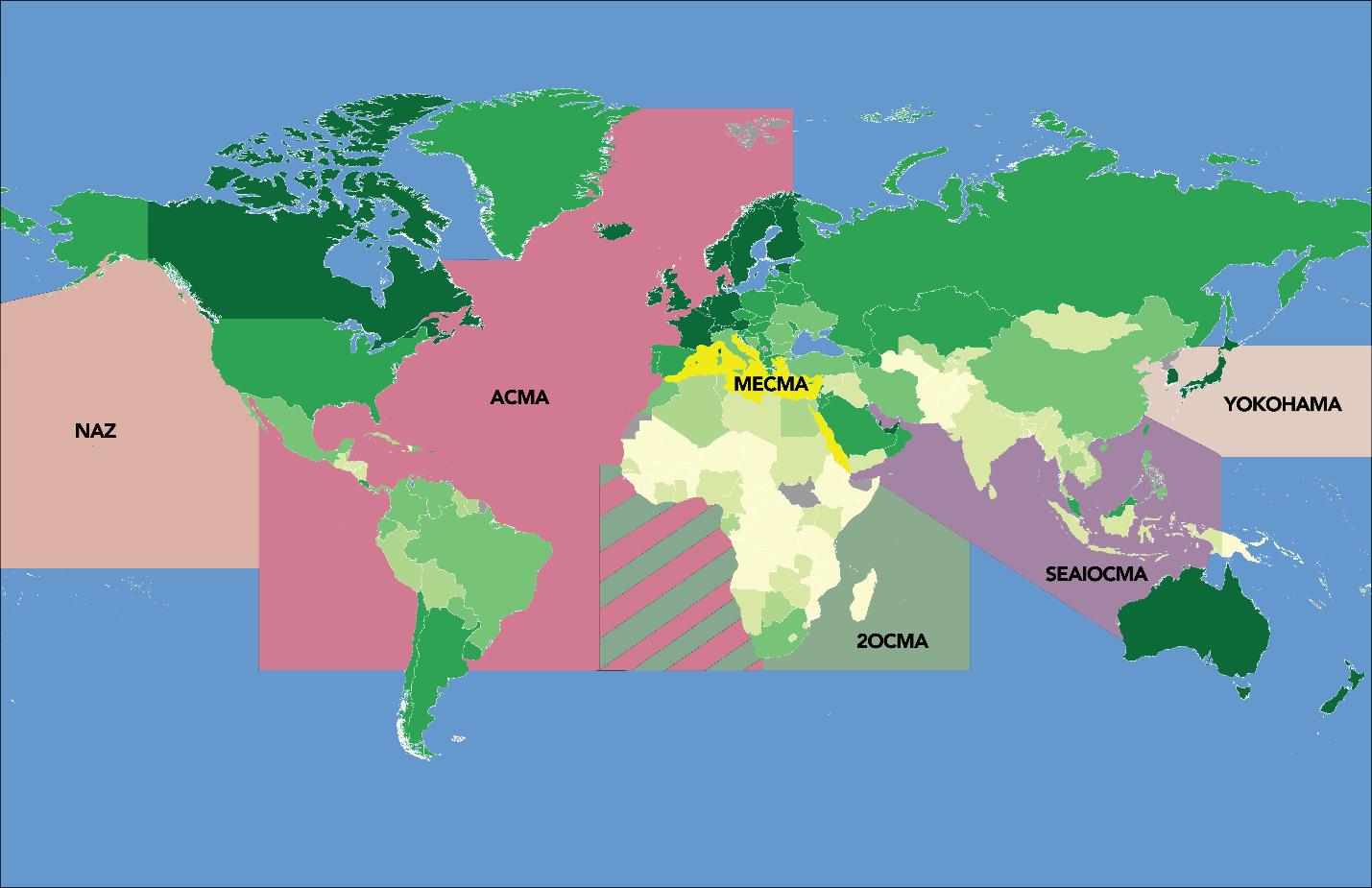
2 Oceans Cable Maintenance Agreement (2OCMA) oper ates in the South of Atlantic and Indian oceans from Cape Town (South Africa) using the facilities of Telkom SA depot. 2OCMA is supported by vessels and facilities from Orange Ma rine, and possesses base ports in Cape Town, South Africa.
5.3.1.2 ATLANTIC CABLE MAINTENANCE AGREEMENT
The benchmark for all maintenance services and the most popular worldwide is the Maintenance Zone. The first Maintenance Zone was set up in the North Atlantic in 1965 and is called Atlantic Cable Maintenance Agree ment (ACMA). ACMA defined and continues to set the standards for structure and operating procedures that all other Maintenance Zones around the world now follow.
ACMA operates in the Atlantic, Southeast Pacific and Northern Europe zones. The agreement utilizes Global Marine depot facilities in Portland, UK, and Bermuda; Orange Marine’s facilities in Brest (Northern France); and SubCom facilities in Curacao (Dutch Antilles). Global Marine vessels are nominally based in Curacao
72 SUBMARINE TELECOMS INDUSTRY REPORT
Figure 54: Traditional Club Agreements Map
and Portland whilst the Orange Marine vessel is based in Brest.
5.3.1.3 MEDITERRANEAN CABLE MAINTENANCE AGREEMENT
Mediterranean Cable Main tenance Agreement (MECMA) operates from the Mediterranean Marine Base of La Seyne-sur-Mer (Southern France) on 71,000 km of cables in the Mediterranean zone including the Black and Red Seas. MECMA is supported by vessels and facilities from Orange Marine and Elettra and possesses base ports in Le Seyne Sur Mer, France and Catania, Italy.
5.3.1.4 NORTH AMERICAN ZONE CABLE MAINTENANCE AGREEMENT
North American Zone Cable Maintenance Agree ment (NAZ) covers an area from the Bering Sea and Alaska in the North to the Equator in the South and from the Americas to approximately 167º West Lon gitude. NAZ is supported by vessels and facilities from Global Marine Systems Limited, and possesses a base port in Victoria, Canada.
5.3.1.5 SOUTHEAST ASIA/INDIA OCEAN CABLE MAINTENANCE AGREEMENT

Southeast Asia / Indian Ocean Cable Maintenance Agreement (SEAIOCMA) stretches from Djibouti to Guam and from Taiwan to Australia and covers an area of approximately one-third of the earth’s oceans. SEAIOCMA is supported by vessels and facilities from ACPL, IOCPL and Global Marine Systems Limited and possesses base ports in Singapore; Colombo, Sri Lanka; and Manila, Philippines.
5.3.1.6 YOKOHAMA ZONE CABLE MAINTENANCE AGREEMENT
The Yokohama Zone has been one of the major cable maintenance zones in the Asia-Pacific region, covering cables in Northern Asia and Northwest region of the Pacific, and adjacent to the NAZ and SEAIOCMA zones. Yokohama Zone is supported by vessels and facilities from KCS, KTS and SBSS and possesses base ports in Yokohama, Japan; Keoje, Korea; and Wujing, China.
5.3.2 PRIVATE MAINTENANCE AGREEMENTS
There are several types of contracts in place for provid ing private marine maintenance services globally. Private agreements are typically offered by the ship operators and are usually tailored (within the limits of the overall eco nomic model) to the needs of the individual system owner.
5.3.2.1 ATLANTIC PRIVATE MAINTENANCE AGREEMENT
The Atlantic Private Maintenance Agreement (APMA) covers an area encompassing the Atlantic and Mediterranean. APMA is supported by vessels and facil ities from ASN and SubCom and possesses base ports in Calais, France; Curacao; and Cape Verde.
5.3.2.2 ASIA PACIFIC MARINE MAINTENANCE SERVICE AGREEMENT
APMMSA is supported by vessels and facilities from SubCom and possesses a base port in Taichung, Taiwan.
5.3.2.3 E-MARINE
E-marine covers the maintenance of cables primarily in the Arabian Gulf, Red Sea, Indian Ocean, and Arabian Sea. E-marine possesses base ports in Hamriya, UAE and Salalah, Oman.
5.3.2.4 SOUTH PACIFIC MAINTENANCE AGREEMENT
The South Pacific Maintenance Agreement (SPMA) covers the southern Pacific region eastward to the Ha waiian Islands. SPMA is supported by vessels and facili ties from SubCom and possesses a base port in Samoa. ■
SUBMARINE TELECOMS INDUSTRY REPORT 73
Figure 55: Private Maintenance Agreements Map SYSTEM MAINTENANCE | CLUB VERSUS PRIVATE
CABLE SHIPS

74 SUBMARINE TELECOMS INDUSTRY REPORT
6

6.1.1 FLEET DISTRIBUTION

On a daily basis, SubTel Forum tracks the whereabouts and activities of 50 cable ships around the world. Each vessel is slightly different, but they are all used to install or service the same communication backbone. Addition ally barges, power cable vessels, and the ever-important survey vessels also work within the realm of the subma rine telecommunications industry, though these are not typically associated with the cable ship fleet as they do not have the ability to repair or lay new cable.
For the purposes of this report, our analysts focus on telecommunications cable ships as power cable ships tend to require different installation capabilities. In the 2017 SubTel Forum Industry Report, nine companies owned the entire fleet but over the last six years, this number has grown to seventeen companies. Howev er, the total num ber of vessels has changed very little, as many of these newer companies to the global fleet purchased existing vessels from others.
Currently three companies share the top 40 per cent of the entire fleet. SubCom represents the largest portion of
the fleet with ownership of eight vessels. ASN recently added the Ile de Molène and will add their other recent acquisition the Ile d’Yeu in a few months bringing their total to seven. Orange currently owns six vessels but has stated they will be replacing the C/S Raymond Croze in the early 2023 once the construction of the Sophie Germain has been completed. (Orange, 2020) Asean, Optic Marine, E-Marine, Global Marine and SBSS make up the next largest percentage, controlling another 40 percent of the fleet, collectively. The own ership of the remaining 20 percent is spread amongst nine companies that own on or two vessels apiece. (Figure 56)
76 SUBMARINE TELECOMS INDUSTRY REPORT
Figure 56: Cable Ship Fleet Distribution by Company 0 1 2 3 4 5 6 7 8 SubCom S.B. Submarine Relacom PT Limin Marine Prysmian Group/NSW Orange Optic Marine NTT WE Marine KT Submarine KCS IT Interational Telecom Global Marine E-Marine PJSC DNeX Baltic O shore ASN ASEAN Cable FIGURE 56: CABLE SHIP FLEET DISTRIBUTION BY COMPANY CURRENT CABLE SHIPS 6.1
6.1.2 GROWTH AND AGE OF CABLE SHIP FLEET
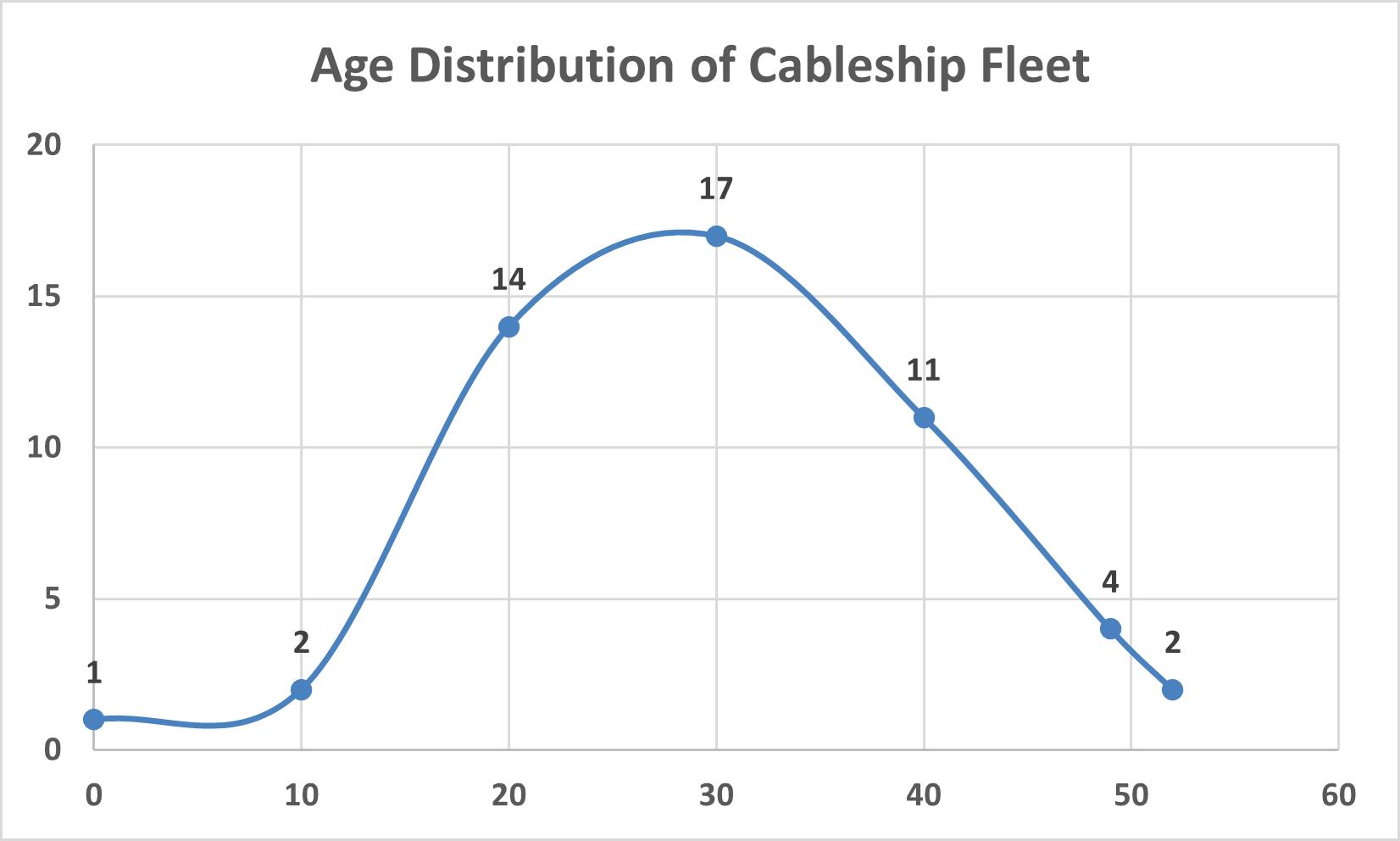
In 2022, the largest growth to the submarine cable ship fleet in 20 years was observed with three new vessels added. The last time more than one vessel was added was in 2002 when the fleet grew by eight ships in anticipation of the telecoms boom. With the sinking of the KT Responder and the retirement of the Fu An, both in 2020, the influx is a welcome change. (Figure 57)
Currently the average age of a vessel in the fleet is 27.68 years old, having risen from last year’s average of 25.19. This rise occurs because cable ships are not generally built from the keel up. More often than not, vessels are retrofitted to add the structures and technol ogy essential to submarine ca ble system installation. There fore, the age of the fleet does not necessarily go down even though a new vessel has been added. The recently completed conversion of the Ile de Mo lene is a perfect example. This ship was converted from an offshore tug/supply ship when it was already 16 years old. The Sophie Germain will be the first purpose built submarine telecommunications cable in stallation vessel in many years.
While the addition of the new vessels is a welcome reprieve, 68 percent of the overall fleet is still over 30 years old. (Figure 58) This is a significant disparity in comparison with similar vessels such as cargo ships which have an average age of 26 years and bulk carriers which tend to be less than 10 years of age. (UNCTAD, 2021)
The age of these vessels is not simply a statistically important factor. Older vessels are less energy efficient and generate higher emissions making them more harm ful to the environment. (UNCTAD, 2021). Therefore, continued investment in cable ships will need to increase if the industry is to continue installing systems at a pace necessary to meet capacity demands, and to increase the industry’s overall sustainability.
6.1.3 CABLE SHIP ACTIVITY
In the twelve-month period since the last Industry Report was produced, SubTel Forum has logged daily vessel tracking data adding up to over 51,000 AIS pings. Figure 59 utilizes the AIS location data to create a tree map based on the number of pings each region received. Every so often a cable ship will venture outside of the region it generally works in, but it is more common for cable ship owners to accept projects that keep them in or near their home ports. Maintenance vessels especially need to stay close to home to accomplish repairs in their maintenance agreement’s zones.
East Asia and Southeast Asia were two of the busiest
SUBMARINE TELECOMS INDUSTRY REPORT 77
Figure 58: Age Distribution of Cable Ship Fleet 0 1 2 3 4 5 6 7 8 202220212020201920182017201620152014201320122011201020092008200720062005200420032002 FIGURE 57: CABLE SHIPS ADDED BY YEAR 2002-2022 Figure 57: Cable Ships Added by Year, 2002-2022 CABLE SHIPS | CURRENT CABLE SHIPS
regions, seeing 24 percent of all vessel activity in the last twelve months. This is typical for Asia and the Pacific which has some of the highest concentrations of cable systems in the world. With the addition of several new systems like KSCN, BaSICs, BALOM and Jupiter, it is no surprise that so much activity occurred in that zone. This general area also includes the coast of China which saw an additional seven percent activity.
The North Sea, West Africa and Northeast Atlantic shared 23 percent of cable ship activity, with a signifi cant amount of that activity resulting from the ongoing work to Equiano and Grace Hopper. This activity level will remain steady in 2023 with work on 2Africa, Peace and Africa1. These projects will also keep traffic in the Mediterranean and the Red Sea which, combined, shared 22 percent of the past year’s activity.
The remaining 24 percent of cable ship activity is spread out among smaller regions across the globe. As these areas cover less nautical miles, they do not require as much time when passing through, and therefore vessels do not log as much time in those regions. The systems mentioned around EMEA should also af fect the traffic in the Eastern part of Africa as those systems continue to work on landing along the Arabian Sea and Indian Ocean
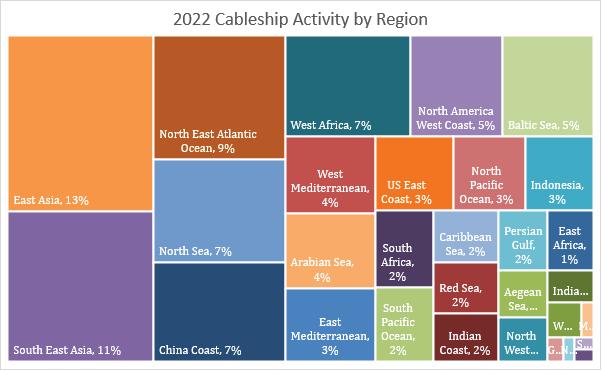
6.1.4 NEW CABLE SHIPS
Unlike years prior, 2022 saw an influx of new cable ships. In late August, Optic Marine commissioned their newly refitted Cable Vigilance in Dunkirk France. She is a 5,448 gross tonnage cable-laying and repair ship converted at the Remontowa Shipyard in Poland. She will be based in France and will work primarily as a maintenance vessel, having already completed her first repair of the Greenland Connect Cable in early Sep tember 2022. (Optic Marine, 2022) SubCom quietly welcomed their new cable laying vessel, the Endeavour, though the specific date of acquisition is unknown and was only recently added to the AIS data. ASN pur chased two vessels in late 2021 to convert into a main tenance and cable laying vessel. The Ile de Molene was completed and commissioned in late July and the Ile d’Yeu should be completed shortly per ASN announce ments. S.B.S.S. also added a vessel to their fleet, the Fu Tai in February 2022 replacing the quietly retired Fu An, which was removed from the fleet last year. Over the coming year the Ile d’Yeu’s conversion should be completed and Orange will have received the finished Sophie Germain to ease the load. ■
78 SUBMARINE TELECOMS INDUSTRY REPORT
CABLE SHIPS | CURRENT CABLE SHIPS
Figure 59: Cable Ship Activity
6.2.1 CURRENT SHORE-END ACTIVITY
Shore-end landings continue to corelate regionally with the systems that are imple mented in those areas. As seen in the Global Overview section, AustralAsia has seen the largest percentage of system implementation in the past five years. While some systems use the landings with existing infrastructure, the need for route diversity leads many systems to build new landings stations as protection against disruptions. The Americas and EMEA have each added about a quarter of the new landings with the Indian Ocean and Transpa cific regions seeing the least amount of landing growth. (Figure 60)
6.2.2 FUTURE SHORE-END ACTIVITY


Looking forward, AustralAsia is predict ed to fall slightly from 44 percent of all new landings to 37 percent, with EMEA increasing the number of new shore-end landings to 31 percent over the next four years. The Americas will maintain its position as the third most important region for new landings, staying steady with 24 percent of new landing activity. Though they represent a small portion of new landings, Transpacific and Polar regions will each see an increase in landings if the an nounced planned systems come to fruition. ■

SUBMARINE TELECOMS INDUSTRY REPORT 79
Transpacific Indian Ocean EMEA Australasia Americas FIGURE 60: LANDING DISTRIBUTION BY REGION 2018-2022 44% 24% 5% 27% <1% Transpacific Polar Indian Ocean EMEA Australasia Americas FIGURE 60: LANDING DISTRIBUTION BY REGION 2022-2026 <1% 1% 24% 7% 31% 37% SHORE-END ACTIVITY 6.2 Figure 60: Landing Distribution by Region, 2018-2022 Figure 61: Landing Distribution by Region, 2022-2026
MARKET DRIVERS

80 SUBMARINE TELECOMS INDUSTRY REPORT
7
DRIVERS AND INFLUENCERS

HYPERSCALERS

Hyperscalers are an increasingly integral part of the submarine cable system development process. Amazon, Facebook, Google and to a lesser extent Microsoft have moved from ca pacity purchasers to cable owners. Not only are these Hyperscalers now driving where cables are going, they are helping to push along new innovations inside of the cable systems themselves. New transmission technology to manage higher capacity wavelengths, increased fiber counts for more overall system capacity and streamlined network management, and the push for open systems leading to shared system architecture are just a small sampling of new technologies and ideas these providers are backing.
During the pandemic, the amount of cloud adoption across a variety of industries skyrocketed as companies were forced to find ways for their em ployees to continue being productive in their homes and other unconven tional working conditions. Companies found themselves spending more than ever before on Software as a Service (SaaS) products like Microsoft 365, DocuSign, and Dropbox as well as private cloud options. (Flexera, 2022)
Another major change Hyperscal ers have brought to global networks is shifting the focus from city-to-city connections to data center-to-data center connections. Unlike traditional cable owners, companies like Amazon, Facebook, Google and Microsoft do not necessarily need to build infrastructure in locations with a variety of intercon
nect options. Instead, they favor locations that provide economic and cost saving benefits to reduce the opera tional expenditure impact of their data center facilities. The arrival of a major Hyperscaler provider not only brings new telecoms infrastructure to a region but also the cloud services that the company provides.
7.1.1 CURRENT SYSTEMS IMPACTED
A new paradigm emerged in 2016, with Hyperscalers stepping into the world of submarine cable ownership. Many of these companies have such large and complex infrastructure requirements that it is more valuable for them to own their own cable systems rather than buy

82 SUBMARINE TELECOMS INDUSTRY REPORT
Hyperscaler Driven Non-Hyperscaler Driven FIGURE 62: SYSTEMS DRIVEN BY HYPERSCALERS 2018-2022 18% 82% Figure 62: Systems Driven by Hyperscalers, 2018-2022
7.1
capacity from a carrier.
The dramatic growth in capacity demand has created significant challenges for telecommunications companies, Internet Service Providers (ISPs), and Hyperscalers. The top segment of many markets is becoming dominated by large Hyperscaler players, such as Google, Amazon, Microsoft, and Facebook – who have become key stake holders and require large amounts of bandwidth between their data centers on various continents.
Hyperscalers were the driving force behind 20.4 per cent of systems that went into service for the period 2018 to 2022 – which is up slightly from 20 percent a year ago. (Figure 62) In 2022 alone, Hyperscaler driven systems account for 35 percent of all new system builds.
Several factors led to these companies making the decision to build their own infrastructure. One of the biggest eye-openers was Hurricane Sandy hitting New Jersey, USA – a major cable landing hub – in 2012. This storm wiped out critical infrastructure, flooded cable ducts and caused a huge loss of connectivity to Europe for several days – resulting in millions of dollars in lost business. The aftermath of this storm highlighted the need for increased route diversity and more direct control over critical infra structure. This will help to spur on the surge of Hy perscaler backed submarine cable systems. (Figure 6)
Additionally, major Hy perscalers are growing at such a rapid pace that their need for additional band width outpaced their ability to purchase it in a timely manner. Building their own infrastructure provides both greater control over assets and removes the need to “compete” against other carriers and businesses also trying to buy capacity circuits. As a result of owning and operating their own critical infrastructure, Hyper scalers can now turn on additional capacity in a matter of days instead of weeks or months as when buying circuits from a traditional carrier.
While transoceanic cable systems are expensive – well over $100 million just to get across the Atlantic – these assets represent business potential in the billions of dollars for major Hyperscalers. Even the annual opera
tions expenditure to manage and maintain the cable is a fraction of potential revenue.
7.1.2 FUTURE SYSTEMS IMPACTED
For the period 2022 to 2025, 21 percent of planned systems are being driven by Hyperscalers, a decrease of 2 percent from last year. (Figure 65) This slight reduction in Hyperscaler activity could be due to several factors such as the continuing impact of the COVID-19 pandemic or the potential layoffs and cost cutting measures this year from Facebook – which may cut as much as 10% of its staff (Erb, 2022) – and Google – which is aiming to improve efficiency by 20 percent (Elias, 2022). Additionally, the chip shortage since 2020 has hampered overall technology devel opment across multiple industries but will likely be resolved by the end of this year. (J.P. Morgan, 2022)
However, as systems driven by major Hyperscalers have a much greater chance of being implemented – due to the high financing threshold of these companies – ex pect this percentage to continue to increase as new cables are announced, and other projects die off. Without these kinds of backers, future systems will have a much harder time proving their business case and securing funding.
While the top tier Hyperscalers are continuing to develop new systems, there are numerous other compa nies in this part of the Information Technology sector. A second wave of these companies – especially those that provide remote work services – may decide they need similar infrastructure plans and follow in the footsteps
SUBMARINE TELECOMS INDUSTRY REPORT 83
0 5 10 15 20 Hyperscaler Driven Non-Hyperscaler Driven 20222021202020192018 FIGURE 63: SYSTEMS IMPACTED BY HYPERSCALERS 2018-2022
Figure
63:
Systems Impacted by Hyperscalers,
2018-2022 MARKET DRIVERS AND INFLUENCE | HYPERSCALERS
of their respective market leaders. This could trigger a second wave of Hyperscaler driven systems and allow the submarine fiber market to continue enjoying its current level of activity even after the top tier providers begin to reach the end of their infrastructure buildout plans. However, no new Hyperscalers have officially or publicly expressed interest in building submarine cable infrastructure.
Of the $13.2 billion investment for planned systems over the next several years, 30 percent of that amount is tied up in Hyperscaler backed systems. Again, while these companies are not sole owners on every cable system, they are a part of, this still rep resents a significant dollar value that would very likely not exist without their involvement. (Figure 66)
While only 52 percent of announced cable systems end up entering service (Clark, 2019), Hyperscaler backed systems have thus far proven largely immune to this trend as they generally do not announce a sys tem until it is already CIF. It is therefore probable that up to half of non- Hyperscaler driven systems will not achieve the CIF milestone and further highlight the dominance of the Hyperscalers on the submarine fiber industry. ■



84 SUBMARINE TELECOMS INDUSTRY REPORT
Amazon Microsoft Facebook Google FIGURE 64: HYPERSCALER SYSTEM OWNERSHIP DISTRIBUTION 59% 30% 7% 4% Hyperscaler Driven Non-Hyperscaler Driven FIGURE 65: SYSTEMS DRIVEN BY HYPERSCALERS 2022-2025 21% 79% Hyperscaler Driven Non-Hyperscaler Driven FIGURE 66: SYSTEM INVESTMENT DRIVEN BY HYPERSCALERS 2022-2025 70% 30% Figure 64: Hyperscaler System Ownership Distribution Figure 65: Systems Driven by Hyperscalers, 2022-2025 Figure 66: System Investment Driven by Hyperscalers, 2022-2025 MARKET DRIVERS AND INFLUENCE | HYPERSCALERS
Data center providers have become an increasingly integral part of the submarine telecommunications ecosystem over the last several years. As a result, one of the biggest dynamic changes has been to place data center and colocation facilities closer to cable landing stations to maximize interconnection and network services. Building these facilities next to – or even as part of – the cable landing station reduces net work latency and streamlines infrastructure.
This type of configuration is especially attractive for cable landing stations that house multiple cable systems as they provide access to a much wider array of customers and interconnection opportunities. For instance, the cable landing facilities in Marseille, France, house thir teen international submarine cables and provide access to dozens of potential customers needing both intercon nection and onward backhaul connectiv ity. (SubTel Forum Analytics Division of Submarine Telecoms Forum, Inc., 2020)
7.2.1 CLOUD ADOPTION

Cloud adoption is at an all-time high as com panies continue to shift towards both cloud stor age and cloud computing to drive their business. Microsoft Azure and
Amazon Web Services lead the way in enterprise adop tion with no sign of slowing down. These cloud services are global in nature and inevitably their traffic will end up traveling over submarine telecommunications cables. As a result, data center providers have become more involved with the submarine fiber industry, especially around cable landing stations where they can capitalize on intercon nection and colocation opportunities – especially in those areas where multiple cables come ashore to a single location. (Figure 68)
In late 2021, Flexera surveyed 753 technical profes sionals about their cloud computing adoption. Of these survey responders, 63 percent are considered heavy us ers running more than 25 percent of their workload in the cloud, 23 percent are considered moderate and just
SUBMARINE TELECOMS INDUSTRY REPORT 85
219 186 184 112 102 93 75 70 69 67 58 57 50 38 38 35 27 26 24 23 20 20 19 14 13 12 12 10 9 7 7 7 77 7 5 5 5 5 4 4 4 3 3 2 2 2 2 2 DATA CENTERS 7.2 Figure 67: Global Data Center Clusters
14 percent label their company usage of cloud services as light. Spending on enterprise cloud continues to be prevalent as 37 percent of enterprise respondents report their annual cloud expenditure is more than $12 million annually (Flexera, 2022)
These numbers show that the cloud computing market continues to accel erate overall. As this market grows, so will data center providers and the need to provide robust telecommunications networks that allow enterprise custom ers to efficiently manage their traffic anywhere in the world. A key part of this will be the integration of data centers with cable landing stations to efficiently provide more backhaul and interconnection opportunities on in ternational telecommunications routes. (Figure 69)
7.2.2 DATA CENTER MARKET EXPANSION AND INTEGRATION
The cost for implementing a new data center can be steep. Depending on overall size and location, building a new data center can cost anywhere from $7 to $12 million per megawatt (MW). (Zhang, 2022) Google has in vested $9.5 billion in the United States alone for new data center infrastruc ture this year. (Pichai, 2022) Further, research firm Gartner projected $226 billion in data center expenditures for 2022 – up 11.4 percent from the year before. (Haranas, 2022) These num bers paint a clear picture that data center growth is only continuing to rise.
Non-Hyperscaler data centers such as Equinix or Dig ital Realty Trust will continue to benefit from submarine cable construction activity as proximity to a cable landing station can provide numerous interconnection opportuni ties that can help make the high cost of a new data center build worth it. While these non-Hyperscaler data centers do benefit from submarine cable infrastructure, they are not driving new builds and are strictly interested in the interconnection opportunities that being involved with cable landing stations provides. For Equinix and other carrier-neutral providers, locations with only a single cable system are not attractive growth options.
Expect data center providers to continue integrating more closely with submarine cables. Bridging the gap be tween terrestrial and submarine traffic is one of the most critical components of international connectivity. Tradi tionally, submarine fiber systems would come ashore at a cable landing station, negotiate deals for backhaul con nectivity to a data center – which was not always close by – and from there negotiate interconnection services to other carriers and providers. This would add network la tency and complexity – both of which are greatly reduced
data center and cable landing station facilities are integrated more closely. As new ideas and technologies are developed towards this effort, network efficiency and reliability will continue increasing.
86 SUBMARINE TELECOMS INDUSTRY REPORT
when
■ MARKET DRIVERS AND INFLUENCE | DATA CENTERS 0 10 20 30 40 50 60 70 80 2021 2022 Alibaba IBM Oracle Google AWS Azure FIGURE 69: ENTERPRISE PUBLIC CLOUD ADOPTION RATE 2021-2022 Figure 69: Enterprise Public Cloud Provider Adoption Rate, 2020-2021 (Flexera, 2022) 0% 20% 40% 60% 80% 100% Plan to Use Experimenting Some Workloads Significant Workloads Alibaba IBM Oracle Google AWS Azure FIGURE 68: ENTERPRISE PUBLIC CLOUD PROVIDER USAGE 2022 Figure 68: Enterprise Public Cloud Provider Usage, 2022 (Flexera, 2022)
SUBMARINE TELECOMS INDUSTRY REPORT 87 BRIDGING THE GAP BETWEEN TERRESTRIAL AND SUBMARINE TRAFFIC IS ONE OF THE MOST CRITICAL COMPONENTS OF INTERNATIONAL CONNECTIVITY.
WFN Strategies is an accredited, industryleading consultancy specializing in the planning, procurement, and implementation of submarine cable systems.
We support commercial, governmental, and offshore energy companies throughout the world.
We analyze and advocate renewable energy alternatives for clients’ submarine cables.
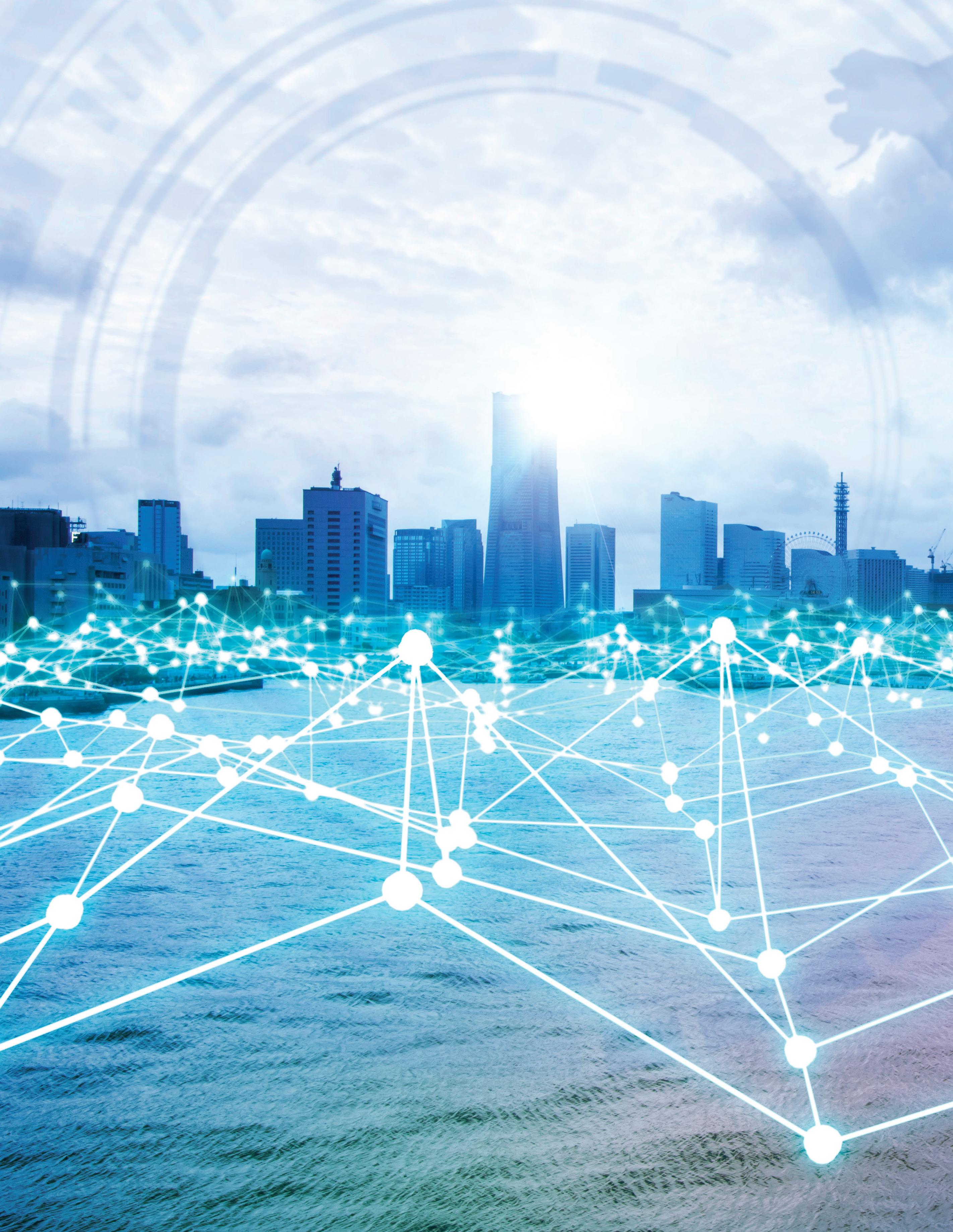


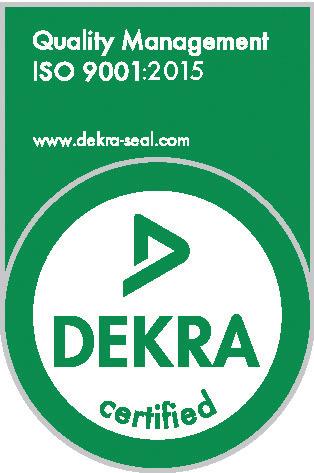

wfnstrategies.com
SPECIAL MARKETS

90 SUBMARINE TELECOMS INDUSTRY REPORT
8

MARKETS
OFFSHORE ENERGY
Thoughts from Greg Otto

Last year continued to be challenging for many indus tries around the world due to the continued COVID-19 pandemic and the realization of many of its longer-term and secondary impacts on the global economy. This year, the Oil & Gas Industry has been further impacted by geopolitical instability (namely the conflict in Ukraine) as well as the continued pressure to move from fossil fuels towards renewable energy sources.
Demand for hydrocarbons is re turning to pre pandemic levels but is still slightly reduced. Production levels are returning to normal
92 SUBMARINE TELECOMS INDUSTRY REPORT
Video 9: Greg Otto, Technical Director - WFN Strategies, LLC
8.1
though overall activity remains low in terms of growth. Despite a 2021 and 2022 jump in oil prices including a significant increase following the invasion of Ukraine, Oil & Gas companies have not shifted more capital to devel oping Oil & Gas fields. Likewise, large telecommunica tion systems have also not been funded and many over the past few years have ceased to be active projects with only a few expansion branches off existing systems being progressed.

This trend is concerning for the long-term growth of submarine fiber for the Oil & Gas Industry as companies look to improve margins, redirect capital to renewable energy and navigate regulatory uncertainty. It is expected that Oil & Gas companies will look to minimize capital spend on telecommunication systems using medium and low earth orbit satellite solutions and occasional branch legs to the most prolific of production facilities. Furthermore, the use of subsea tie backs to existing platforms – many of which already have fiber –
is a strategy employed by many Oil & Gas companies to reduce investment and time to first oil. While there is value in the high capacity, low latency and reliability of submarine fibers, alternatives such as low earth orbit satellite will provide many of their needs to support
SUBMARINE TELECOMS INDUSTRY REPORT 93
0 2 4 6 8 10 20252024202320222021202020192018 FIGURE 71: SYSTEMS BY YEAR 2018-2025 Figure 71: Systems by Year, 2018-2025 SPECIAL MARKETS | OFFSHORE ENERGY Figure 70: World Liquid Fuels Production and Consumption Balance 2017-2023
remote operations, surveillance, IOT and robotics.
BY THE NUMBERS
Before 2019, there were sev eral new systems added around the world, as various offshore energy companies began to realize the benefits of fiber sys tems for their offshore facilities.
However, a dip in oil prices in late 2018 through early 2019 and an overall global economic downturn slowed –or flat out halted – progress on systems starting in 2019 and carried through into 2021 when combined with the pandemic. Even though oil prices rebounded in 2021 and into 2022, it became clear that there is little relationship be tween oil price and investment in submarine fiber systems. This is because there is a focus to improve margin on Oil & Gas production to protect against the perceived volatility in oil price and to generate capital to support alternative energy projects such as wind and solar.
Multiple systems were under consideration in 2019-2021 and much of this work has halted as the new corporate strategies are embedded and realized. What is difficult is to tell is how many projects were actually started “internally” and then shelved during this window as Oil & Gas companies generally do not officially announce these proj ects as they are not core business. As such, the informa tion is expected to no longer be representative of reality and actual deliveries will be much lower.
Going forward, Oil & Gas companies are going to evaluate many factors prior to deciding whether to invest in submarine fiber systems for production facilities:
1. Is the development lifespan long enough (e.g., more
than
years)
2. Are there existing solutions which can be integrated for lower capital?
3. What level of connectivity is really needed?
4. Are there ways to share capital in a low-risk manner?
5. What is the timeline to deliver a submarine system
the lifespan
first oil
94 SUBMARINE TELECOMS INDUSTRY REPORT
15
to payback?
versus
and
SPECIAL MARKETS | OFFSHORE ENERGY 0 1000 2000 3000 4000 5000 20252024202320222021202020192018 FIGURE 72: KMS ADDED BY YEAR 2018-2025 20 40 60 80 100 120 Sep-22Jul-22Apr-22Jan-22Oct-21Jul-21Apr-21Jan-21Oct-20Jul-20Apr-20Jan-20Oct-19Jul-19Apr-19Jan-19Oct-18Jul-18Apr-18Jan-18 FIGURE 73: BRENT CRUDE QUARTERLY PRICE HISTORY 2018-2022 Figure 72: KMs Added by Year, 2018-2025 Figure 73: Brent Crude Quarterly Price History, 2018-2022
This means there will be close examination of alter native solutions such as low and medium earth orbit satellite, use of LTE/5G links to existing and occasional submarine fiber expansion of existing systems. The ex pansion of the existing systems will be aided by situations where a telecommunications company (e.g., Tampnet in North Sea and Gulf of Mexico) will be able to provide the capital and allow companies to buy submarine fiber as a service using operational costs.
Based on publicly available data, it should be ex pected that the growth curve for new fiber will heav ily flatten downwards as the truth of the situation is realized. For example, as costs rise across all industries and regulation on fossil fuels continues to get more stringent, the commercial viability of new offshore development will continue to be less attractive. This is becoming more apparent as companies like ExxonMo bil announce selling of stakes (Johnson, 2021) and the decommissioning of existing facilities. (Jahic, 2022)
More realistically, expect one system every few years with up to five new branches (up to 150 km) in length being added globally. Although the addition of branch es will more likely be in spurts and occur every couple of years as often multiple branches will be integrated into a single campaign for several reasons including optimization of vessel costs such as mobilization and demobilization.
8.1.1 THE OIL BENCHMARK
Looking at the average quarterly price of a barrel of oil over the last five years via the Brent Crude, oil prices reached their peak in the third quarter of 2022 as the im pact of the geopolitical instability in Ukraine on energy prices became apparent. Expectations are that oil prices will be remain volatile due to several factors including:
1. Geopolitical unrest such as Ukraine conflict and other potentials
2. OPEC manipulating the market
3. Government intervention such as the US releasing significant portions of its strategic reserve
4. Regulatory actions to promote alternative energy
5. Seasonal demand changes
6. Recession impacts on personal and corporate demand
All of these will cause temporal changes in the price of oil and maintain volatility. For this reason, the major Oil & Gas companies are planning to always operate on the expectation of low oil prices and take minimal action other than generating profits and capital when prices are high.
8.1.2 DEDICATED VS. MANAGED SYSTEMS
Dedicated systems are those built primarily by one or more Oil & Gas companies to serve their specific offshore facility’s needs. Managed systems are those op erated by a third-party telecoms service provider to one or more Oil & Gas companies’ offshore facilities.
As companies push further out and explore new areas for development, there are fewer shared systems in cluding microwave and LTE/5G. With most growth in offshore energy happening in previously untapped areas that are increasingly further away from established in frastructure, expect the prevalence of dedicated systems to continue as there is often a single operator, especially in the early days of an asset’s development cycle.
When Tampnet acquired the BP GoM offshore cable system in August of 2020 (Tampnet Press Release, 2020), it was speculated that a new trend could be emerging where commercial telecoms companies own and oper ate multiple systems specifically for offshore Oil & Gas clients. One challenge telecommunications companies have is that they need to lock in clients to sanction their investments and projects and Oil & Gas companies make decisions like these over years. This is not conducive to moving such projects forward so many fall off from stag nation and lack of decision. Tampnet acquired an existing system with an installed user base which mitigated the risk that is prevalent in new systems.
8.1.3 OUTLOOK: AN UNCERTAIN FUTURE
There are many factors working against a growth trend in the submarine fiber industry to support offshore Oil & Gas. Predominantly, this is the result of changing strat egy in the operators related to protecting their margin through price volatility, redirecting of capital to alterna tive energy and general concern with the political and regulatory landscape. Some fields and basins where fiber systems have been considered may be put up for sale to lower cost producers which means even less interest in submarine fiber investment. Several states such as Cali fornia here in the United States (Davenport, Friedman, & Plumer, 2022) alongside countries in Europe (Carey & Steitz, 2021) and elsewhere have put forth legislation to ban the future manufacture of any fossil fuel powered vehicles in the coming decades which will further impact the outlook for this industry.
While the Oil & Gas industry is not, if ever, com pletely going away any time soon – as oil is still essential for things like plastic and other modern necessities – the outlook remains clouded and the prospects for submarine fiber continue to trend downwards. ■
SUBMARINE TELECOMS INDUSTRY REPORT 95
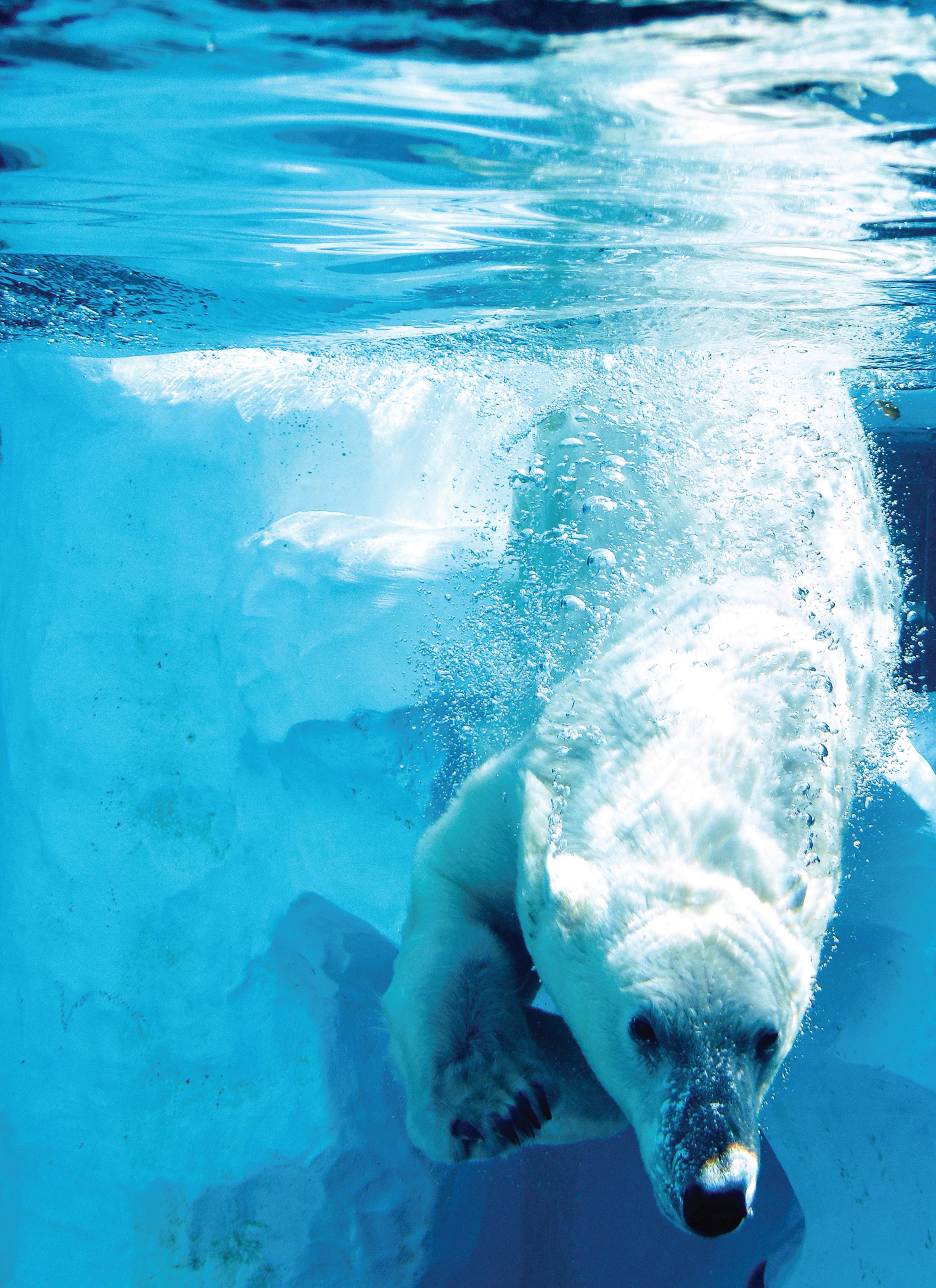
Hexatronic is a reliable partner specializing in submarine fiber optic cables ranging from just a few kilometers up to thousands. We focus on providing customized logistics solutions according to the specific requirements for each project and help you every step of the way. Time and cost efficient solutions Hexatronic offers complete submarine cable solutions and passive fiber infrastructure based on scalable and future proof technology. • Flexible approach for each and every project • High fiber count cables • Fast response, turnaround and delivery times • No project is too big or small • Swedish quality and technical proficiency • Easy to do business with! REACH into the future
SUBMARINE TELECOMS INDUSTRY REPORT 97
UNREPEATERED SYSTEMS
An unrepeated cable system is one that, as the name would suggest, does not incorporate any repeaters between cable landing stations. The signal is pushed directly from landing station to landing station and is therefore limited by how far that signal can reach. As such, most unrepeatered systems are less than 250 kilometers long with a few exceptions. Though the lack of repeaters is a distance limitation, unrepeatered cables can contain higher fiber counts, meaning high er capacity limits. They can also be a less expensive option to a tradi tional repeatered systems depend ing on the amount of armoring re

98 SUBMARINE TELECOMS INDUSTRY REPORT
8.2
Video 10: Anders Ljung, Sales Manager, Submarine Cable Systems – Hexatronic Cables & Interconnect Systems AB
quired, whether burial is required, if a landing station is available or needs to be built, among other factors. But overall, an unrepeatered system can provide a cost savings compared to a terrestrial only route.
Between 2018 and 2022 over three dozen unrepeatered cable systems were declared ready for service, of which ten were lit in 2022. (Figure 74) As unrepeatered systems are not often publicized with the same fervor as long-haul systems, these numbers do not reflect the full extent of the unrepeatered market. Of those publicly revealed, EMEA installed a large majority at 46 percent with new connections between England, Ireland, the Nordics and mainland Europe, as well as short connections in the Mediterranean. AustralAsia in creased their number of unrepeatered systems with 31 percent overall activ ity, and the Americas took 20 percent. The Indian Ocean did not see as many systems with only 3 percent of the overall total. (Figure 75)

In terms of kilometers, 2022 added a similar amount to previous years, as 2021 was an outlier with the addition of the 3,550-kilometer Prat system. As previously stated, most unrepeatered systems are up to 250 kilometers in length, but Prat is a perfect example of the exception to the rule as a Festoon system. A festoon system hops from landing to landing following a coastline to allow for a longer overall system utilizing multiple sections of unre peatered cable with multiple land ings. The signal is then pushed from hop to hop via the landing stations instead of through repeaters.
With 2022 closer in installed kilometers to 2018, 2019, and 2020, it was still a slight increase having add ed over 2,000 kilometers. (Figure 76)
While the EMEA region was responsible for the high est number of new unrepeatered systems, financially, Aus tralAsia received the most at 40 percent of total over the last five years. Subsequently, the Americas region, where
Prat is located, accounted for 30 percent, and EMEA 27 percent. As there were less unrepeatered systems added in the Indian Ocean, they comprised only three percent. (Figure 77)
Over the next four years we can expect to see con tinued growth of unrepeatered systems in EMEA, with their percentage growing to 50 percent of all repeaterless cables installed. A quarter of future unrepeatered systems are expected to be installed in AustralAsia with the re
SUBMARINE TELECOMS INDUSTRY REPORT 99 SPECIAL MARKETS | UNREPEATERED SYSTEMS
0 2 4 6 8 10 20222021202020192018 FIGURE 74: UNREPEATERED SYSTEMS BY YEAR 2018-2022 Figure 74: Unrepeatered Systems by Year, 2018-2022 Indian Ocean EMEA AustralAsia Americas FIGURE 75: UNREPEATERED SYSTEMS BY REGION 2018-2022 46% 31% 20% 3% Figure 75: Unrepeatered Systems by Region, 2018-2022
tions
so

from

100 SUBMARINE TELECOMS INDUSTRY REPORT SPECIAL MARKETS | UNREPEATERED SYSTEMS Indian Ocean EMEA AustralAsia Americas FIGURE 77: UNREPEATERED INVESTMENT BY REGION 2018-2022 30% 3% 27% 40% Figure 77: Unrepeatered Investment by Region, 2018-2022 0 1000 2000 3000 4000 5000 6000 7000 8000 2022'2021202020192018 FIGURE 76: UNREPEATERED KMS BY YEAR 2018-2022 Figure 76: Unrepeatered KMS by Year, 2018-2022 maining 25 percent split between the Americas and AustralAsia. (Figure 78) SubTel Forum will continue to highlight the unrepeatered submarine cable market to bring awareness to that subsection of the industry. Doing
allows vendors and suppliers to provide accurate information about their portion of the market as well as connections to developing loca
that might benefit
a less traditional system. ■ Indian Ocean EMEA AustralAsia Americas FIGURE 78: UNREPEATERED PLANNED SYSTEMS BY REGION 2022-2025 25% 17% 8% 50%Figure 78: Unrepeat ered Planned Systems by Region, 2022-2025
SPECIALIZED TECHNOLOGIES
Within the Submarine Cable Industry, it would not be an exaggeration to say that the first significant technology that comes to mind is the cable. Heck, it’s in the name. Lower latency, higher fiber pairs, zero attenuation: these are the technology dreams of the industry. But what about all the other subsea technologies that are groundbreaking and going into implementation all over the world?
Companies in many fields are developing new technol ogies that are currently or will have significant influence over the future of the Submarine Cable Industry and all subsea industries.

SEA-KIT International’s Uncrewed Surface Ves sel (USV) Maxlimer was recently used to complete an initial survey of Hunga-Tonga Hunga-Ha’apai, a submarine volcano in the South Pacific. In other areas, cable segments from Tampnet are being used as part of a seismic monitoring system, assisting in early earthquake warnings.
“The market for subsea technologies appears to be
expanding, and that growth is expected to continue in the next five years,” said a representative of Makai Ocean En gineering. “We believe there will be significant emphasis in automation and clean energy within the coming years.”
To learn more about the current climate and expected development of this alternative side of the industry, Sub marine Technologies Forum reached out to companies spearheading these developments to get a more personal take on where the industry and technology is, and where it’s going.
For this industry report, we heard from Tampnet and Makai Ocean Engineering. We asked a batch of ques tions regarding their company, and where they believe the industry is heading.
Tampnet is a company founded in 2001 in Stavanger, Norway, according to the company website. It runs “the world’s largest offshore high-capacity communication network in the North Sea and the Gulf of Mexico, serv ing customers within oil & gas, wind energy, maritime and carrier sectors with first class telecommunications.”
SUBMARINE TELECOMS INDUSTRY REPORT 101
8.3
Alternately, Makai Ocean Engineering (Makai) is a technology company founded in 1973 on the Makai Research Pier in Waimanalo, Hawaii. “Our clients have referred to us as a “think tank” for ocean-related prob lems, owing to our reputation for being innovative, fast, and thorough in our designs.”
Makai provides practical solutions and technologies to solve real world challenges. Makai provides ocean engineering software solutions. “Our subsea cable soft ware has been used on several record breaking projects,” said Makai in the Q&A. “The most recent memorable achievement is that our subsea cable software, MakaiLay, is now used by over 90 percent of the subsea telecom cable installation fleet.”
Companies in the Ocean Technology business will have wide ranging types of projects, including unique survey projects, unmanned drones exploring dangerous areas, or many other projects. When asked about some of their most memorable application of their technology in a project, both companies recalled very different, but fascinating events.
Tampnet related a time that their technology came through in a pinch during a storm:
“The most memorable moment was in 2013, when our first commercial customer on our 4G/LTE network had to prematurely cut across from their legacy VSAT satellite connection to shore to our new 4G/LTE system that was just being commissioned onboard. This happened during a very strong storm, with 23m wave height in the North Sea causing their satellite antenna to get damaged and misaligned to the degree that they lost communications.
“The consequence was that in the middle of this storm the offshore asset went from a very poor quality VSAT with just a few Mbps and more than 500ms delay on the link to shore, to an extremely stable 30Mbps connection with less than 40ms delay carried through our 4G and subsea fibre network. The crew was blown away and could not understand why they all of a sudden had a blazing fast and rock-solid connection to shore in the middle of one of the worst storms in the history of their operations in the North Sea!
Makai, on the other hand, shared a time where their application of a new energy technology created a pi oneering step in green energy: “In 2015 Makai made history by connecting our pilot OTEC plant to the U.S. grid, marking the first time baseload renewable energy from OTEC fed the U.S. electrical grid. This was a mo mentous achievement that proved that OTEC is a viable energy source for portions of the U.S.
“Makai has also long been a proponent and leader for
marine renewable energy technologies like Seawater Air Conditioning (SWAC) and Ocean Thermal Energy Con version (OTEC). Makai will continue to advance these technologies globally to meet renewable energy goals.”
Possibly because of the two companies’ very different focuses, when asked where they see their industry in the next five years, their answers were equally different.
According to Makai, they believe that there will be significant focus on automation and on green energy. In the same vein, when asked about the growing relevance of sustainability in the industry, the Makai representa tive answered, “Makai is also developing new tools and technologies to support the greater offshore renewable energy markets with a near term focus on offshore wind. Makai’s technologies will help advance and support the growing offshore wind market, with tools to help in the planning and hardware technologies to reduce the cost of installation.”
When answering the same question, the Tampnet rep resentative said, “The basics of subsea technology will re main the same, with submarine fibre optic cables carrying the vast majority of the world´s communications.” They added, however, that the speed of technology’s develop ment and evolving capabilities of transmission technolo gy connected to cable systems could possible capacity and speed “is increasing at a mind-blowing speed.”
“Today, a single strand of fibre can carry many terabits of data per second. This evolution is likely to continue. In addition to this, we are seeing new uses for our subsea cables, where the cable or fibre cores inside of it is being used for new scientific purposes,” said Tampnet.
As an example, they mention the use of cables fitted with monitoring equipment for seismic and earthquake detection. “Another application is to use the cable to monitor for potential hazards, protecting the cable itself.,” They add. “By placing acoustic sensing equipment on fibre cores, the fibers behave as very long microphones, picking up noise along the cable. This can be used to detect excavators on land, and fishing trawlers dragging on the seabed, alerting the cable owner of any potential dangers to the cable’s integrity.”
Input from companies like this gives us a unique look into the developing world of ocean technology and its many facets. While there may not always be direct overlap between some technologies and the large cable systems, there is not denying the potential benefit new developments could have down the line on the overall industry. There may come a time where the cable infra structure crisscrossing the globe serves several purposes beyond just data transmission. ■
102 SUBMARINE TELECOMS INDUSTRY REPORT
SPECIAL MARKETS | SPECIALIZED TECHNOLOGIES
SUSTAINABILITY IN SUBSEA

PERSPECTIVES OF GEORGE RAMÍREZ, NICOLE STAROSIELSKI, AND HUNTER VAUGHAN
Digital networks and telecom munications technologies impact the environment. They require the use of elec tricity, the manufacturing and deployment of equipment, and the disposal of waste, all of which emit carbon into our atmosphere. While subsea cables have a very small carbon footprint compared to much internet infrastructure, the industry has nonetheless taken part in sustainability initiatives, and these initiatives provide in sight on ways to mitigate the envi ronmental impacts of the Internet as a whole. Whether it is through combating the carbon intensity of our vessels, strategizing cable recycling, or installing renewable energy, addressing the sustainability of our industry can help us think across sectors and determine best practices and models for the future.
One place that companies have been considering sustainability has been in everyday operations. Orange Marine and Global Marine, for example, power some of
SUBMARINE TELECOMS INDUSTRY REPORT 103
8.4
Video 11: George Ramírez, Research Assistant for Sustainable Subsea Network –SubOptic Foundation
their ships using the landside electrical grid. The New Jersey Fiber Exchange decided to power its station us ing carbon neutral energy. Landing stations have been equipped with cooling units and LED lights, while en ergy from customer equipment has been used for heat. Cable companies that are limited by geographic and economic resources have still found ways to contribute to decarbonization. The Solomon Islands Submarine Cable Company developed new sustainability initia tives, encouraging employees to turn off devices in of fices when not in use, reducing water consumption, and tracking energy usage. While these actions offer small reductions, they make a significant difference when enacted across the network. Some of these changes are motivated by policy and green finance while others are simply driven by individuals in a company. We rec ommend that submarine cable companies think about their operational landscape as a pathway to a more sustainable future.
One of the easiest ways to minimize emissions is to switch to remote meetings. We have found many compa nies have already made this shift--although some meet ings still benefit from in-person presence. Reducing air travel has made a significant reduction in the subsea cable industry’s footprint. The Sustainable Subsea Networks (SSN) team estimates that a single consortium system can avoid the equivalent of 154 gasoline-powered passen ger vehicles driven for one year, or 792,522 tons of coal burned. The SSN team has created a Carbon Emissions Savings Calculator that helps determine the emissions saved by transitioning to remote meetings. Because the industry’s work helps other industries to decrease their air travel, subsea cables can contribute to emissions reduc tion across sectors.
A second avenue to sustainability has been in de ploying new installations (including renewable energy) and retrofitting old ones. There is no universal solution to sustainability, and new developments must consider potential geographic and cultural roadblocks. The path to greening a cable landing station, for example, may not be straightforward, but consulting companies have begun advising their customers in ways that map new possibilities to existing infrastructure and standards. This year we had a chance to review the work by R&G Telecom to advise companies to exercise sustainability by installing new cooling systems, upgrading equip ment, and repurposing hardware. It is best to leverage geographic, environmental, and economic resources already present in a facility in order to minimize waste and costs. As a result, we have found that sustainability can drive innovation. We recommend that the sub
sea cable industry consider the geographic, economic, and regulatory constraints as parameters to maximize sustainability.
Subsea cable companies do a great job in collecting data, but sharing this information is crucial to creating change within the industry. Developing a standard to calculate our carbon footprint will not only keep track of our impact on the climate, but it will also prepare the industry for regulation that requires tracking this information. We are in a position to advocate for regu latory guidelines that can inform environmental policy decisions in ways that keeps competition among peer organizations. The SSN research initiative and WFN Strategies are currently developing a carbon model for emissions. It will break down the total impacts of a cable system into 1) manufacturing and materials, 2) planning, installation, and maintenance, and 3) operational energy requirements, all amortized over the years of a cable’s operational life, and with added the potential to recoup embodied materials emissions through end-of-life recycling. This, in addition to holding remote meetings, reducing distance traveled by ships, optimizing fuel consumption, using less cable armoring, and a transition to green energy are all significant for sustainable investment. Collecting and sharing data will help us identify and specify the relative merits of these choices. We recommend that the industry engage with and iterate on such models to inform the design of new cable systems and the retire ment of old ones.
Sustainability is increasingly a concern in the subsea cable industry. Companies are reducing carbon emis sions by making changes across their operations. A sus tainable disposition to infrastructure repair and upgrade is shaping innovation at the cable landing point. Even small changes like having remote meetings whenever possible is minimizing greenhouse gasses. To maximize the industry’s sustainable impact, data should be shared with fellow companies to standardize cable system design. And because subsea cables already emit minimal amounts of carbon, laying more cables to storage in greener parts of the planet can also make the wider ICT industry more sustainable.
For more information, please visit the Sustainable Subsea articles from this year:
• A Blue Industry Going Green
• Energy and Telecommunications
• Flying the Skies to Wire the Seas
• Calculating a Subsea Footprint
• More Cables = Less Carbon? ■
104 SUBMARINE TELECOMS INDUSTRY REPORT
SPECIAL MARKETS | SUSTAINABILITY IN SUBSEA
SUBMARINE TELECOMS INDUSTRY REPORT 105 SUSTAINABILITY IS INCREASINGLY A CONCERN IN THE SUBSEA CABLE INDUSTRY. COMPANIES ARE REDUCING CARBON EMISSIONS BY MAKING CHANGES ACROSS THEIR OPERATIONS. A SUSTAINABLE DISPOSITION TO INFRASTRUCTURE REPAIR AND UPGRADE IS SHAPING INNOVATION AT THE CABLE LANDING POINT. EVEN SMALL CHANGES LIKE HAVING REMOTE MEETINGS WHENEVER POSSIBLE IS MINIMIZING GREENHOUSE GASSES.
REGIONAL ANALYSIS9

106 SUBMARINE TELECOMS INDUSTRY REPORT
ANALYSIS AND CAPACITY OUTLOOK

Video
12: Kieran Clark, Analyst – Submarine Telecoms Forum, Inc.
The submarine fiber market continues to grow through 2022 at a similar rate to that observed since 2016. Some regions have begun to slow their pace with fewer systems planned beyond 2022, while other regions are seeing a substantial increase to their overall system count through to 2025. There are some overbuild concerns considering the rapid pace of system development over the last few years, but many cable systems are reaching the end of their economic and technological lifespans and will need replacing.
Business models around the world are changing, as more of the submarine fiber industry is driven by Hy perscaler infrastructure needs and the desire to connect data centers rather than population centers. The bulk of Hyperscaler infrastructure and major data center clus ters are currently located in the United States, Europe, East Asia, and South America. As a result, the regions most affected by this trend are the Transatlantic, Trans pacific, and Americas regions. (SubTel Forum Analytics Division of Submarine Telecoms Forum, Inc., 2020)
108 SUBMARINE TELECOMS INDUSTRY REPORT REGIONAL ANALYSIS AND CAPACITY OUTLOOK | TRANSATLANTIC REGION TRANSATLANTIC REGION REGIONAL SNAPSHOT: Current Systems: 19 Capacity: 970 Tbps Planned Systems: 4 Planned Capacity: 782 Tbps
SUBMARINE TELECOMS INDUSTRY REPORT 109
9.1.1 CURRENT SYSTEMS
Growth on the Transatlantic route skyrock eted from the late 1990s through 2003. After a 12-year drought, the Transatlantic region added a new cable every year from 2015 to 2018. After a brief respite in 2019, the Trans atlantic region is back to pushing forward with strong momentum. (Figure 79)
Two major causes of the development slow down were a glut of capacity and the financial crash of the early 2000s which was brought on by overinvestment in the submarine cable industry. With investment on the rise again, and systems aging out in the Transatlantic route, new systems are beginning to come online. The MAREA system installed in 2017 tapped into the exploding demand from Hy perscalers, with one of the key selling points being massive bandwidth available — 200 Tbps poten tial — on a modern submarine fiber system on a route full of aging cables. Additionally, this cable – along with Dunant cable installed last year — provide an alternative path to increase route diversity, and more directly connect Europe to important data centers in Ashburn, Virginia.
The SACS and SAIL cables installed in 2018 potentially indicated an increased desire to South America and Af rica directly but this has not seen sustained momentum. Additionally, to further connect South America with other areas of the world, 2021 saw the addition of the EllaLink system that branches across other areas of the continent before traveling north to Europe.
Due to increasing capacity demands along the north Transatlantic between New York and Europe and the desire for new connections to the Mid-Atlantic of the
United States and across the South Atlantic, the Transat lantic route has enjoyed steady growth with two Hyper scaler systems – Grace Hopper and Amitié – entering service this year.
9.1.2 FUTURE SYSTEMS
During the initial boom of Transatlantic system de velopment, the average system length was 12,000 kilo meters with most systems taking similar routes between Europe and the US. Overall, this average has gone down significantly with the average length of Transatlantic planned systems now as low as 8,000 kilometers. This has been due to the new Hyperscaler systems that seek to provide more direct routes between their data center facilities rather than worrying about connecting to a major city first.
110 SUBMARINE TELECOMS INDUSTRY REPORT
TABLE 5: TRANSATLANTIC SYSTEMS, 2012-PRESENT RFS YEAR SYSTEM CAPACITY (TBPS) LENGTH (KMS) 2015 EXA Express 53 4600 2016 AEC-1 78 5536 2017 MAREA 209.6 6600 2018 SACS 32 6000 2018 SAIL 40 6209 2020 HAVFRUE/AEC-2 108 7300 2021 EllaLink 72 9300 2021 Dunant 250 6600 10 15 20 25 20252024202320222021202020192018201720162015201420132012 FIGURE 79: IN SERVICE & PLANNED TRANSATLANTIC SYSTEMS 2012-2025 Figure 79: In-Service & Planned Transatlantic Systems, 2012-2025 REGIONAL ANALYSIS AND CAPACITY OUTLOOK | TRANSATLANTIC REGION
While there was a notable rise in demand for routes away from the traditional New York-Lon don, the Amitié and Grace Hopper cables created additional connections along this route, highlighting its continued importance. (Figure 80) The change in customer requirements from purely bandwidth to bandwidth and low latency has driven developers to plan routes averaging 18 percent shorter than previous systems from the early 2000s. New systems in the Transat lantic boast significant capacity increases with both systems entering service this year adding a combined 670 Tbps – increasing the existing Transatlantic capacity by nearly 70 percent.
There are currently four planned systems set to be ready for service for the period 2022 to 2025 in the Transatlantic region. Two of these systems follow the traditional route between Europe and the United States, showing that this connection still has great importance despite changing network trends. Another planned sys tem stretches from Virginia Beach, Virginia in the United States all the way to South Africa. The last planned system for the Transatlantic connects Northern Canada to Norway, blazing an entirely new trail.
Three of the four planned Transatlantic systems have achieved the all-important CIF milestone. (Figure 81) This indicates growth in this region continues to remain strong. Consid ering the amount of data that travels between Europe and North America, this is very unlikely to change moving forward. ■

SUBMARINE TELECOMS INDUSTRY REPORT 111
TABLE 6: TRANSATLANTIC PLANNED SYSTEMS RFS YEAR SYSTEM CAPACITY (TBPS) LENGTH (KMS) 2022 Grace Hopper 352 7191 2022 Amitie 322 7292 2023 SAEX West 108 14720 2024 Leif Erikson 4100 100,000 150,000 200,000 20252024202320222021202020192018201720162015201420132012 FIGURE 80: TOTAL KMS IN SERVICE & PLANNED TRANSATLANTIC SYSTEMS 2012-2025 No Yes FIGURE 81: CONTRACT IN FORCE - TRANSATLANTIC 2022-2025 75% 25% Figure 80: Total KMs In-Service & Planned – Transatlantic, 2012-2025 Figure 81: Contract in Force – Transatlantic, 2022-2025
The Transpacific market had historically been like that of the Transatlantic, showing little growth year-upon-year. Just like the Trans atlantic, however, the Transpacific region has seen a noticeable uptick in activity recently. Hyperscalers and those seeking route diversity have been the primary drivers behind new system growth in this region.
112 SUBMARINE TELECOMS INDUSTRY REPORT TRANSPACIFIC REGION REGIONAL SNAPSHOT: Current Systems: 15 Capacity: 742 Tbps Planned Systems: 9 Planned Capacity: 1112 Tbps
REGIONAL ANALYSIS AND CAPACITY OUTLOOK | TRANSPACIFIC REGION
SUBMARINE TELECOMS INDUSTRY REPORT 113
9.2.1 CURRENT SYSTEMS
From 2002 to 2016, only four systems were added to the region. (Figure 82) The industry crash of the early 2000s certainly played a large part in this limited growth, but the fact that there had been no new systems on the Transpacific routes from 2010 to 2016 is largely due to existing systems being able to upgrade their capacity for relatively little cost and push potential competitors out of the market.
As with the Transatlantic market, until very recently the Transpacific has been almost fully saturated, with little room for growth other than route diversity and cutting down on existing latency. Lately, however, new systems are being explored in a similar manner to the Transatlantic with the region seeing at least one new cable every year since 2016, with a similar pause in 2019 and an additional pause in 2021. Demand from Hyperscalers, desire for route diversity and replacement of aging infrastructure are the primary drivers behind these newer Transpacific systems. As a result, several new systems are planned through to 2025.
9.2.2 FUTURE SYSTEMS
No systems were added at all to this region from 2010 to 2016. Since then, the region has experienced steady growth with at least one system added each year for the period 2016 to 2019 and nine systems planned through 2025.
The amount of cable in the region increased by 79 per cent during this period of growth - adding over 120,000 kilometers of cable between 2016 and 2020. (Figure 83)
Average system length in the region is just over 15,400 kilometers, owing to the Transpacific region having some of the longest routes in the world. Between the mas sive systems required to span the region, and the easy availability of cheap capacity upgrades, the historically static nature of the region comes as no surprise. Recently, however, there has been a noticeable uptick in system activity driven by the large increase in bandwidth de mand brought about by Hyperscalers and the continued adoption of cloud services.
There are currently nine planned systems set to be ready for service for the period 2022 to 2025 and 44 percent of them have achieved the CIF milestone – down only slightly from last year’s 50 percent. (Figure 84) Nearly all these systems are trying to bring large capacity increases along their respective routes, but many of them
114 SUBMARINE TELECOMS INDUSTRY REPORT
Figure
82:
In-Service & Planned Systems – Transpacific,
2012-2025 TABLE 7: TRANSPACIFIC SYSTEMS, 2012-PRESENT RFS YEAR SYSTEM CAPACITY (TBPS) LENGTH (KMS) 2016 Faster 60 11629 2017 SEA-US 35 14500 2018 Hawaiki 85 15000 2018 NCP 70 13618 2020 PLCN 144 12900 2022 Jupiter 60 14577 2022 Southern Cross NEXT 72 15840 5 10 15 20 25 20252024202320222021202020192018201720162015201420132012 FIGURE 82: IN SERVICE & PLANNED TRANSPACIFIC SYSTEMS 2012-2025 REGIONAL ANALYSIS AND CAPACITY OUTLOOK | TRANSPACIFIC REGION
directly competing along the same or similar routes. With the average system length of all planned systems for the Trans pacific market at just over 13,850 kilome ters shorter route lengths and lower latency are also important factors for new systems. These new systems provide a bonus of increased route diversity – especially along the southern part of the region. A few of the systems that are not yet CIF are backed by Hyperscalers. This takes them out of direct competition with other planned systems and removes some of the financial risk from having to sign on outside inves tors. As development in the Transpacific has seen renewed interest brought on by increased bandwidth demand from cloud services, expect this region to see similarly high rates of growth as the Transatlantic.

SUBMARINE TELECOMS INDUSTRY REPORT 115 are
■ Figure 83: Total KMs In-Service & Planned – Transpacific 2012-2025 Figure 84: Contract in Force – Transpacific, 2022-2025 TABLE 8: TRANSPACIFIC PLANNED SYSTEMS RFS YEAR SYSTEM CAPACITY (TBPS) LENGTH (KMS) 2022 H2 Cable 20 10500 2022 CAP-1 108 11806 2023 Echo 144 17184 2023 TOPAZ 240 7000 2023 ACC-1 18000 2024 HCS 13180 2024 Bifrost 15000 2024 JUNO 360 10000 2025 Hawaiki Nui 240 22000 150,000 200,000 250,000 300,000 350,000 400,000 20252024202320222021202020192018201720162015201420132012 FIGURE 83: TOTAL KMS IN SERVICE & PLANNED TRANSPACIFIC SYSTEMS 2012-2025 No Yes FIGURE 84: CONTRACT IN FORCE - TRANSPACIFIC 2022-2025 44% 56%
116 SUBMARINE TELECOMS INDUSTRY REPORT REGIONAL ANALYSIS AND CAPACITY OUTLOOK | AMERICAS REGION AMERICAS REGION REGIONAL SNAPSHOT: Current Systems: 83 Capacity: 1109 Tbps Planned Systems: 14 Planned Capacity: 1112 Tbps
SUBMARINE TELECOMS INDUSTRY REPORT 117
9.3.1 CURRENT SYSTEMS

Characterized by steady growth since the early 1990s, the Americas region has contin ued to enjoy frequent additions over the last 10 years – going from 53 cables in 2012 to 83 cables in 2022.
After 10 years of steady growth, with an average of about two systems being ready for service per year, the region is currently undergoing another boom in development with seven systems implemented in 2019, four in 2020, four in 2021, and three additional systems to be ready for service by the end of 2022. (Figure 85)
9.3.2 FUTURE SYSTEMS
Unlike most of the other markets, the Americas region has consistently observed medium to high levels of growth.
Since 2005, new cable development has consistently added an average of 5 percent more kilometers per year. Departing from this trend, there was a 7 percent increase in 2009, a 10 percent increase in 2014, an 11.7 percent increase in 2017 and a 6 percent increase in 2019. The region has seen steady growth until 2017 when an unprecedented 11.7 percent growth rate was observed. Since 2019, average kilometers added has re mained at around 5 percent growth annually and there is no indication this will change significantly. (Figure 86)
There are currently 14 systems planned through to 2025 and 64 percent of those cables have achieved their CIF milestone. (Figure 87) This indicates there is continued potential for steady growth in this region. However, with increasing economic and polit ical instability throughout the Americas, there is a possibility – though small – that some planned systems may come across addition al difficulties as they progress through their development process. ■
118 SUBMARINE TELECOMS INDUSTRY REPORT
REGIONAL ANALYSIS AND CAPACITY OUTLOOK | AMERICAS REGION 5 10 15 20 25 20252024202320222021202020192018201720162015201420132012 FIGURE 82: IN SERVICE & PLANNED TRANSPACIFIC SYSTEMS 2012-2025 150,000 200,000 250,000 300,000 20252024202320222021202020192018201720162015201420132012 FIGURE 86: TOTAL KMS IN SERVICE & PLANNED AMERICAS SYSTEMS 2012-2025 No Yes 36% 64% FIGURE 87: CONTRACT IN FORCE - AMERICAS 2022-2025 Figure 85: In-Service & Planned Systems – Americas, 2012-2025 Figure 86: Total KMS In-Service & Planned – Americas, 2012-2025 Figure 87: Contract in Force – Americas, 2022-2025
2012 Estrecho de Magallanes
SW
53
TT-1 48
ALBA-1
1600
LCMSSCS 322
Saint Thomas - Saint Croix System 183
AMX-1
17800
PCCS 45 6000
FOS Quellon-Chacabuco 350
Segunda FOS Canal de Chacao 40
Guantanamo Bay Cable 1500
Canal Fiber 138
Sea2Shore 32
Monet
Tannat
10556
2000
Junior 390
Seabras-1
10750
SEUL 24
BRUSA
11000
Saint Pierre and Miquelon Cable 200
Curie
Crosslake Fibre
Guantanamo Bay Cable
Kanawa
10476
1200
1746
X-Link Submarine Cable 775
Tannat
KetchCan1
Malbec
2900
TABLE 9: AMERICAS SYSTEMS, 2012-PRESENT RFS YEAR SYSTEM CAPACITY (TBPS) LENGTH (KMS)
1.8 37 2012 AUTA
2012 TERRA
2012
2013
5.12
2013
2013
2014
50
2015
2015
2015
2016
2016 Lynn
2016
2017
60
2017
90
2017
2017
72
2017
2018
160
2018
2019
72
2019
2400 62 2019
2
2019
10
2019 CARCIP 225 2019 RedeIlhabela-1 3 2019
2020
Extension 90 2020 FOA 16
2020
23.04 167 2020 GCIS 118 2021
108 2600 2021 SPSC/Mistral 132 7300 2021 Curie Panama Extension 72 1073 2021 Prat 9.6 3550
TABLE 10: AMERICAS PLANNED SYSTEMS
WALL-LI 125
GigNet-1 1200
SeaLink 214
Galapagos Subsea System 20 1280
Connected Coast 3400
AU-Aleutian 860
Boriken Submarine Cable System 670
Confluence-1 500 2571
Firmina
Cuba to Martinique 2470
SednaLink 1904
CSN-1 4500
CX 20 3472
Deep Blue One 12 2000
120 SUBMARINE TELECOMS INDUSTRY REPORT
RFS YEAR SYSTEM CAPACITY (TBPS) LENGTH (KMS) 2022
2022
2022
2023
2023
2023
2023
2023
2023
2023
2023
2023
2024
2024
REGIONAL ANALYSIS AND CAPACITY OUTLOOK | AMERICAS REGION
SUBMARINE TELECOMS INDUSTRY REPORT 121
UNLIKE MOST OF THE OTHER MARKETS, THE AMERICAS REGION HAS CONSISTENTLY OBSERVED MEDIUM TO HIGH LEVELS OF GROWTH.
REGIONAL ANALYSIS AND CAPACITY OUTLOOK | AUSTRALASIA REGION 122 SUBMARINE TELECOMS INDUSTRY REPORT REGIONAL ANALYSIS AND CAPACITY OUTLOOK | AUSTRALASIA REGION AUSTRALASIA REGION REGIONAL SNAPSHOT: Current Systems: 105 Capacity: 1161 Tbps Planned Systems: 19 Planned Capacity: 1039 Tbps
SUBMARINE TELECOMS INDUSTRY REPORT 123
9.4.1 CURRENT SYSTEMS
The AustralAsia market has been character ized by a massive amount of growth in a rela tively short amount of time. Since 2008, it has been one of the busiest regions in the entire world – only seeing three years with reduced expansion, from 2010 to 2012.
Growth from 2001 to 2005 was negligible, and while there was a moderate amount of activ ity in 2006, the real growth spurt occurred from 2008 to 2009. (Figure 88) The biggest factor contributing to growth in the region is emerging markets in Southeast Asia, with countries such as Indonesia, Singapore, and Hong Kong being the recipients of new data center growth as mentioned in section 1.4 of this report.
The industry crash of the early 2000s
influenced the later timing of the re gion’s boom, but the rising markets of Southeast Asia and their ardent desire for international connectivity overrode such concerns. The widespread adoption of mobile and cloud services throughout the region combined with the recent surge of Hyperscaler driven systems promises to sustain growth in the region for the foreseeable future.
9.4.2 FUTURE SYSTEMS
the amount
added per year.
amount
has seen an average of 17,000
124 SUBMARINE TELECOMS INDUSTRY REPORT
certainly
After the huge growth spurt from 2008 to 2009, the AustralAsia market has seen a steady
of growth in
of cable
Since 2012, the region
TABLE 11: AUSTRALASIA SYSTEMS, 2012-PRESENT RFS YEAR SYSTEM CAPACITY (TBPS) LENGTH (KMS) 2012 Tonga-Fiji 827 2012 Cross Straits Cable Network 21 2012 B3JS 1031 2013 TPKM-3 2013 ASE 15.36 7200 2013 SJC 28 8986 2013 GOKI 0.08 4200 2013 TSE-1 6.4 270 2013 BPSCS 19.2 332 2013 JBCS 40 2014 Western Visayas-Palawan 300 2014 ICN1 0.32 1259 2014 JIBA 267 2014 Palawa-Iloilo Cable System 300 2014 PNG LNG 200 2014 SBCS 57 2014 TSCS 83 2015 BLAST 250 Figure 88: In-Service & Planned Systems - AustralAsia 2012-2025 REGIONAL ANALYSIS AND CAPACITY OUTLOOK | AUSTRALASIA REGION 30 60 90 120 150 20252024202320222021202020192018201720162015201420132012 FIGURE 88: IN SERVICE & PLANNED AUSTRALASIA SYSTEMS 2012-2025
2015 SMPCS 40 2000
2015 Far East 1.6 1844
2015 LTCS 446
2016 APG 54 10400
BALOK 50
NWCS 12 2100
2016 SEA-ME-WE 5 38 20000
2017 MCT 30 1425
2017 ATISA 7.2 280
2017 Tasman Global Access 20 2300
2017 SKR1M 6 3500
2017 Palapa W 1725
LBC 9.6 52
2018 Tui Samoa 17.6 1410
2018 SEAX-1 250
2018 ASC 60 4600
2018 NATITUA 10 2500
2018 Palapa E 6878
2018 Palapa M 2100
SUSP 127
SSSFOIP 307.2 21
IGG 5300
JAYABAYA 915
TDCE 40 390
Indigo West 36 4600
Indigo Central 36 4850
Coral Sea 20 4700
Chuuk-Pohnpei Cable 1200
PASULI 40
Tanjun Pandan-Sungai Kakap Cable 348
JGA North 28.8 2700
Okinawa Cellular Cable 80 760
Manatua One 10 3634
JGA South 36 7000
DAMAI Cable System 575
MSC 0.1 840
CDSCN 0.8 1824
H2HE 300 675
SKKL LABUAN BAJO-RABA 152
KSCN 5457
BaSIC 2 762
BALOM 146
SUBMARINE TELECOMS INDUSTRY REPORT 125
2016
2016
2017
2018
2018
2018
2018
2018
2019
2019
2019
2019
2019
2019
2020
2020
2020
2020
2020
2021
2021
2021
2021
2022
2022
2022
kilometers added per year, with an average system length of 2,830 kilometers. As submarine cable
typically require a two-year development cycle from the time they are announced, it is unlikely many systems will be an nounced for 2024 by the end of this year, and any further system development will occur in 2025 or later.
are currently 19 planned systems set to be ready for service for the period 2022 to 2025. As is normally the
case with the AustralAsia region, several of these systems

smaller in scope connecting island nations to major hubs while the other cables span large swathes of the region or are backed by Hyperscalers. Of these planned systems, 53 percent are considered CIF – a noticeable increase from last year’s 42 percent. (Figure 90) With more than half of the 19 systems planned through 2025 already CIF, this in dicates that the region can still support increased growth.

126 SUBMARINE TELECOMS INDUSTRY REPORT
systems
There
are
■ 100,000 200,000 300,000 400,000 500,000 20252024202320222021202020192018201720162015201420132012 FIGURE 89: TOTAL KMS IN SERVICE & PLANNED AUSTRALASIA SYSTEMS 2012-2025 No Yes 47% 53% FIGURE 90: CONTRACT IN FORCE - AUSTRALASIA 2022-2025 Figure 89: Total KMs In-Service & Planned - AustralAsia 2012-2025 Figure 90: Contract in Force – AustralAsia, 2022-2025 TABLE 12: AUSTRALASIA PLANNED SYSTEMS RFS YEAR SYSTEM CAPACITY (TBPS) LENGTH (KMS) 2022 PEACE 192 25000 2022 OAC 39 9800 2022 HK-G 48 3700 2022 SJC2 144 10500 2022 SIGMAR 2200 2022 Tokelau Domestic Submarine Cable 20 250 2022 PC2 110 2022 TLSSC 2022 Gondwana 2 and Picot 2 1515 2023 Project Koete 60 800 2023 ADC 140 9800 2023 DJSC 40 1000 2023 PDSCN 2500 2024 Apricot 190 12000 2024 VCS 3400 2024 SEA-H2X 160 5000 2025 SEA-ME-WE 6 6 19200 REGIONAL ANALYSIS AND CAPACITY OUTLOOK | AUSTRALASIA REGION
SUBMARINE TELECOMS INDUSTRY REPORT 127
THE AUSTRALASIA MARKET HAS BEEN CHARACTERIZED BY A MASSIVE AMOUNT OF GROWTH IN A RELATIVELY SHORT AMOUNT OF TIME. SINCE 2008, IT HAS BEEN ONE OF THE BUSIEST REGIONS IN THE ENTIRE WORLD.
128 SUBMARINE TELECOMS INDUSTRY REPORT REGIONAL ANALYSIS AND CAPACITY OUTLOOK | EMEA REGION EMEA REGION REGIONAL SNAPSHOT: Current Systems: 199 Capacity: 1920 Tbps Planned Systems: 23 Planned Capacity: 2348 Tbps
SUBMARINE TELECOMS INDUSTRY REPORT 129
9.5.1 CURRENT SYSTEMS
Characterized by steady growth since the early 1990s, Europe, the Middle East and Africa have all seen an increase in de velopment over recent years. This has been one of the most consistent growth regions in the world, owing to its size as well as the important “crossroads” of the Mediter ranean Sea and the Suez Canal.
While system count has remained steady – with an average of five systems ready for service every year since 2002 – with 2011 seeing the largest surge of 14 new systems – the actual lengths of these systems can vary. (Figure 91) The primary factor behind these growth spurts are the SEA-ME-WE systems, as well as large coastal systems ringing Africa. In actual number of sys tems accomplished, the EMEA region is the most consistent region in the world. It has a growth pattern that is seemingly immune to the industry’s boom and bust pattern seen over the past 15 years.
The EMEA region sees a consistent, annual addi tion of smaller regional systems. These complement the large, multi-region projects like SEA-ME-WE, ACE, EIG, and WACS to name a few. These large projects span multiple regions of the world, rather than smaller, inter-country routes and are the biggest projects the in dustry tackles. Each system of this kind comes in at well over 10,000 kilometers per route — sometimes beyond 20,000 and 25,000 kilometers. Despite the steady system
count, inter-regional projects like this cause a huge surge in kilometers installed with 2010 to 2012 seeing the most recent growth spurt for the region.
9.5.2 FUTURE SYSTEMS
EMEA
uniquely
as a region of steady activity, with bursts of highly ambitious, region-spanning systems every few years.
rate of kilometers added per year shows an average increase of 4.1 percent annually since 2012. Recent bursts of eighter percent, nine percent, and 12 percent have been observed in 2016, 2017, and 2012, respectively. Howev er, a significant reduction in growth was seen between
130 SUBMARINE TELECOMS INDUSTRY REPORT
As mentioned previously, the
region is
characterized
The
TABLE 13: EMEA SYSTEMS, 2010-PRESENT RFS YEAR SYSTEM CAPACITY (TBPS) LENGTH (KMS) 2012 ACE 20 17000 2012 Alasia 25.6 350 2012 Silphium 1.2 426 2012 Solas 0.005 140 2012 WACS 14.5 14350 2012 Emerald Bridge Fibres 120 2012 Geo-Eirgrid 187 2012 Libreville-Port Gentil Cable 198 2012 POI 400 2012 Tamares North 345 2012 Loukkos 1.28 187 2013 Scotland-Orkney-Shetland 400 150 200 250 20252024202320222021202020192018201720162015201420132012 FIGURE 91: IN SERVICE & PLANNED EMEA SYSTEMS 2012-2025 Figure 91: In-Service & Planned Systems - EMEA 2012-2025 REGIONAL ANALYSIS AND CAPACITY OUTLOOK | EMEA REGION
2013 Europa 0
OMRAN/EPEG Cable System 600
MENA 57.6 8800
Didon 18 173
FCSS 24 633
BT Highlands and Islands 402
Isles of Scilly Cable
Kerch Strait Cable 46
Skagerrak 4 137
Tampnet 8 2400
NCSCS 12.8 1100
Malta-Italy Interconnector 95
C-Lion 1 144 1172
Avassa 16 260
Bodo-Rost Cable 109
SEA-ME-WE 5 38 20000
NordBalt 400
AAE-1 80 25000
Ceiba-2 24 290
Greenland Connect North (GCN) 4.8 673
G2A 12 1500
Eastern Light 420
MainOne Expansion 4 1100
COBRACable 326
Rockabill 221
40 800
SkagenFiber 1920 173
BKK Digitek 195
Continentes 460.8 105
Malta-Gozo Cable
Mandji Fiber Optic Cable 50
Ultramar
NO-UK
DARE-1
CrossChannel
263
670
4854
120
West Africa Cable 8300
Havhingsten-CC-2
940
0.6
Arsinoe 3750
SUBMARINE TELECOMS INDUSTRY REPORT 131
2013
2014
2014
2014
2014
2014
2014
2014
2001
2015
2015
2016
2016
2016
2016
2016
2017
2017
2017
2017
2019
2019
2019
2019
2020 ALVAL/ORVAL
2020
2020
2020 Dos
2020
21 2020
2020
GE
2021
216
2021
36
2021
Fibre 2400 149 2021 HAVSIL
2021
2021 Scylla 211 2022 Havhingsten-NSC 650 2022
300
2022 ZEUS
200 2022
the years of 2018 and 2020 at a mere 0.4 percent average increase annually. (Figure 92) The EMEA region is not looking at a considerable drop-off in system activity from 2022 through to 2025, indicating that growth will remain steady for the foresee able future.
In fact, with a renewed focus from Hyperscalers on countries like Nige ria and South Africa who are booming technologically, large systems like 2Af rica from Facebook and Equiano from Google could bring about a new surge in activity to Africa as a whole. As these large Hyperscalers begin to set up hy perscale infrastructure, it will naturally attract other business and more demand for bandwidth between key data center regions like North America and Europe. Both new cable systems promise more than 140 Tbps of bandwidth and will be a huge boon to the west coast of Africa which currently has an average of about 8 Tbps per submarine cable.
There are currently twenty-three systems planned to be ready for service for the period 2022-2025. Current ly, 65 percent of these systems have achieved the CIF milestone. (Figure 93) With more half of these systems being considered viable now, the initial impression is positive. Unfortunately, the EMEA region continues to be rife with economic uncertainty and political instability, casting a cloud over any prospective projects – especially in the wake of COVID-19. ■

132 SUBMARINE TELECOMS INDUSTRY REPORT
Yes No65% 35% FIGURE 93: CONTRACT IN FORCE - EMEA 2022-2025 Figure 92: Total KMs In-Service & Planned - EMEA 2012-2025 Figure 93: Contract in Force – EMEA, 2022-2025 200,000 300,000 400,000 500,000 20252024202320222021202020192018201720162015201420132012 FIGURE 92: TOTAL KMS IN SERVICE & PLANNED EMEA SYSTEMS 2012-2025 REGIONAL ANALYSIS AND CAPACITY OUTLOOK | EMEA REGION
RFS YEAR
TABLE 14: EMEA PLANNED SYSTEMS
(TBPS)
(KMS)
2025 SEA-ME-WE 6 6 19200
2022 PEACE 192 25000
2022 BlueMed 100 1000
2022 Celtic Norse 160 2100
N0R5KE VIKING 810
2022 HAVTOR 1440 165
SHARE 16 720
IONIAN 360 320
Scotland-Northern Ireland 3 42
Scotland-Northern Ireland 4 85
2023 2Africa 180 32767 2023 IRIS 18 1750 2023 Africa-1 192 10000 2023 HARP 2023 2Africa Canary Islands Extension
Blue 2024 PISCES 2971 2024 Raman 2024 MEDUSA 480 8760
Equiano 144 2022 Orient Express 1300 2023 TEAS 300 19000 2024 IEX 200 2024 EMIC-1 30000
SUBMARINE TELECOMS INDUSTRY REPORT 133
SYSTEM CAPACITY
LENGTH
2022
2022
2022
2022
2022
2024
2022
134 SUBMARINE TELECOMS INDUSTRY REPORT INDIAN OCEAN REGION REGIONAL SNAPSHOT: Current Systems: 34 Capacity: 387 Tbps Planned Systems: 8 Planned Capacity: 1441 Tbps REGIONAL ANALYSIS AND CAPACITY OUTLOOK | INDIAN OCEAN REGION
SUBMARINE TELECOMS INDUSTRY REPORT 135
9.6.1 CURRENT SYSTEMS
The Indian Ocean region has been on a steady path of development since the boom following the submarine cable industry downturn in the early 2000’s. It has enjoyed mostly consistent growth since 2003 despite its small size, due to it being an important crossroads region between the busier EMEA and AustralAsia regions.
The region has experienced periods of rapid development, followed by a brief period of dormancy. The years of growth have been driven by trans-regional systems such as SEA-ME-WE 3, 4 and 5, FLAG, Falcon, and AAE-1 to name a few. This has resulted in three distinct development spikes in 2006-2007, 2009, and 2015-2017. (Figure 94) Local devel opment is largely small systems linking India east to Indonesia or west to the Middle East and beyond, providing new connections for the countries that ring the Indian Ocean.
9.6.2 FUTURE SYSTEMS
in 2019, two in 2020, and nine systems planned
2024,
development will continue at a
pace. This continues to follow the feast-or-famine style of system development that is the historical norm.
have been 1-2 systems added each year since 2019, and the 11 systems planned for the period 2022 to
136 SUBMARINE TELECOMS INDUSTRY REPORT
With three new systems added in 2017, none in 2018, two
through
new system
sporadic
There
TABLE 15: INDIAN OCEAN SYSTEMS, 2012-PRESENT RFS YEAR SYSTEM CAPACITY (TBPS) LENGTH (KMS) 2012 LION-2 1.28 3000 2012 Dhiraagu Cable Network 1253 2012 SEAS 0.02 1930 2016 BBG 55 8040 2016 Avassa 16 260 2016 SEA-ME-WE 5 38 20000 2017 AAE-1 80 25000 2017 NaSCOM 3.2 1086 2019 MARS 16 700 2019 FLY-LION3 4 400 2020 CANI-SMC 25.6 2300 2021 METISS 24 3215 2021 Macho-3 606 20 30 40 50 20252024202320222021202020192018201720162015201420132012 FIGURE 94: IN SERVICE & PLANNED INDIAN OCEAN SYSTEMS 2012-2025 Figure 94: In-Service & Planned Systems – Indian Ocean 2012-2025 REGIONAL ANALYSIS AND CAPACITY OUTLOOK | INDIAN OCEAN REGION
2025 potentially add over 114,000 kilometers of ca ble. (Figure 95) With Australia looking for more route diversity from its western coast and an increasing desire for connectivity between Asia and Europe, this steady growth could continue beyond 2025. Additionally, Hy perscalers are exploring routes from the United States to India and will potentially bring more system develop ment to the region.
Of the 11 systems planned through 2025 in this re gion, 36 percent have achieved the CIF milestone. (Fig
ure 96) The majority of these systems are “passthroughs” looking to connect East Asia to the Middle East and Europe. Business cases for these systems may be difficult to prove given the ongoing political and economic insta bility in Europe and the Middle East, hampering efforts to secure funding. While these systems would expand route diversity in the region, several are competing, and it is very likely at least some of these systems will not hit their target RFS date. ■

SUBMARINE TELECOMS INDUSTRY REPORT 137
TABLE 16: INDIAN OCEAN PLANNED SYSTEMS RFS YEAR SYSTEM CAPACITY (TBPS) LENGTH (KMS) 2022 PEACE 192 25000 2022 OAC 39 9800 2022 Equiano 144 2022 Orient Express 1300 2023 TEAS 300 19000 2024 IEX 200 2024 EMIC-1 30000 2023 MIST 240 8100 2023 IAX 200 2023 SING 18 9000 2023 KLI 1900 2024 SAEX East 108 11749 No Yes FIGURE 96: CONTRACT IN FORCEINDIAN OCEAN 2022-2025 67% 33% Figure 96: Contract in Force - Indian Ocean, 2022-2025 150,000 200,000 250,000 300,000 350,000 20252024202320222021202020192018201720162015201420132012 FIGURE 95: TOTAL KMS IN SERVICE & PLANNED INDIAN OCEAN SYSTEMS 2012-2025 Figure 95: Total KMs In-Service & Planned - Indian Ocean 2012-2025
138 SUBMARINE TELECOMS INDUSTRY REPORT POLAR REGION REGIONAL SNAPSHOT: Current Systems: 3 Capacity: 60 Tbps Planned Systems: 3 Planned Capacity: Not Announced REGIONAL ANALYSIS AND CAPACITY OUTLOOK | POLAR REGION
SUBMARINE TELECOMS INDUSTRY REPORT 139
9.7.1 CURRENT SYSTEMS
The first true Polar submarine fiber system in industry history was installed in 2017. Previous systems, such as Svalbard, had only ever brushed the Polar region. At 1,200 kilometers over six landing points, Quintillion Subsea marked the first successful and fully Polar submarine fiber system in the world.
Interest in Polar projects has been at an all-time high the past few years, as cable developers are looking to take advantage of the dramatically shorter routes between Europe, North America and Asia that can be achieved through the Polar Circle. The Quintillion Subsea system has proven that a fully Polar system can be done for future systems that look to tackle this particularly difficult region. (Figure 97)
Polar systems have particular challenges to overcome during their development cy cle, and only have small windows of time throughout the year during which work can be accomplished. This both extends the development timeline and increases the cost.
9.7.2 FUTURE SYSTEMS
These systems are focused on routes in the far north of Canada, linking up local communities or bridging the gap between Europe and Asia. Far North Fiber is an attempt to link Europe to Japan and points in between by going over the top of Russia.
One of the main goals for Polar systems connecting Europe to Asia is to dramat ically reduce existing latency. Currently, data must either go through the United States, or through the Suez Canal an d Indian Ocean. This has required systems totaling at least 20,000 kilo meters in the past. However, future Europe to Asia Polar routes is planned for about 14,000 kilometers — poten
tially cutting latency
almost half. Additionally, systems
Polar routes avoid the troubled Middle East region and circumvent potential privacy concerns in the United States. (Figure 98)
17: POLAR 2010-PRESENT
140 SUBMARINE TELECOMS INDUSTRY REPORT
by
exploring
TABLE
RFS YEAR SYSTEM CAPACITY (TBPS) LENGTH (KMS) 2017 Quintillion Subsea 30 1200 2022 EAUFON 30 1800 REGIONAL ANALYSIS AND CAPACITY OUTLOOK | POLAR REGION 0 1 2 3 4 5 6 20252024202320222021202020192018201720162015201420132012 FIGURE 97: IN SERVICE & PLANNED POLAR SYSTEMS 2012-2025 0 5,000 10,000 15,000 20,000 25,000 20252024202320222021202020192018201720162015201420132012 FIGURE 98: TOTAL KMS IN SERVICE & PLANNED POLAR SYSTEMS 2012-2025 Figure 97: In-Service & Planned Systems - Polar 2012-2025 Figure 98: Total KMs In-Service & Planned - Polar 2012-2025
the CIF
planned for the
This speaks
the difficulty of Polar projects in gen eral, and the inherently risky and more costly investment opportunities they rep resent.
this region is still largely being explored in general,
is hope that
efforts can finally break the ice
to speak and allow for a consistent way to implement projects throughout the
region.
there is a
in the very early exploration stage
looks to connect South America or New Zealand to research bases in Ant arctica. As this will more than likely be a

backed infrastructure project,
should have a much better chance of succeeding as commercial viability con cerns do not apply. Connecting Antarctic
stations to high capacity, low latency fiber telecoms would be a huge boon to ongoing scientific efforts in the area and allow for much better collaboration and information sharing.
PLANNED
SUBMARINE TELECOMS INDUSTRY REPORT 141 TABLE 18: POLAR
SYSTEMS RFS YEAR SYSTEM CAPACITY (TBPS) LENGTH (KMS) 2024 Katittuq Nunavut 2400 2025 Chile Antartica 2025 Far North Fiber 14000 2026 Polar Express 104 12650 2027 McMurdo Cable Of the three systems
Polar region through 2025, none have achieved
milestone.
to
As
there
continued
so
Polar
Looking beyond 2025,
project
that
government
it
research
■ No Yes FIGURE 99: CONTRACT IN FORCE - POLAR 2022-2025 100% Figure 99: Contract in Force – Polar 2022-2025
AFTERWORD
Dear Readers,
Here we are, you have officially made it to the end of the Report – you’ve made it to the place where I get to opine on the industry and make a short thank you to all of those in volved in the creation of this terrific document. This piece always feels like the final toast, so if the mood strikes you, do raise a glass.
To our fantastic Analysts! Without their relentless effort and sleepless nights, this Report would never have made it out of edito rial. Their research underscores some seven key takeaways from this Report:
• Transatlantic lit capacity currently project to outpace design capacity by 2025 – highlights rampant demand growth
• Investment overall remains consistent, averaging $1.8 billion since the low point in 2015 where only $465 million was invested
• Hyperscalers continue to drive demand and new routes

• Like Transatlantic since 2016, Transpacific is seeing a higher level of activity than the previous two decades due to Hyperscaler demands and the need to replace aging cables
• Multiple cable ships added to the fleet for the first time since 2002
• More companies part of the cable ship fleet – from 6 to 17 over the last several years though overall ship count has stayed the same (new companies buying vessels from existing)
• Oil & gas industry which had been stable for years now has a very uncertain outlook
Thank you to our special contributors, industry mag nates and scholars all, without your astute insights and even more important willingness to throw in and share your minds with us, this report would not have happened.
Thank you to our terrific sponsors! As many know, but maybe not enough, sponsors are all that keep this modest magazine afloat – they are our lifeblood and their trust in our publications never fails to humble me. From surveyors to installers, cable reclaimers to manufacturers, and everything in between, the sponsors of this Report showcase just what a diverse industry we truly have.
I implore you, click their links, check out their companies. They are the reason you hold this document in your hands.
And lastly, to our resilient Industry. If there is one truth to be told about the submarine cable industry, now pushing 175 years old, it is that we are resilient, we are adaptive and most importantly, we are more relevant now than almost any time before. The cables that we lay are not only the backbone of the world’s businesses, but
142 SUBMARINE TELECOMS INDUSTRY REPORT
Video 13: Kristian Nielsen, Vice President - Submarine Telecoms Forum, Inc.
they also represent the literal shared bonds between peoples. Submarine cables are a tremendous endeavor, one which cannot be accomplished without cooperation between nations and cultures. Our cables are the backbone of the world, the scaffolding enveloping and protecting a world currently under renovation.
With that, I bid one last toast to you, our readers.

Without your continued readership and support over these last 21 years, we simply wouldn’t be here. ■
 Cheers, Kristian Nielsen Vice President
Cheers, Kristian Nielsen Vice President
KRISTIAN NIELSEN has over 14 years of publishing and management experience and has been working for Submarine Telecoms Forum since 2008 as Business Manager. In 2013, he was promoted to Vice President and is responsible for all SubTel Forum product roll-out, sales strategy, administration and management. Under his direction, Submarine Telecoms Forum’s readership has grown from less than 4,000 bi-monthly readers, to over 100,000 every month. He literally grew up in the business since his first ‘romp’ on a BTM cableship in Southampton at age 5. Professionally, he has supported various interna tional telecoms projects with accounting administration and is the originator of many of SubTel Forum’s current products and services.

SUBMARINE TELECOMS INDUSTRY REPORT 143
I GET TO OPINE ON THE INDUSTRY AND MAKE A SHORT THANK YOU TO ALL OF THOSE INVOLVED IN THE CREATION OF THIS TERRIFIC DOCUMENT.
SUPPORTING AUTHORS
ALEX CHASE is Senior Director at APTelecom, a digital infrastructure consulting firm that specializes in developing connectivity in established and emerging markets around the globe. Chace directs content delivery for APTelecom initiatives and programming that promotes resilient networks for cost-effective subsea systems. Chace joined APTelecom in 2021 as Manager East Asia Pacific (EAS). He recently was a moderator at Datacloud Nordics 2022 in Oslo and will be doing so again at Telecom Review Leaders’ Summit 2022 in Dubai.
PHILIP PILGRIM is the Subsea Business Development Leader for Nokia’s North American Region. 2021 marks his is 30th year working in the subsea sector. His hobbies include “Subsea Archaeology” and locating the long lost subsea cable and telegraph routes (and infrastructure). Philip is based in Nova Scotia, Canada.

GEORGE N. RAMÍREZ is a PhD candidate in the Depart ment of Media, Culture, and Communication at New York University, where his work focuses on sensation and performance in Latinx popular culture.



NICOLE STAROSIELSKI is Associate Professor of Media, Culture, and Communication at NYU. Dr. Starosielski’s research focuses on the history of the cable industry and the social aspects of submarine cable construction and maintenance. She is author of The Undersea Network (2015), which examines the cultural and environmental dimensions of transoceanic cable systems, beginning with the telegraph cables that formed the first global communications network and extending to the fiber-optic infrastructure. Starosielski has published over forty essays and is author or editor of five books on media, communications technology, and the environment. She is co-convener of SubOptic’s Global Citizen Working Group and a principal investigator on the SubOptic Foundation’s Sustainable Subsea Networks research initiative
HUNTER VAUGHAN is an environmental media scholar and cultural historian focusing on the relationship between new media technologies, social justice, & the environment. Senior Research Associate at the Minderoo Centre for Technology and Democracy, University of Cambridge, Dr. Vaughan is the author of numerous articles and mono graphs, the latest of which is Hollywood’s Dirtiest Secret: the Hidden Environmental Costs of the Movies (Columbia University Press, 2019), and editor (with Pietari Kaapa) of Film and Television Production in the Age of Climate Crisis (2022). He was a 2017 Rachel Carson Center Fellow and is co-founder (with Meryl Shriver-Rice) and editor-in-chief of the Journal of Environmental Media (Intellect Press). He is Co-Principal Investigator on the AHRC-funded Global Green Media Network and is also a Co-PI on the Sustainable Subsea Networks project funded by the Internet Society Foundation.

144 SUBMARINE TELECOMS INDUSTRY REPORT
WORKS CITED
AFR-IX. (2021, May 13). AFR-IX Telecom. Retrieved from https://afr-ix.com/submarine-cable-networks-in-africa/
Ash, S. (2014). The Development of Submarine Cables. In D. Burnett, Submarine Cables: The Handbook of Law and Policy (pp. 19-40). Leiden, Boston: Martinus Nijhoff.
ASN. (2021, 06 29). Retrieved from ASN ANNOUNCES THE ACQUISITION OF 2 VESSELS: THE ILE DE MOLÈNE AND THE ILE D’YEU: https://web.asn.com/en/press-room/asnannounces-the-acquisition-of-2-vessels-the-ile-de-molene-andthe-ile-d-yeu.html#:~:text=The%20two%20vessels%20joined%20 the,they%20will%20be%20carrying%20out.
Berlocher, G. (2009, September). Subsea Fiber in the Energy Industry. Submarine Telecoms Forum Magazine, pp. 11-13, at 11.
Berlocher, G. (2020, September). Technology Trenda in the Energy Industry. Submarine Telecoms Forum Magazine, pp. 56-58.
Carey, N., & Steitz, C. (2021, July 14). EU proposes effective ban for new fossil-fuel cars from 2035. Retrieved from Reuters: https://www.reuters.com/business/retail-consumer/eu-proposeseffective-ban-new-fossil-fuel-car-sales-2035-2021-07-14/
CFI Team. (2021, 02 21). Multilateral Development Bank (DMB). Retrieved from Corporate Finance Institute: https:// corporatefinanceinstitute.com/resources/knowledge/economics/ multilateral-development-bank-mdb/ Clark, K. (2019). BUILDING A PREDICTIVE MODEL TO DETERMINE PROBABILITY OF SUCCESS IN DEVELOPING A SUBMARINE CABLE SYSTEM. SubOptic 2019. New Orleans: SubOptic Association.
Company, J. L. (2020, March 2). Submarine Telecoms Forum. Retrieved from https://subtelforum.com/j-f-lehman-companyacquires-global-marine-group/ Covington & Burling LLP, L. (2020, September 18). Submarine Telecoms Forum. Retrieved from https://subtelforum.com/fccformalizing-team-telecom-process/
Davenport, C., Friedman, L., & Plumer, B. (2022, August 24). California to Ban the Sale of New Gasoline Cars. Retrieved from The New York Times: https://www.nytimes.com/2022/08/24/ climate/california-gas-cars-emissions.html
David Shepardson, R. (2020, October 1). Submarine Telecoms Forum. Retrieved from https://subtelforum.com/fcc-calls-fornew-scrutiny-of-submarine-cables/
Diaz, H. (2019, March 13). Think You Want to Build Your Own Data Center? Retrieved from DataCenter Knowledge: https:// www.datacenterknowledge.com/data-center-world/think-youwant-build-your-own-data-center

Elias, J. (2022, September 7). Google CEO says he hopes to make company 20% more efficient, hints at potential cuts. Retrieved from CNBC: https://www.cnbc.com/2022/09/07/ google-ceo-says-he-hopes-to-make-company-20percent-moreefficient-hints-at-potential-cuts.html
Erb, J. P. (2022, July 26). Facebook employees are preparing for staff cuts of up to 10%. Retrieved from Business Insider: https:// www.businessinsider.com/meta-facebook-employees-expectlayoffs-2022-7
Flexera. (2020). RightScale 2020 State of the Cloud Report. Flexera. Retrieved from https://info.flexera.com/SLO-CMREPORT-State-of-the-Cloud-2020
Flexera. (2021). RightScale 2021 State of the Cloud Report. Flexera. Retrieved from https://info.flexera.com/SLO-CMREPORT-State-of-the-Cloud-2020
Flexera. (2022). Flexera 2022 State of the Cloud Report. Flexera. Retrieved from https://info.flexera.com/SLO-CM-REPORTState-of-the-Cloud-2020
Gerstell, G. S. (2008, March). SubTel Forum. Retrieved from Financings of Submarine Fiber Optic Networks: The Building Boom and the Need for Financing: http://subtelforum.com/ articles/products/magazine/
SUBMARINE TELECOMS INDUSTRY REPORT 145
WORKS CITED
Handa, E., & Bergin, S. (2020, May 15). The Impact of COVID-19 on Telecommunications and the Future. Submarine Telecoms Forum, pp. 22-25.
Haranas, M. (2022, January 20). Data Center Market 2022 Forecast: Private Equity Takes Over. Retrieved from CRN: https://www.crn.com/news/data-center/data-center-market2022-forecast-private-equity-takes-over
ICPC List of Cable Systems. (n.d.). Retrieved from International Cable Protection Committee: https://www.iscpc.org/members/ administration-and-publications/ownership-and-repairs/lists-ofcable-systems/
Internet cut in Papua as Military Operatiosn Intensify. (n.d.). Retrieved from Radio New Zealand: https://www.rnz.co.nz/ international/pacific-news/441684/internet-cut-in-papua-asmilitary-operations-intensify
J.P. Morgan. (2022, August 11). Supply Chain Issues and Autos: When Will the Chip Shortage End? Retrieved from J.P. Morgan: https://www.jpmorgan.com/insights/research/supply-chain-chipshortage
Jahic, E. (2022, June 29). Exxon Launches Tender For Bass Strait Facilities Decommissioning. Retrieved from Rigzone: https:// www.rigzone.com/news/exxon_launches_tender_for_bass_ strait_facilities_decommissioning-29-jun-2022-169504-article/
James Fernyhough, F. R. (2020, June 24). Submarine Telecoms Forum. Retrieved from https://subtelforum.com/vodafone-tpgmerger-gets-shareholder-approval/
Johnson, L. (2021, Feb 2). Exxon Sells Key US Gulf Assets. Retrieved from Energy Intelligence: https://www.energyintel. com/0000017b-a7dc-de4c-a17b-e7de904e0000
Lima, J. M. (2019, May 8). Equinix to invest nearly $2bn in building and expanding 35 data centres. Retrieved from Data | Economy: https://data-economy.com/equinix-to-invest-nearly2bn-in-building-and-expanding-35-data-centres/
Ljung, A., & Spence, R. (2021, August 16). Unrepeatered Systems: A View of the Sea. Submarine Telecoms Forum Magazine, p. 2021.
Ljung, A., Frisch, T., & Thomas, L. (2019, July 15). When Should You Consider an Unrepeatered Solution? Submarine Telecoms Forum, pp. 37-39.
Mah, P. (2019, June 11). How the cloud is fueling Indonesia’s data center growth. Retrieved from Data Center Dynamics: https:// www.datacenterdynamics.com/analysis/how-the-cloud-is-fuelingindonesias-data-center-growth/
Networks, S. (2020, July 9). Submarine Telecoms Forum. Retrieved from https://subtelforum.com/seaborn-charts-courseafter-emergence-from-chapter-11/
Nielsen, K., & Otto, G. (2021). Expanding Offshore Networks. Submarine Telecoms Forum, 30-33.
Nielsen, S. (2012, September). Important and Necessary: The Rising Requirement of Oil. Submarine Telecoms Forum Magazine, pp. 7-14, at 7.
Nielsen, W. (2020, September). Choices Impacting an Oil & Gas Submarine Cable System Implementation. Submarine Telecoms Forum Magazine, pp. 62-63.
Optic Marine. (2022, 09 30). Optic Marine. Retrieved from Vessels: https://opticmarine.com/vessels/ Orange. (2020, 12 02). Retrieved from Orance Press Releases: https://www.orange.com/en/newsroom/press-releases/2020/ orange-strengthens-its-commitment-its-submarine-cablebusiness-and
Orange Marine. (2021, June 15). Retrieved from Orange Marine reveals the name of its future cable ship: the C/S Sophie Germain, plus its official sponsor: https://www.orange.com/en/ newsroom/press-releases/2021/orange-marine-reveals-name-itsfuture-cable-ship-cs-sophie-germain
Ottersberg, H., & Bhargava, A. (2020, July 15). Repeaterless and Repeatered Solutions for Regional Submarine Cable Systems. Submarine Telecoms Forum Magazine.
Pebrianto, F. (n.d.). Tempo.Co. Retrieved from Broken Cable Crippling Papua’s Internet Fixed in June: Telkom: https:// en.tempo.co/read/1461518/broken-cable-crippling-papuasinternet-fixed-in-june-telkom
Pichai, S. (2022, April 13). Our plans to invest $9.5 billion in the U.S. in 2022. Retrieved from Google: https://blog.google/insidegoogle/company-announcements/investing-america-2022/
Sebastian Moss, D. C. (2020, April 23). Submarine Telecoms Forum. Retrieved from https://subtelforum.com/facebook-toacquire-5-7bn-stake-in-reliance-jio/
146 SUBMARINE TELECOMS INDUSTRY REPORT
State, U. S. (2020, August 6). Submarine Telecoms Forum. Retrieved from https://subtelforum.com/us-state-deptannounces-clean-network-program/
Submarine Telecoms Forum, Inc. (2020, September 14). Submarine Telecoms Forum, Inc. Retrieved from LinkedIn: https://www.linkedin.com/feed/update/ urn:li:activity:6711300909508411394
SubTel Forum Analytics Division of Submarine Telecoms Forum, Inc. (2020). MARKET SECTOR REPORT – CAPACITY PRICING. Sterling: Submarine Telecoms Forum, Inc.
SubTel Forum Analytics Division of Submarine Telecoms Forum, Inc. (2020). MARKET SECTOR REPORT – DATA CENTER & CONTENT PROVIDERS. Sterling: Submarine Telecoms Forum, Inc.
SubTel Forum Analytics Division of Submarine Telecoms Forum, Inc. (2020). MARKET SECTOR REPORT – GLOBAL OUTLOOK. Sterling: Submarine Telecoms Forum, Inc.
SubTel Forum Analytics Division of Submarine Telecoms Forum, Inc. (2020). MARKET SECTOR REPORT – OFFSHORE ENERGY. Sterling: Submarine Telecoms Forum, Inc.
SubTel Forum Analytics Division of Submarine Telecoms Forum, Inc. (2020). MARKET SECTOR REPORT – REGIONAL SYSTEMS. Sterling: Submarine Telecoms Forum, Inc.
Tampnet Press Release. (2020, August 24). Tampnet Agrees to Acquire a 1,200km Offshore Fibre Cable System in the Gulf of Mexico. Retrieved from https://subtelforum.com/tampnetagrees-to-acquire-bp-gomcable-system/
Tibbles, J. (2020, May). Subsea Cable Demand Post COVID 19. Submarine Telecoms Forum Magazine, pp. 39-42.
UNCTAD. (2021, November 18). United Naitons Converence on Trade and Development. Retrieved from Review of Maritime Transport 2021: https://unctad.org/system/files/officialdocument/rmt2021_en_0.pdf
University, J. H. (2020, October 10). COVID-19 Dashboard by the Center for Systems Science and Engineering at Johns Hopkins University. Retrieved from https://coronavirus.jhu.edu/ map.html
Wenger, D. M. (2021, November 30). Chile Plans Fiber Optic Cable to Antarctica. Retrieved from Polar Journal: https:// polarjournal.ch/en/2021/11/30/chile-plans-fiber-optic-cable-toantarctica/
Womble Bond Dickinson, L. (2020, January 6). Submarine Telecoms Forum. Retrieved from https://subtelforum.com/fccamends-outage-reporting-requirements/
Wong, W. (2019, February 13). Hong Kong’s Cloud Data Center Boom. Retrieved from Data Center Knowledge: https://www. datacenterknowledge.com/asia-pacific/hong-kong-s-cloud-datacenter-boom
Wong, W. (2019, June 11). Singapore’s Colocation Market to Nearly Double by 2023. Retrieved from Data Center Knowledge: https://www.datacenterknowledge.com/colocation/singapore-scolocation-market-nearly-double-2023
Xchange, G. C. (2020, April 16). Submarine Telecoms Forum. Retrieved from https://subtelforum.com/gcx-announcesmajority-emergence-from-bankruptcy/
Zhang, M. (2022, May 30). How Much Does it Cost to Build a Data Center? Retrieved from Dgtl Infra: https:// dgtlinfra.com/how-much-does-it-cost-to-build-a-datacenter/#:~:text=%242%2C200%20per%20NRSF.-,Megawatts%20 (MW),the%20data%20center%20fit%2Dout.
SUBMARINE TELECOMS INDUSTRY REPORT 147
148 SUBMARINE TELECOMS INDUSTRY REPORT













































 Video 6: Alex Chase, Senior Director - AP Telecom
Video 6: Alex Chase, Senior Director - AP Telecom



















































 Cheers, Kristian Nielsen Vice President
Cheers, Kristian Nielsen Vice President







